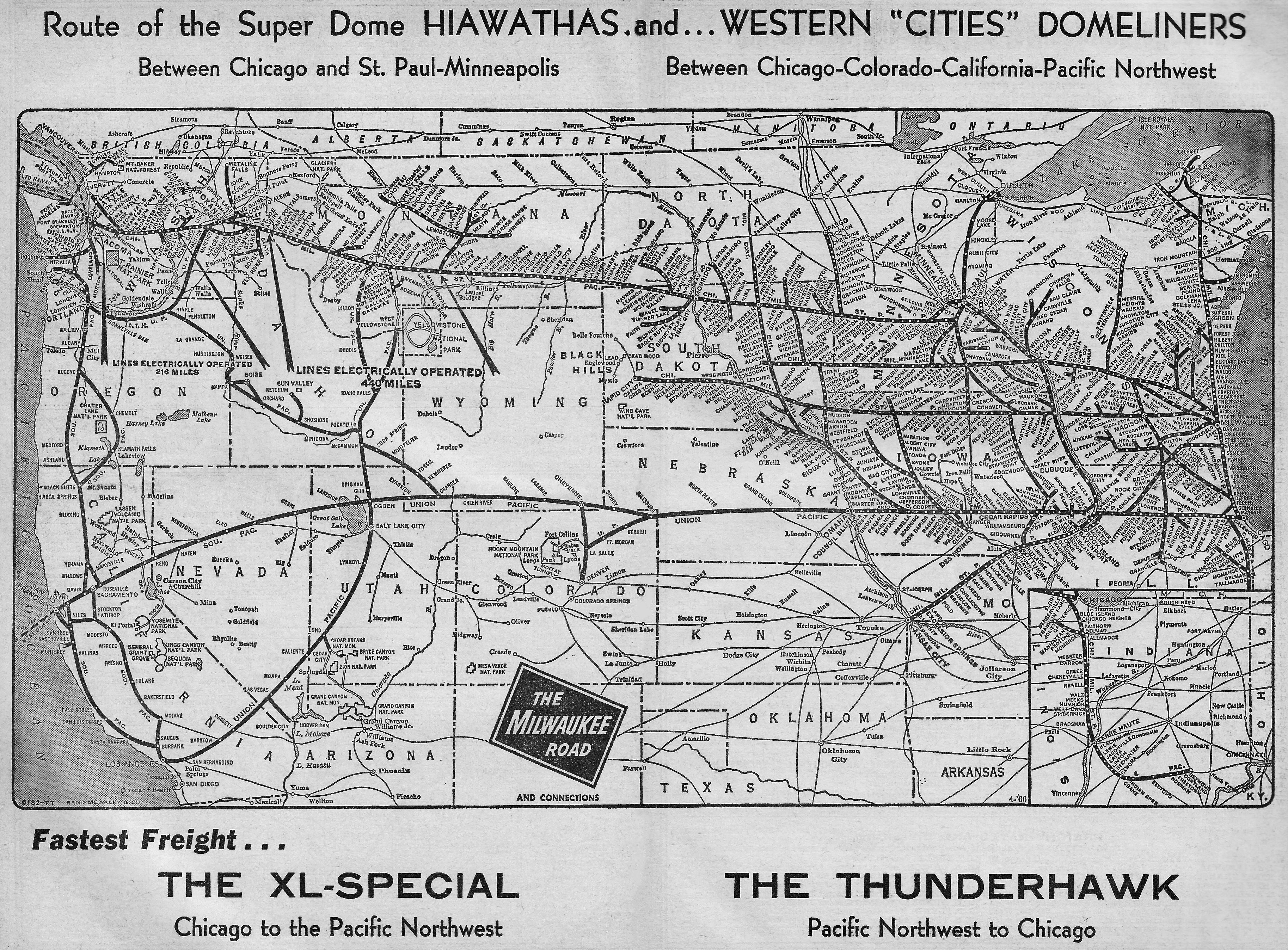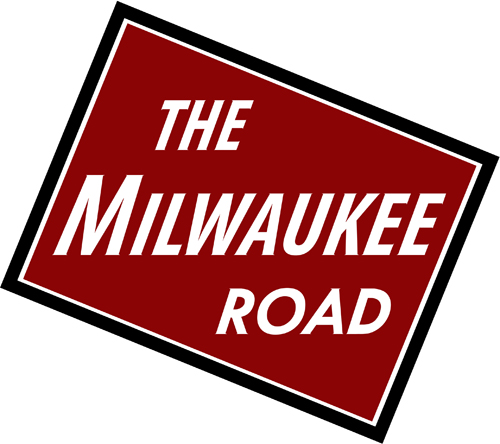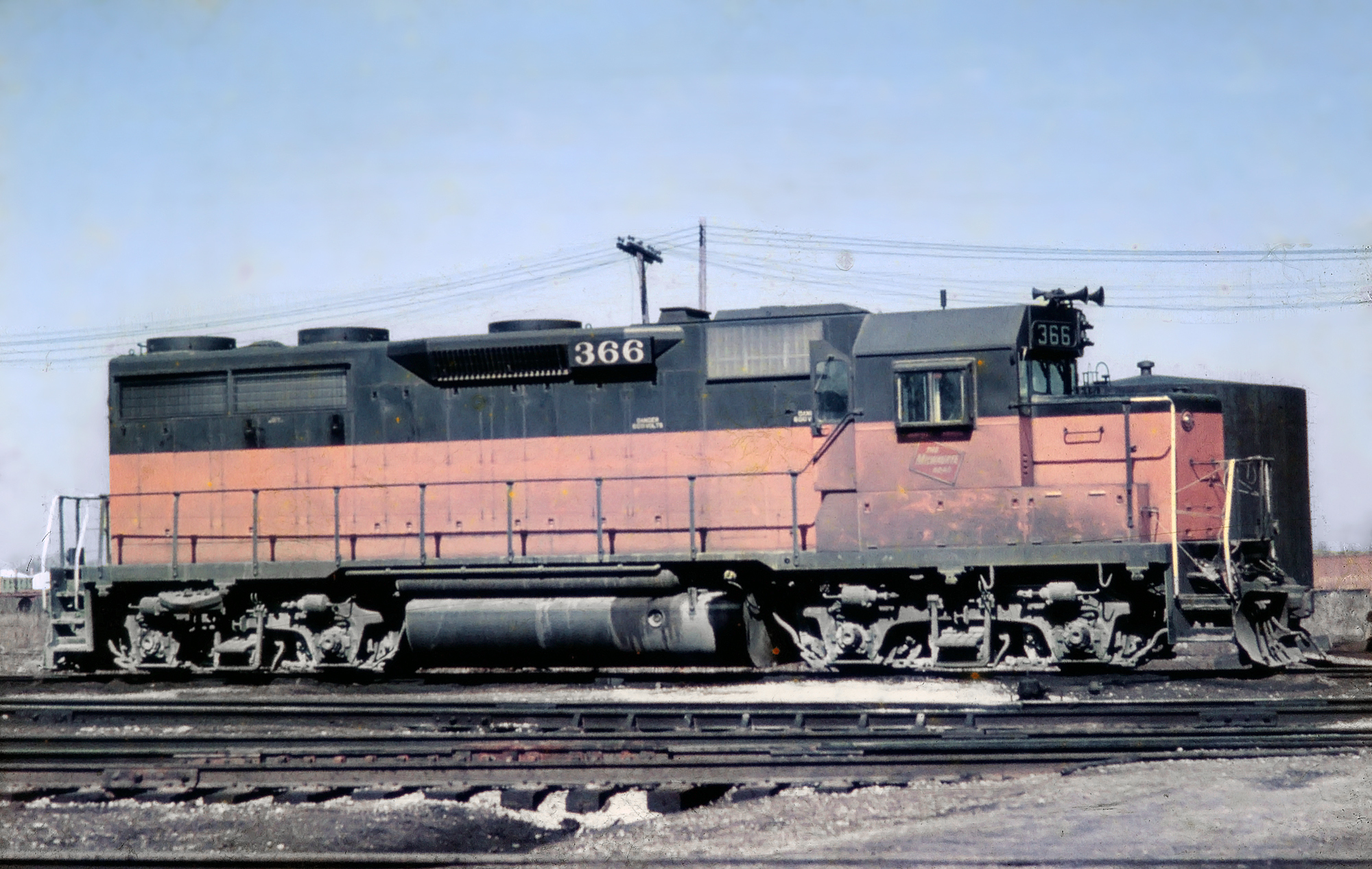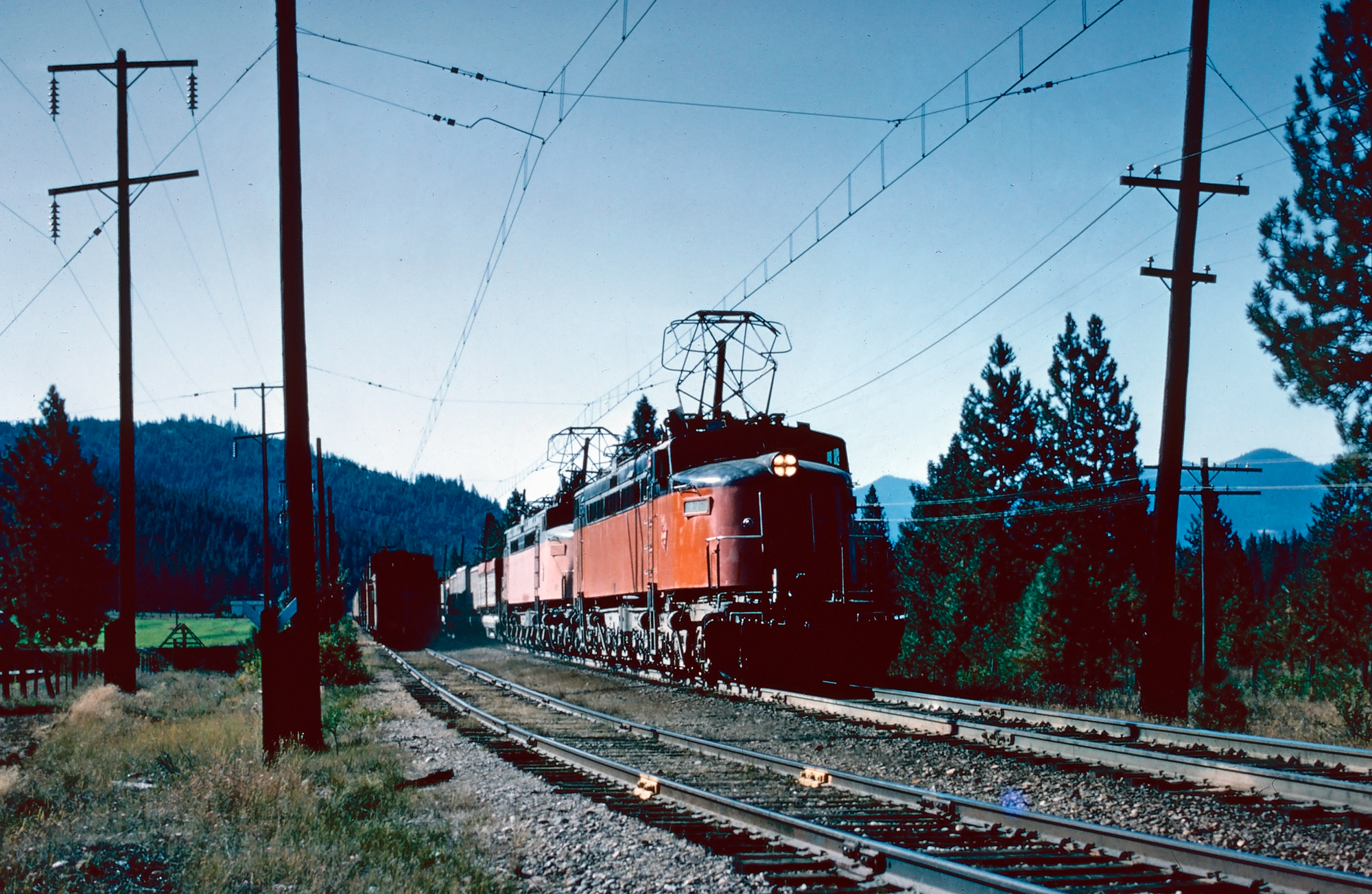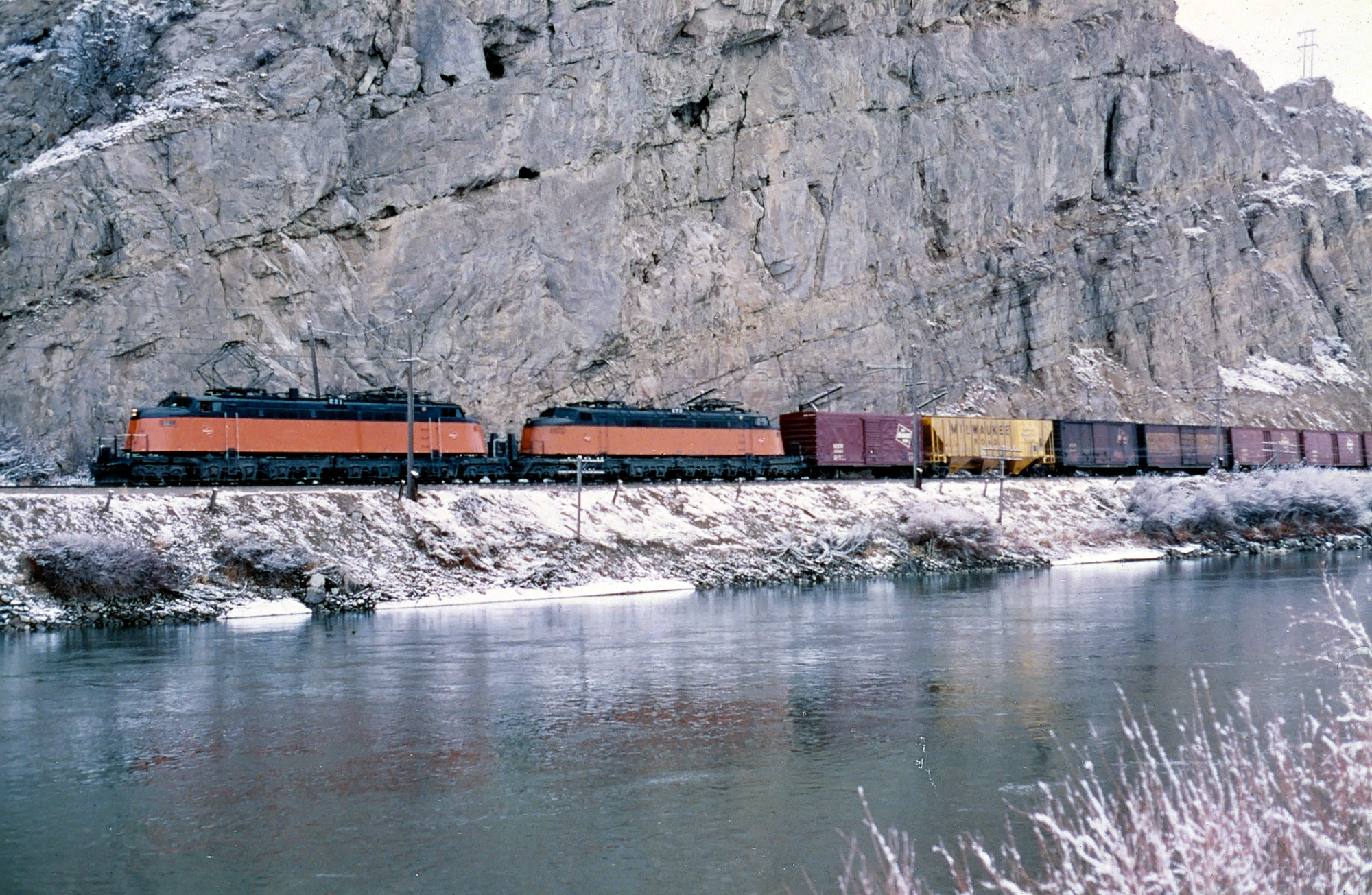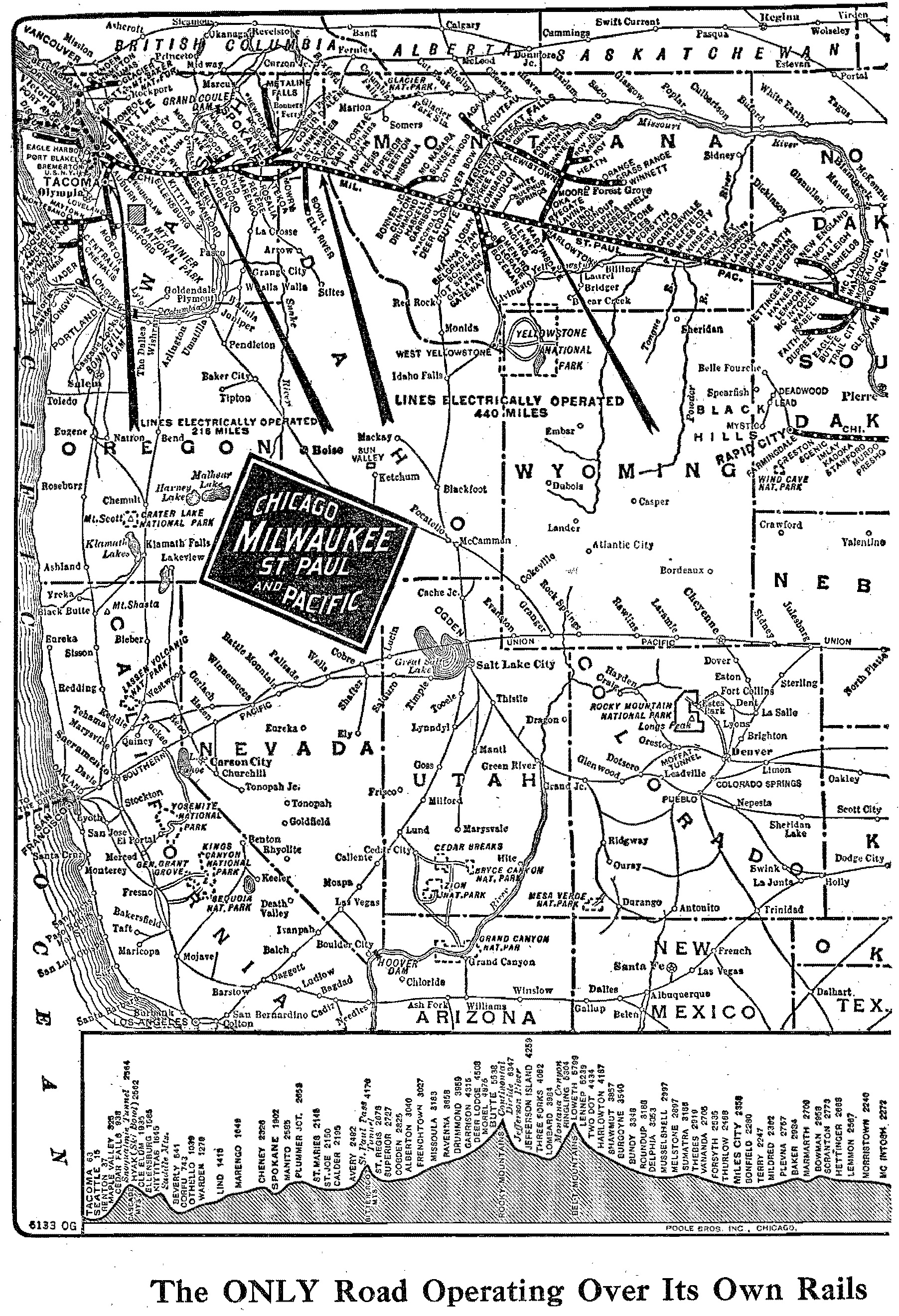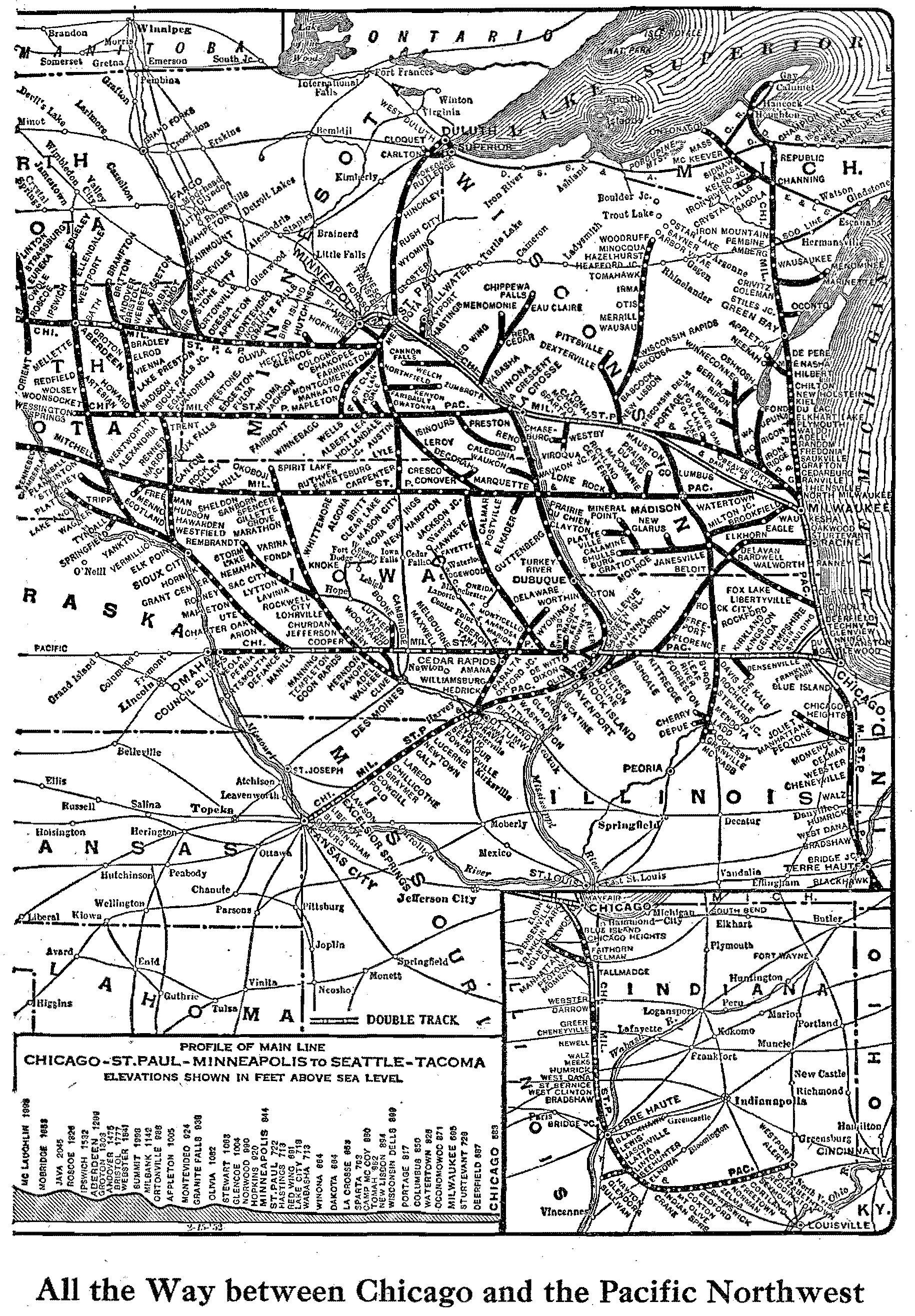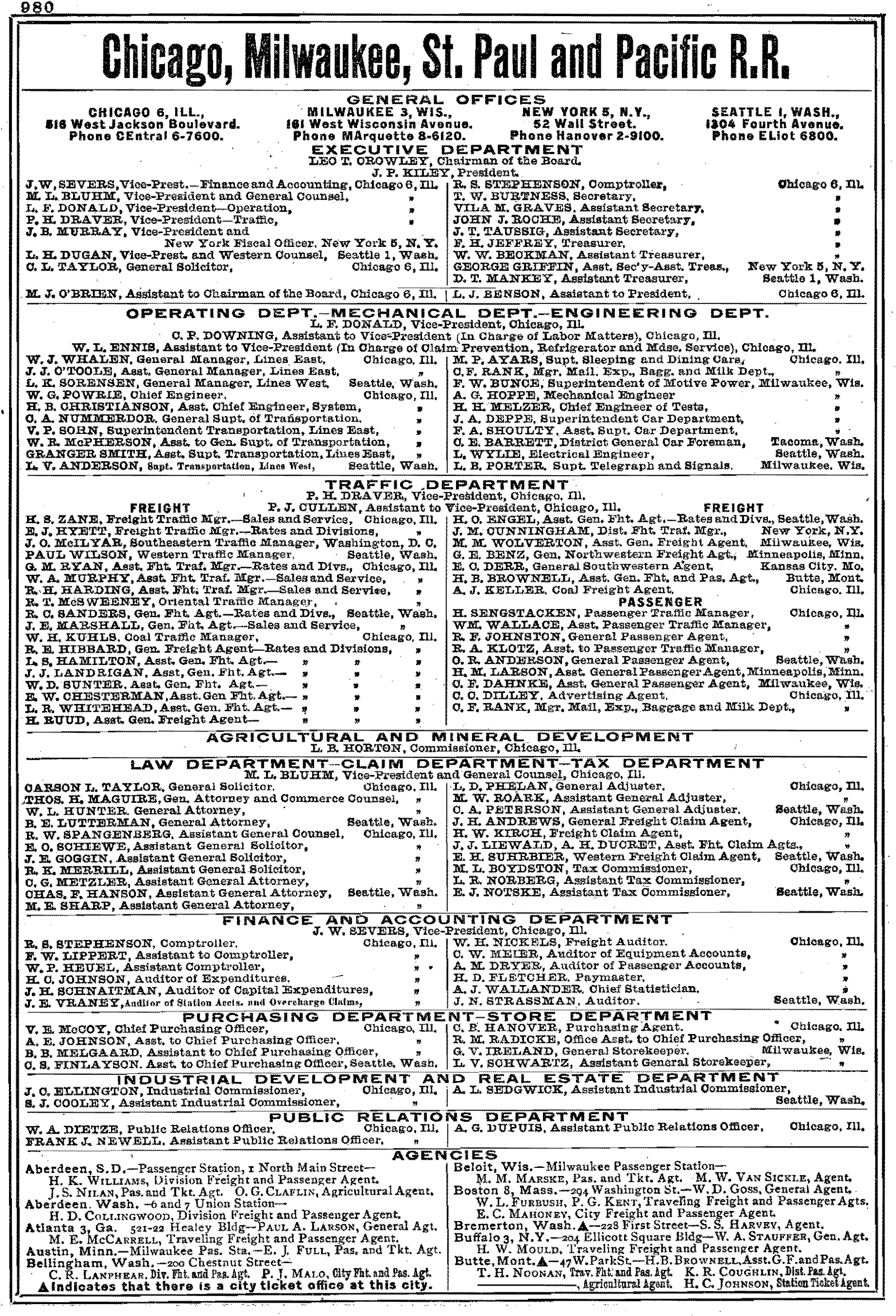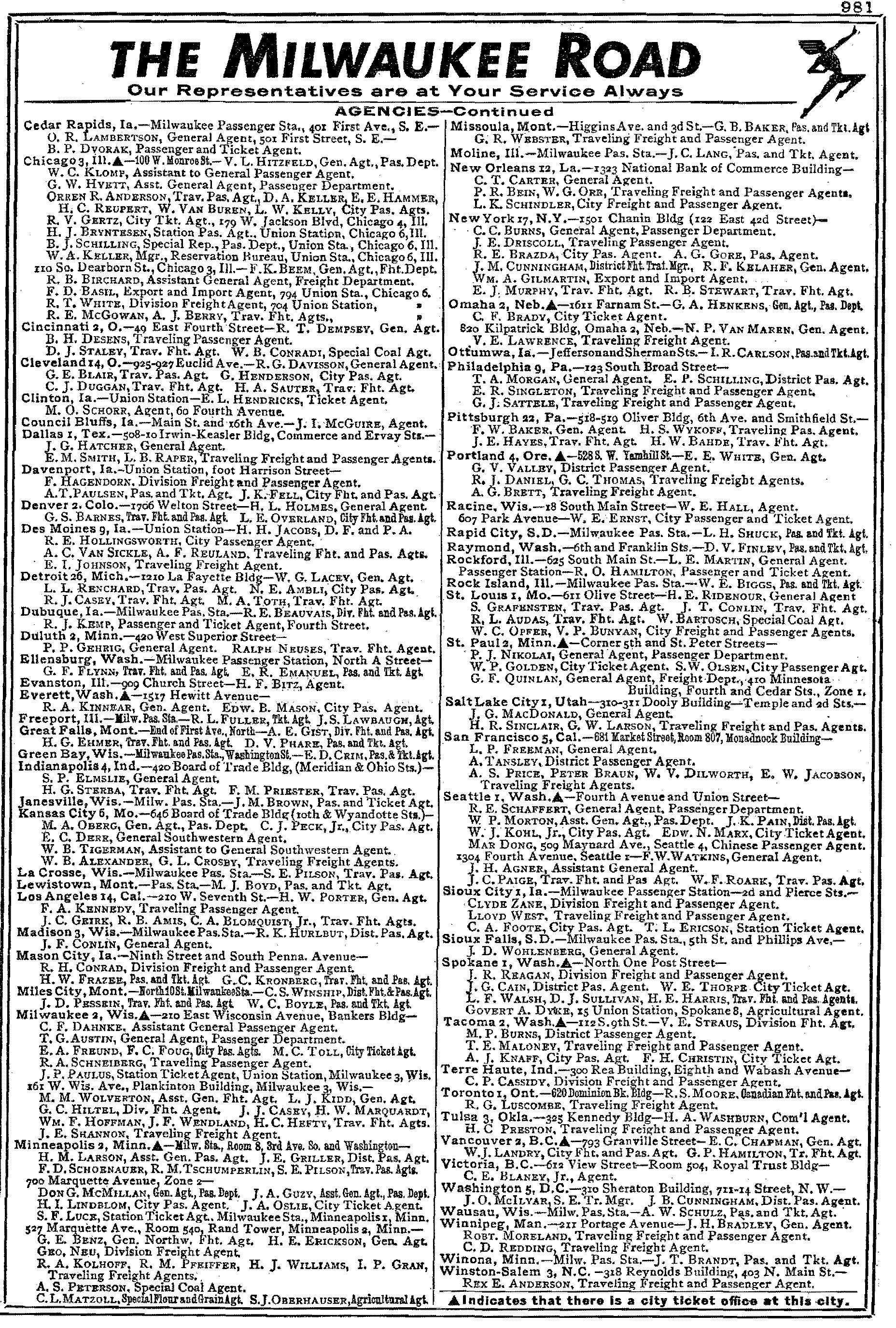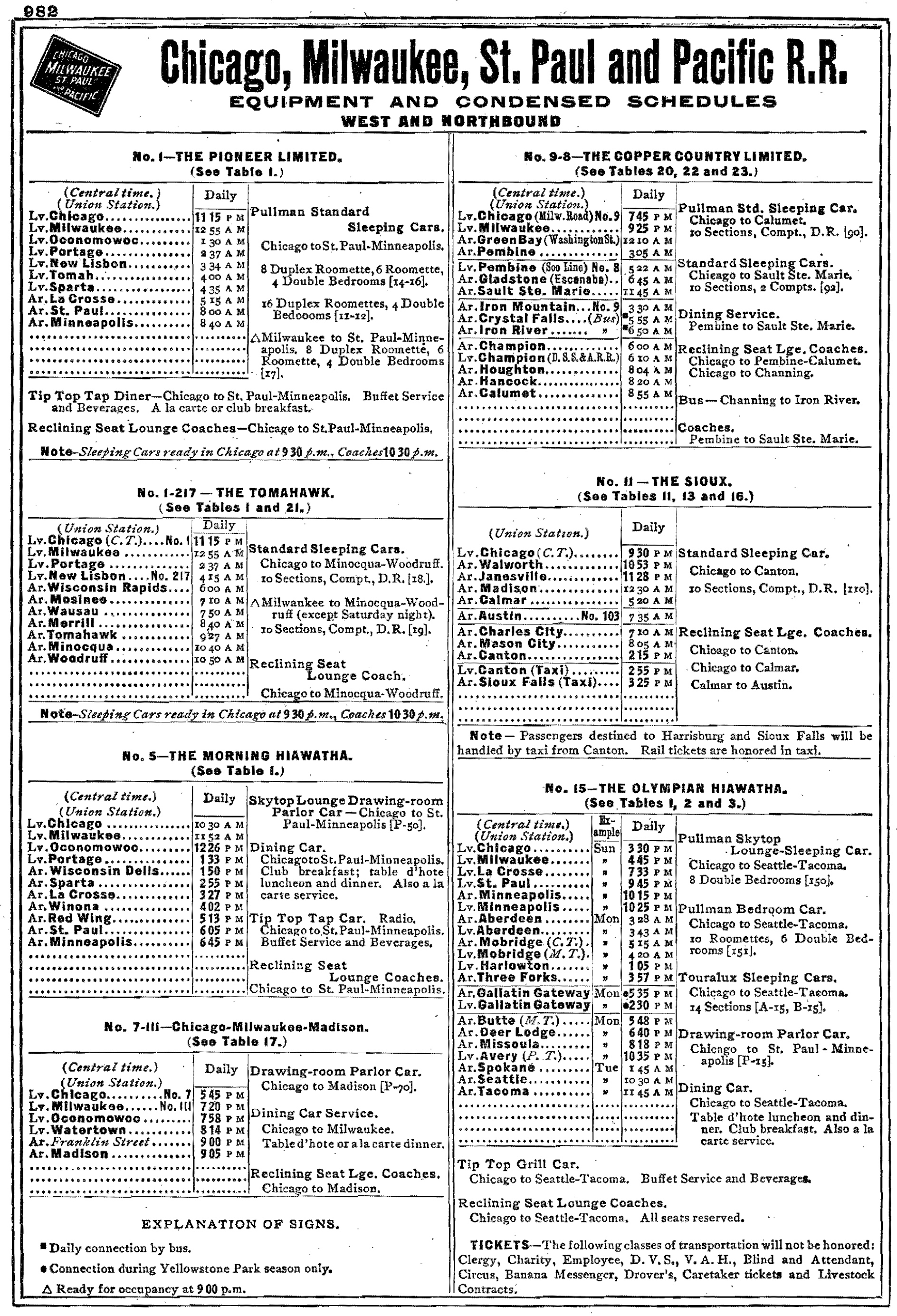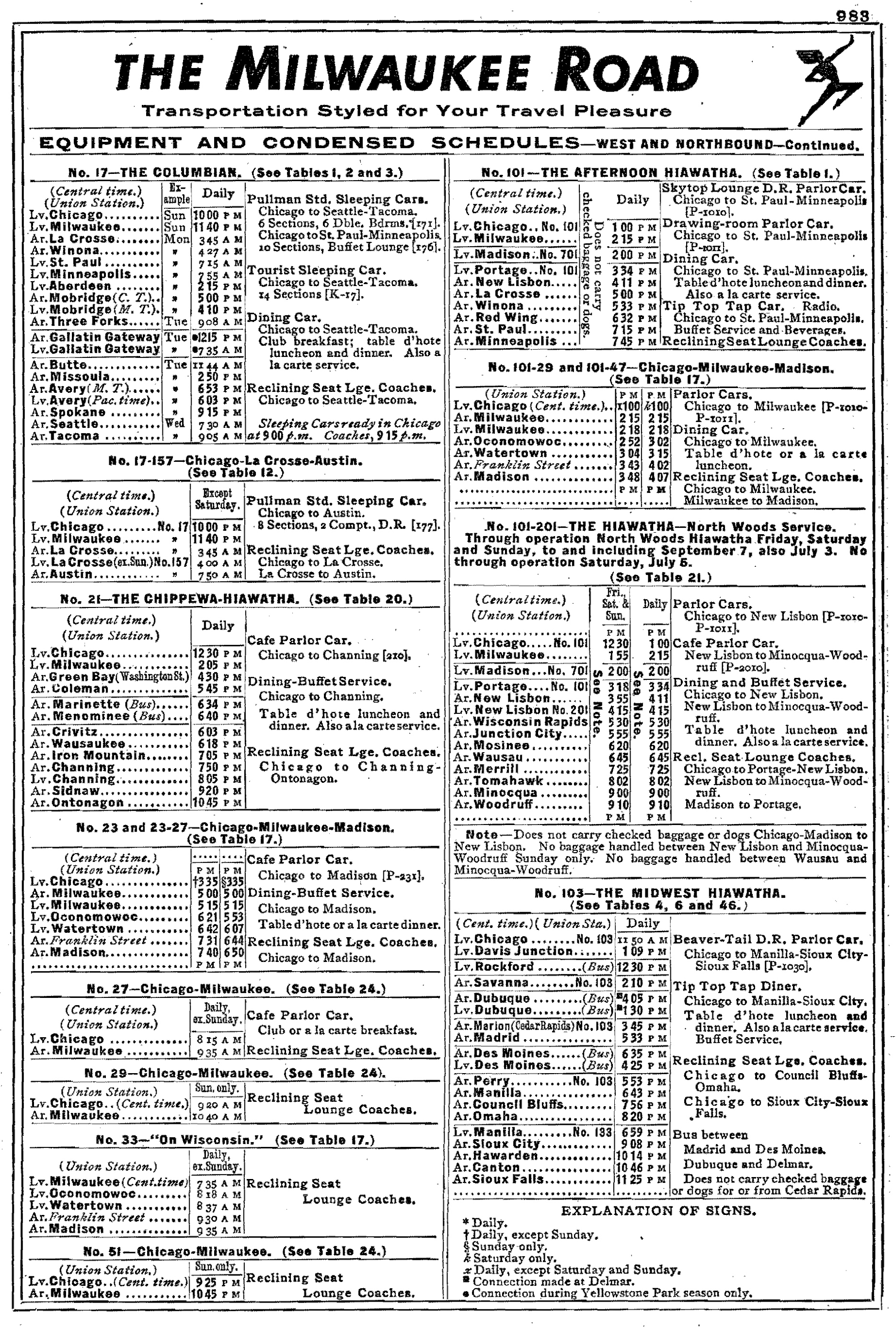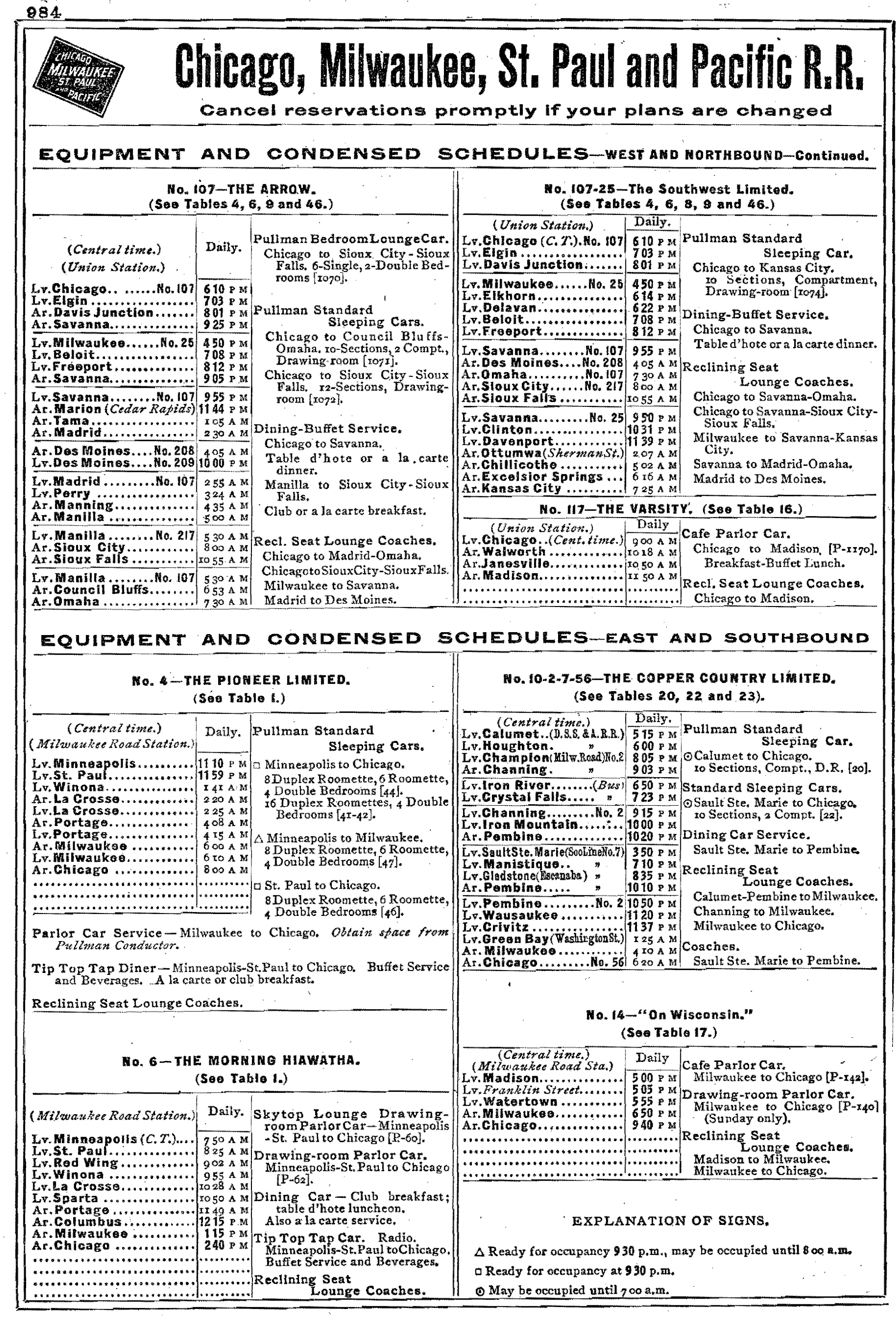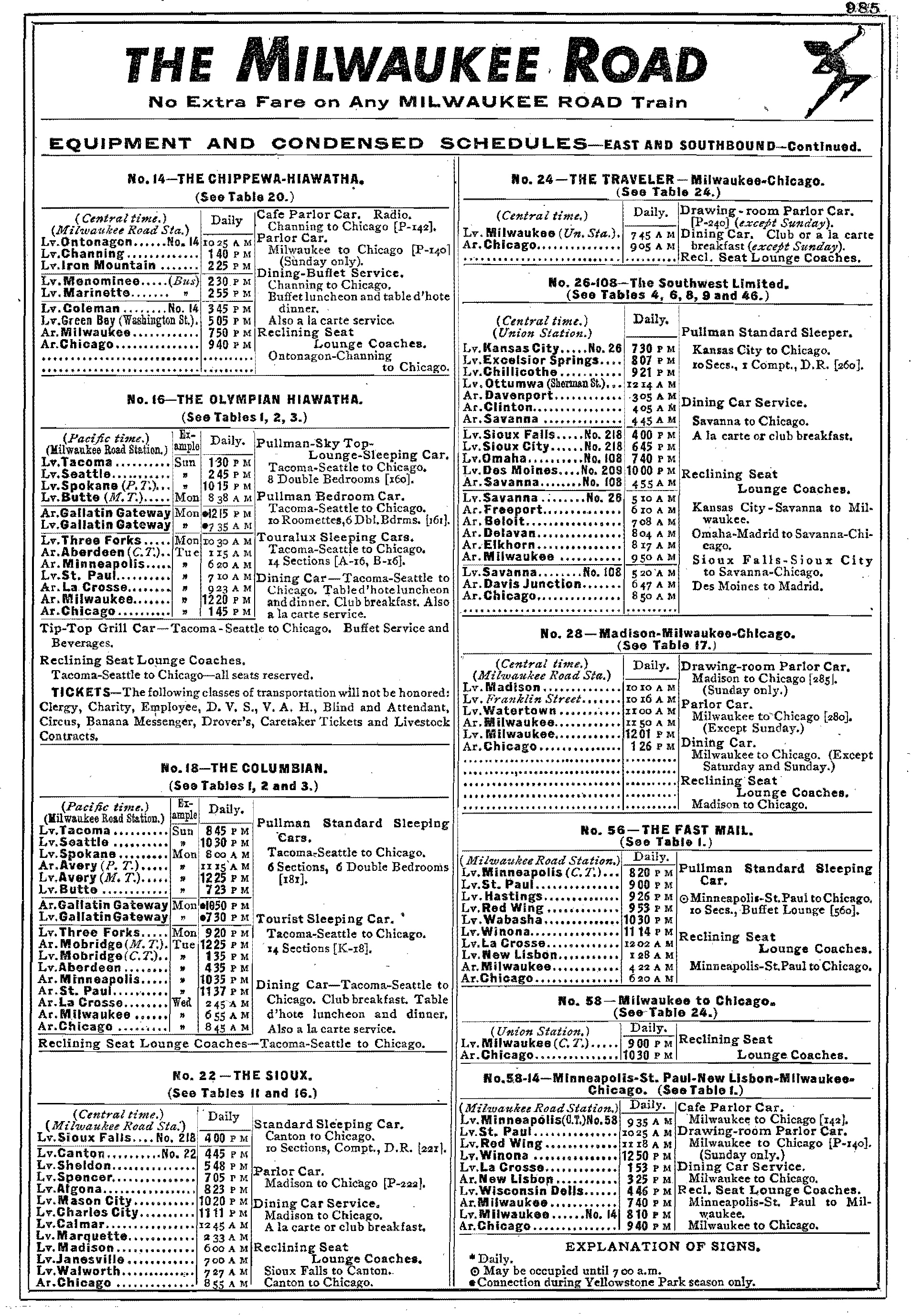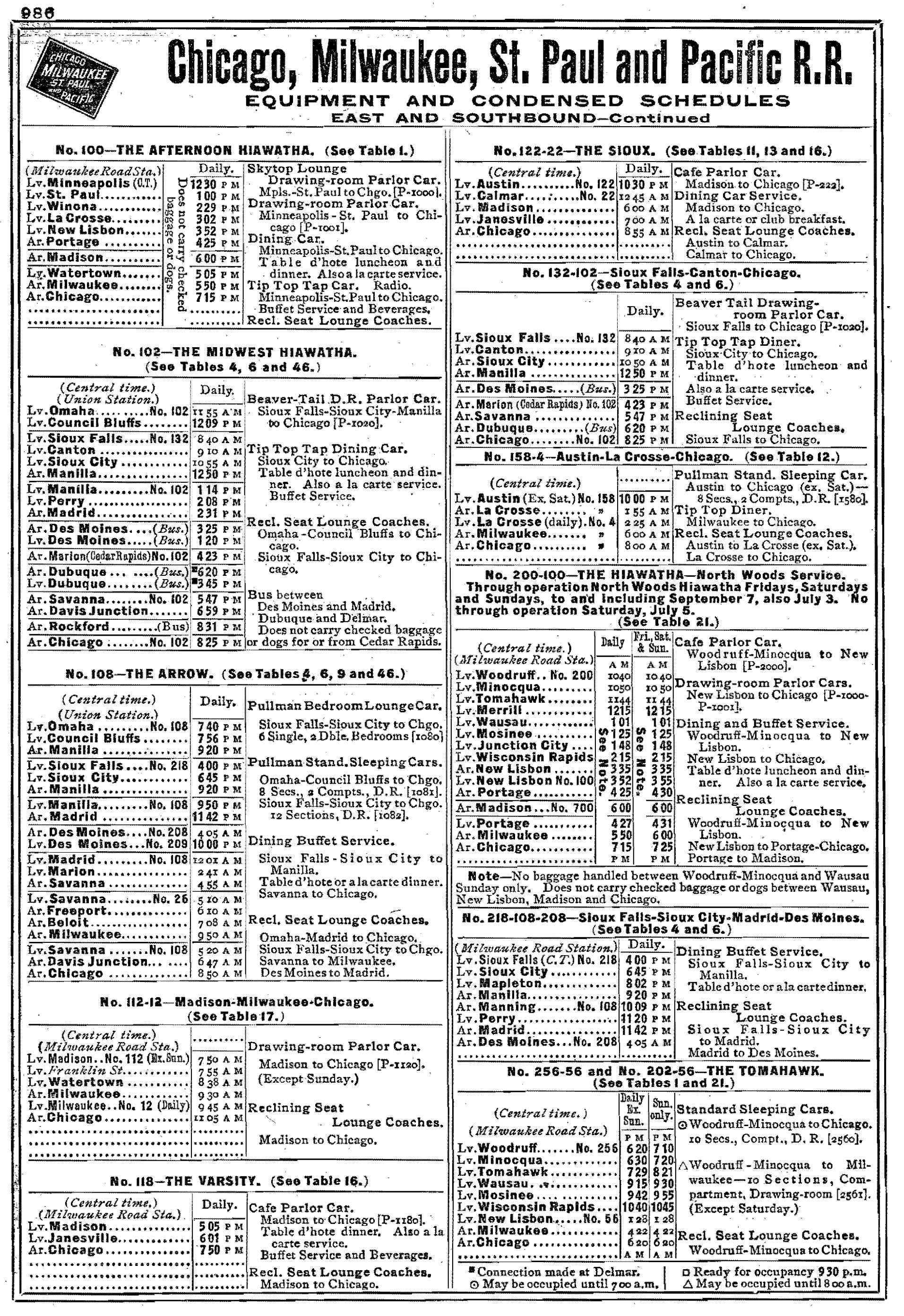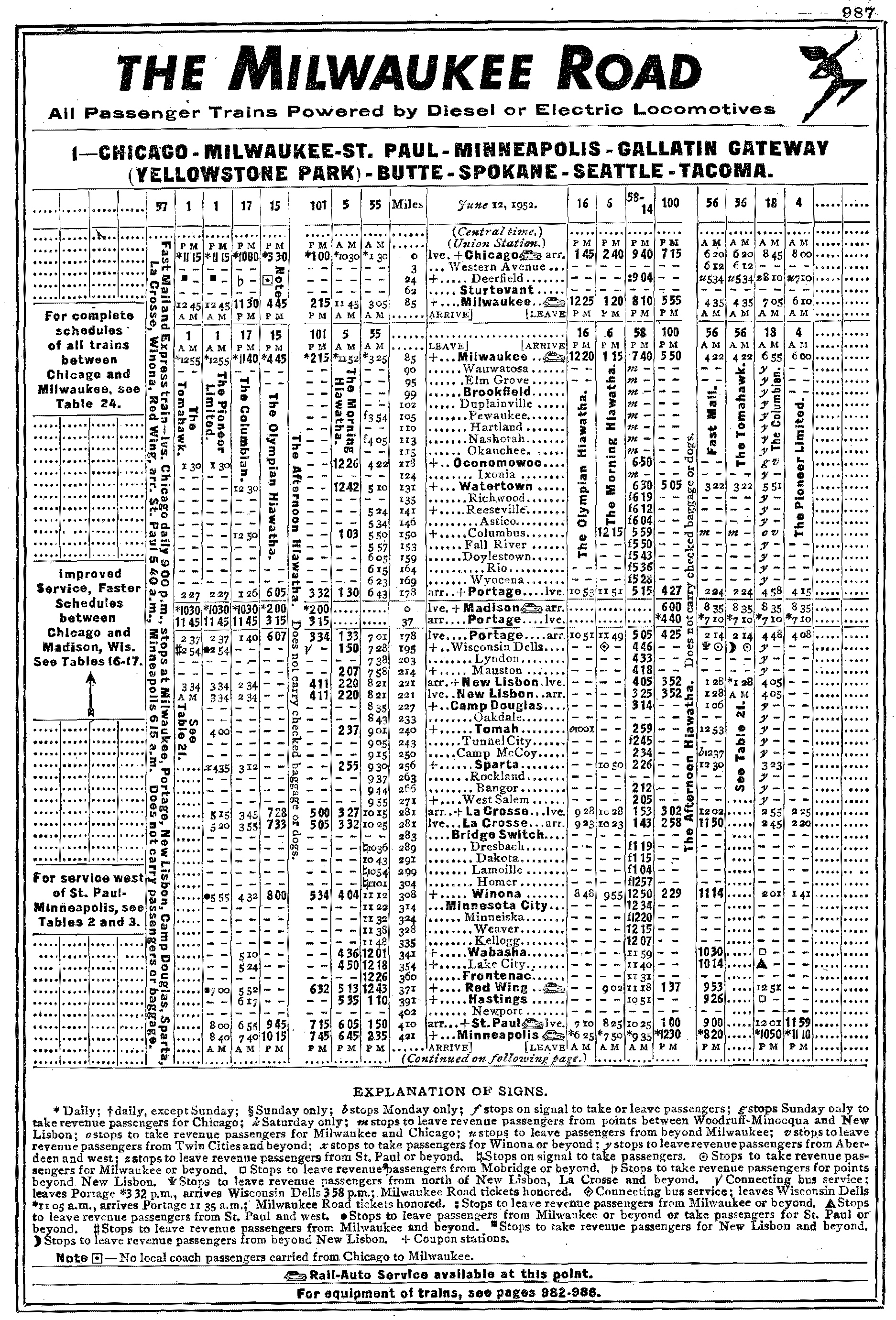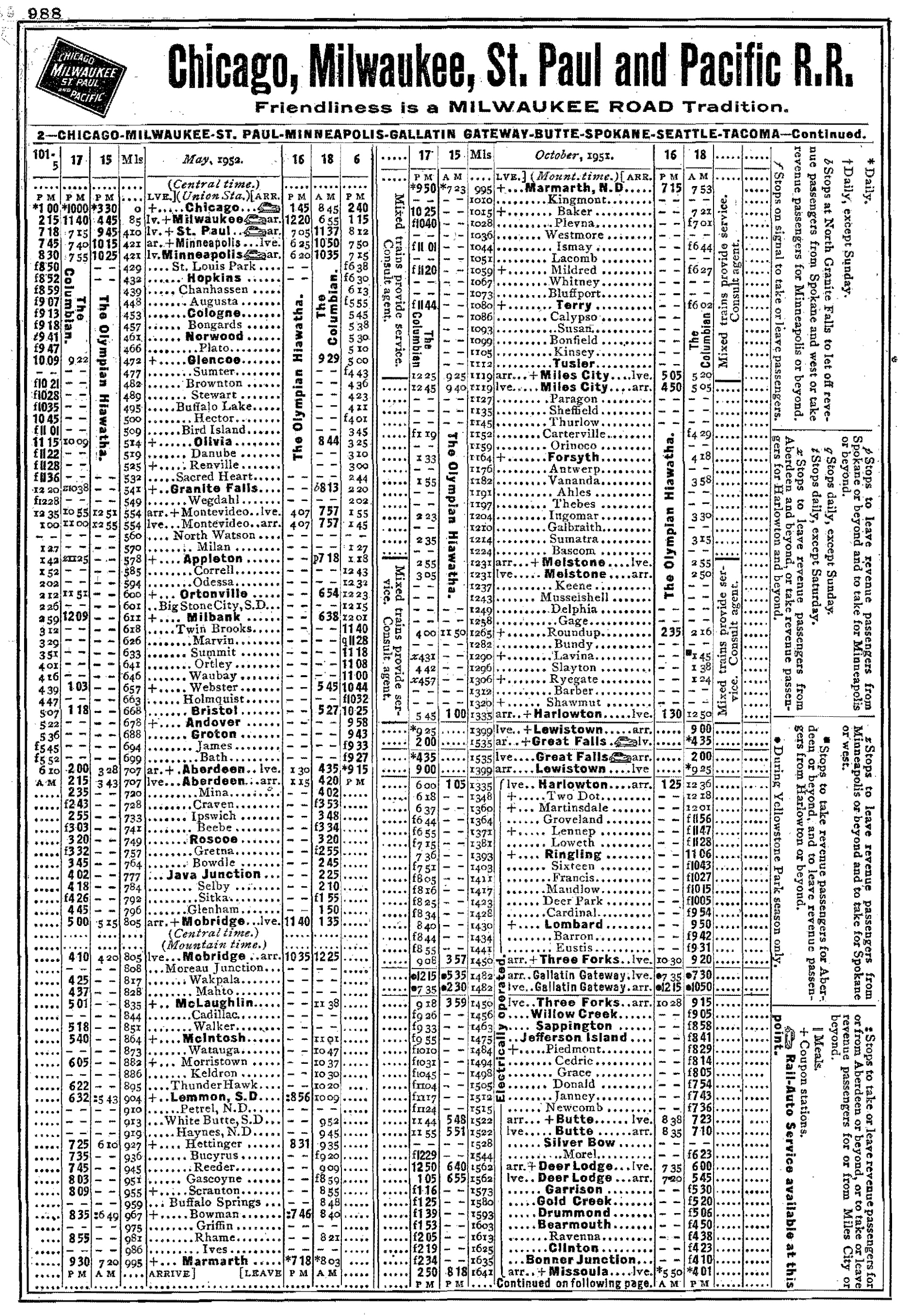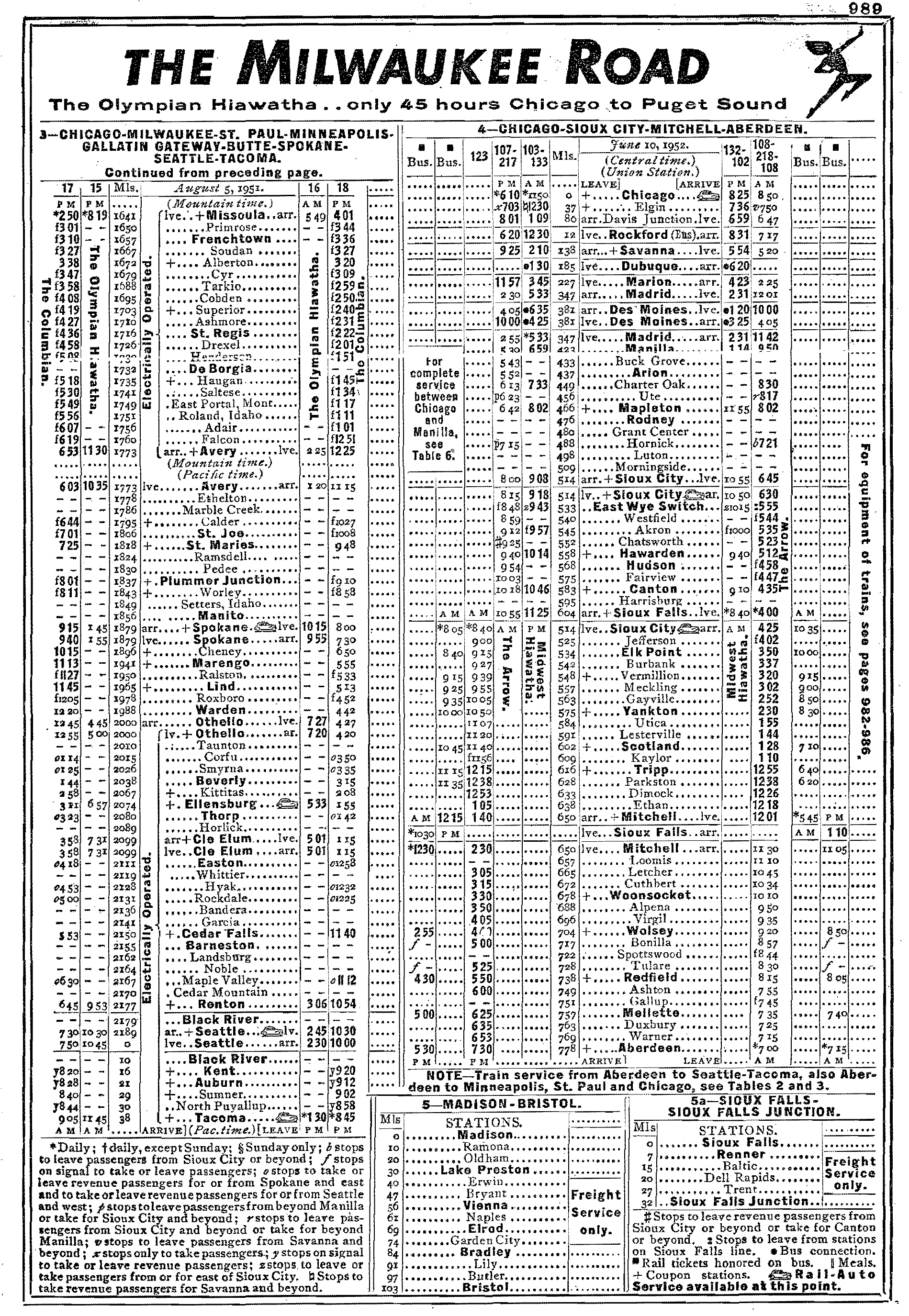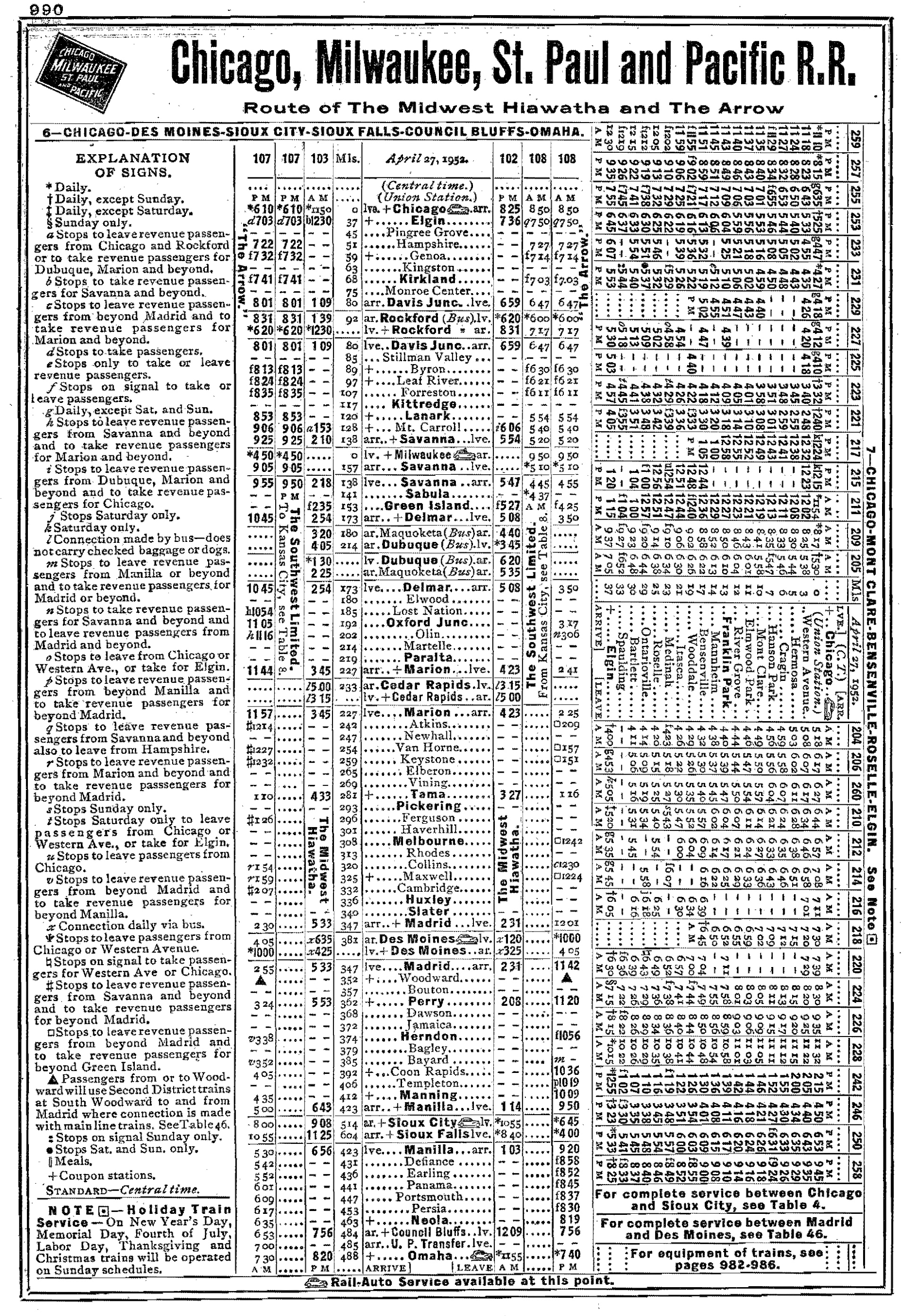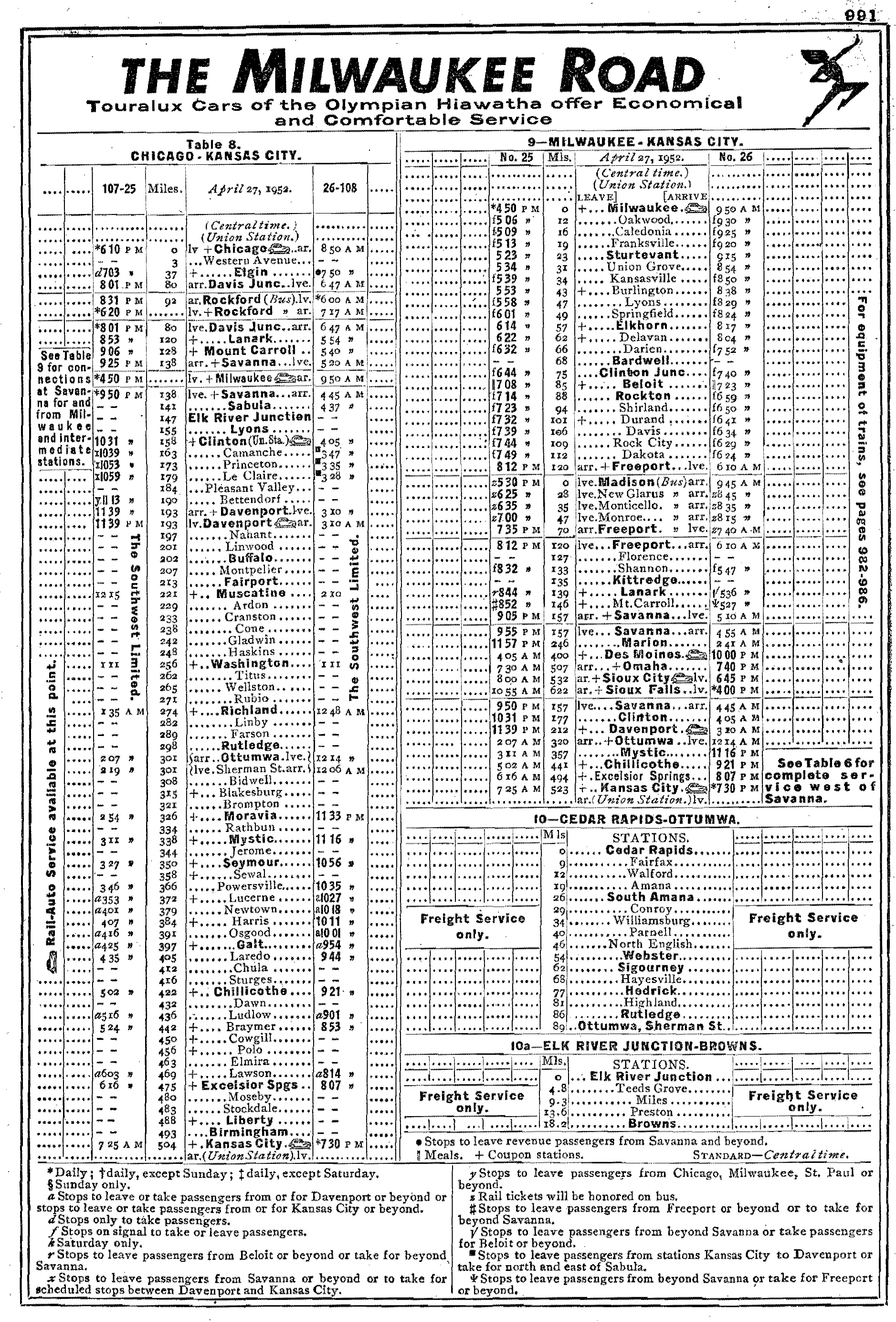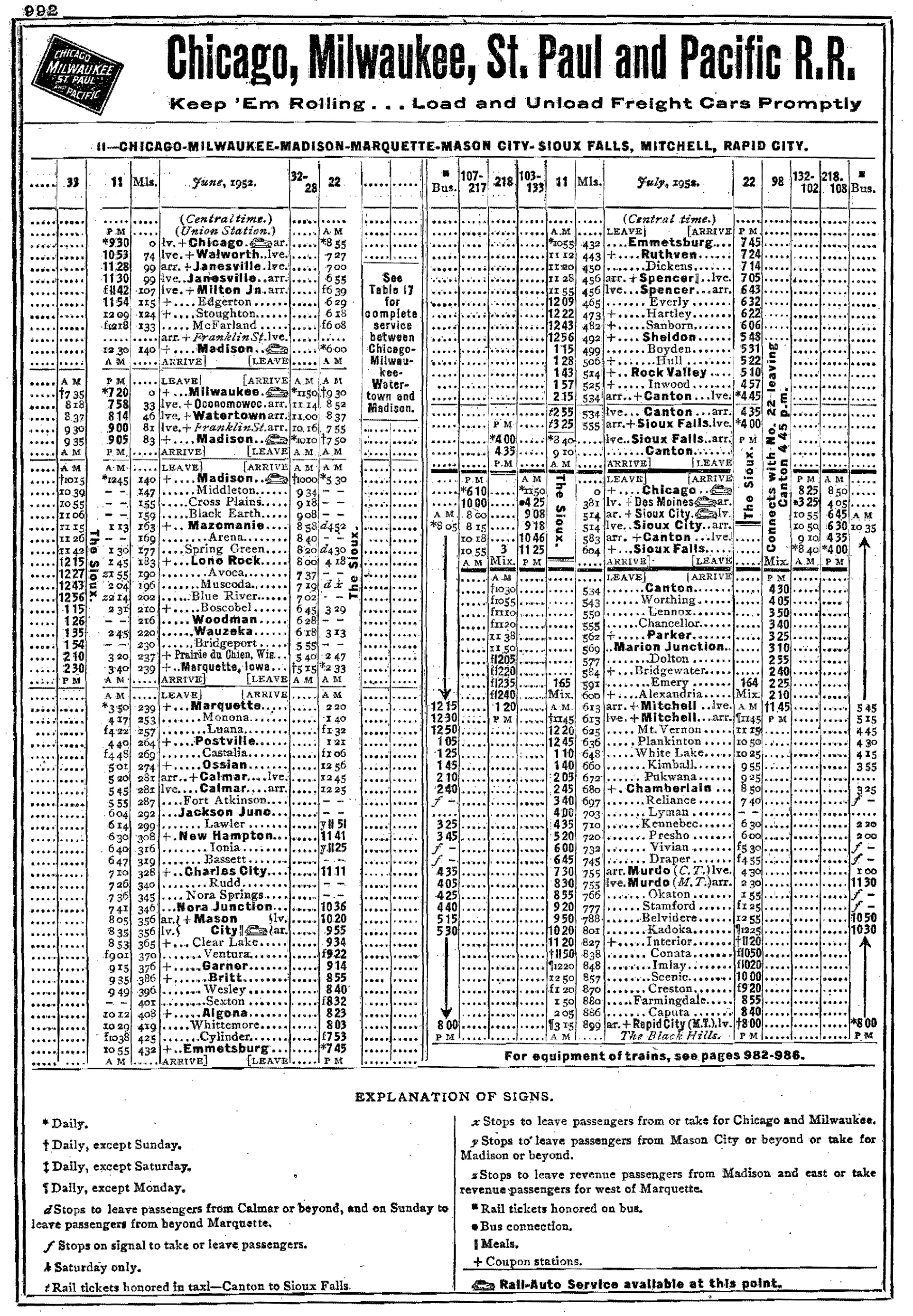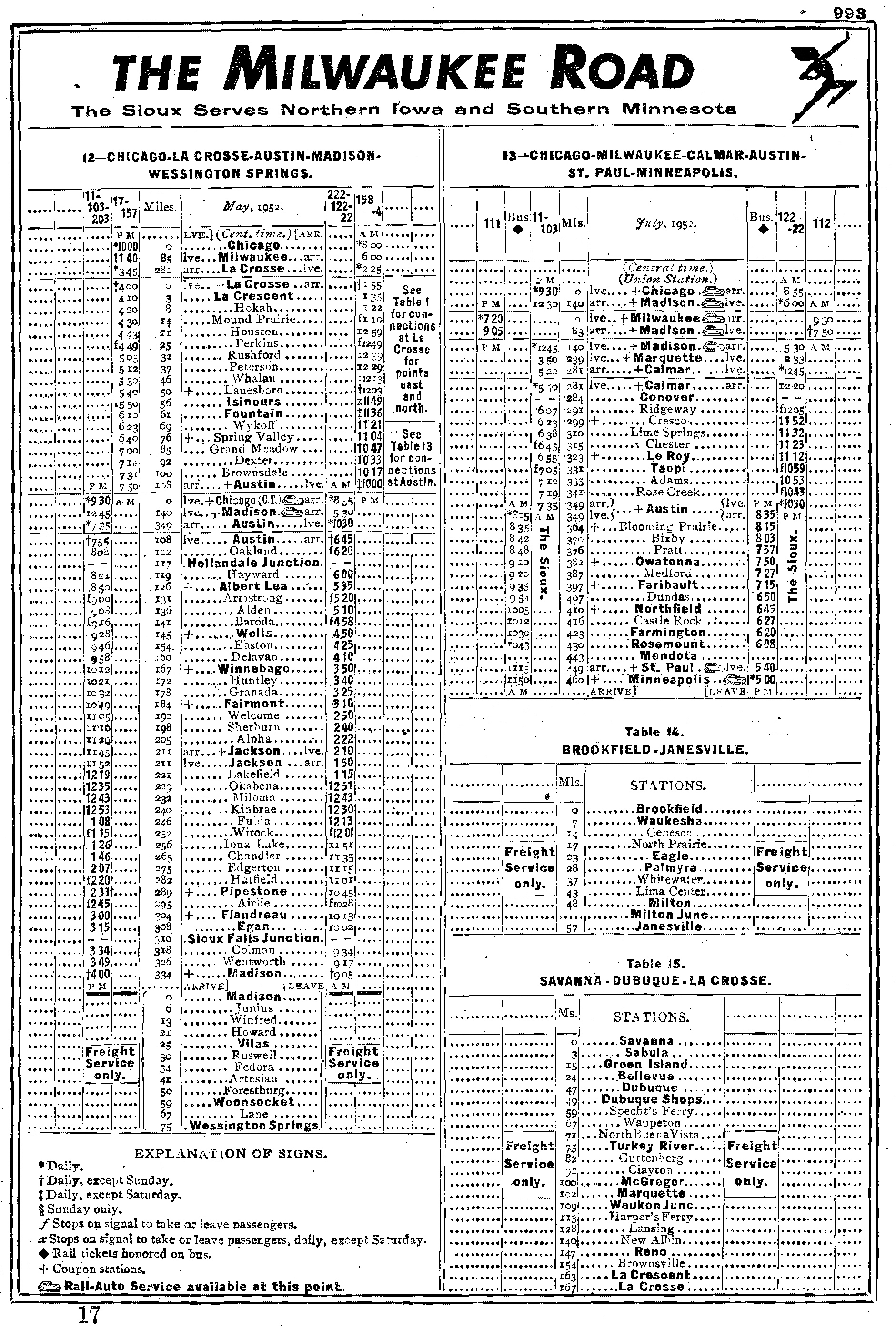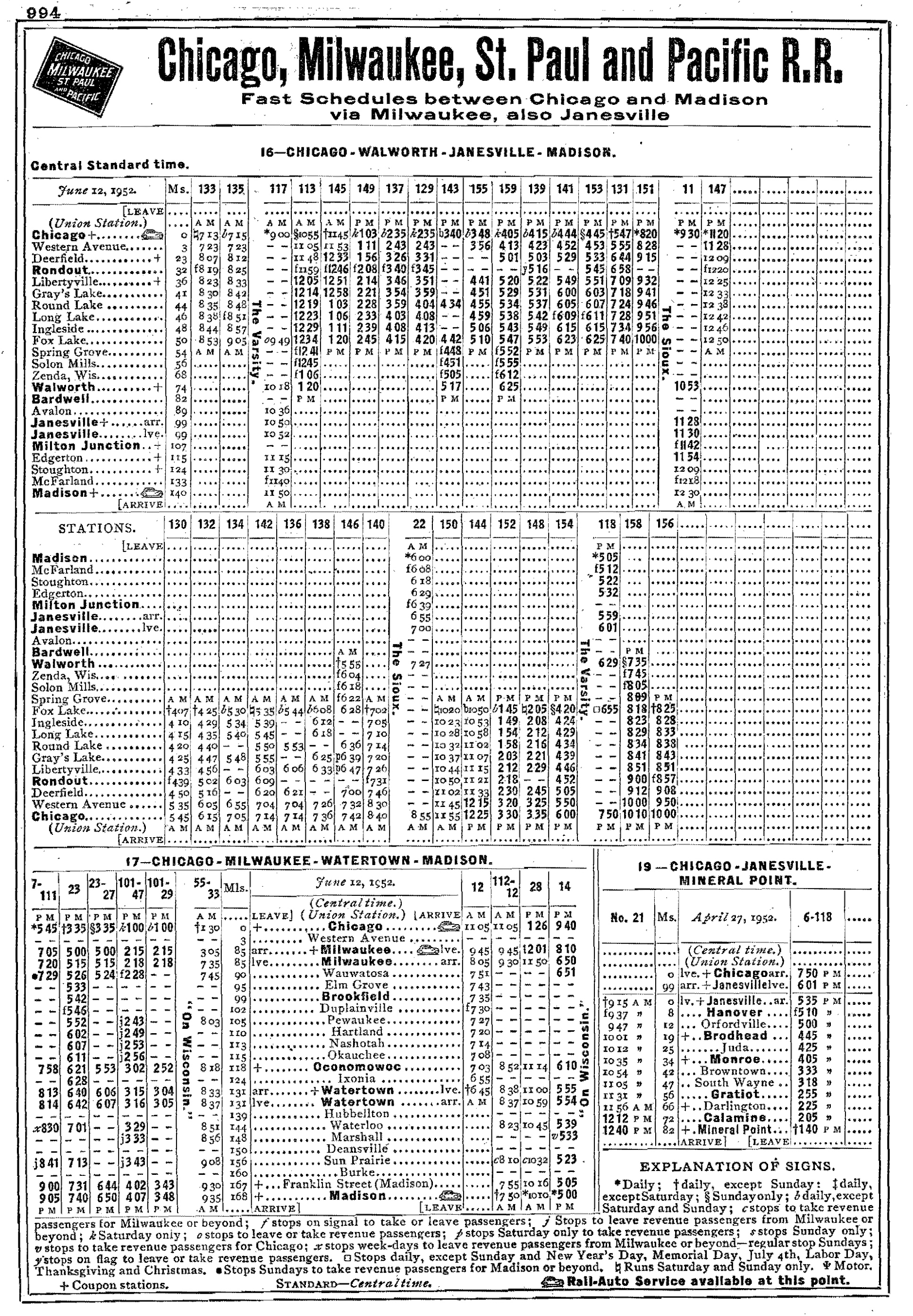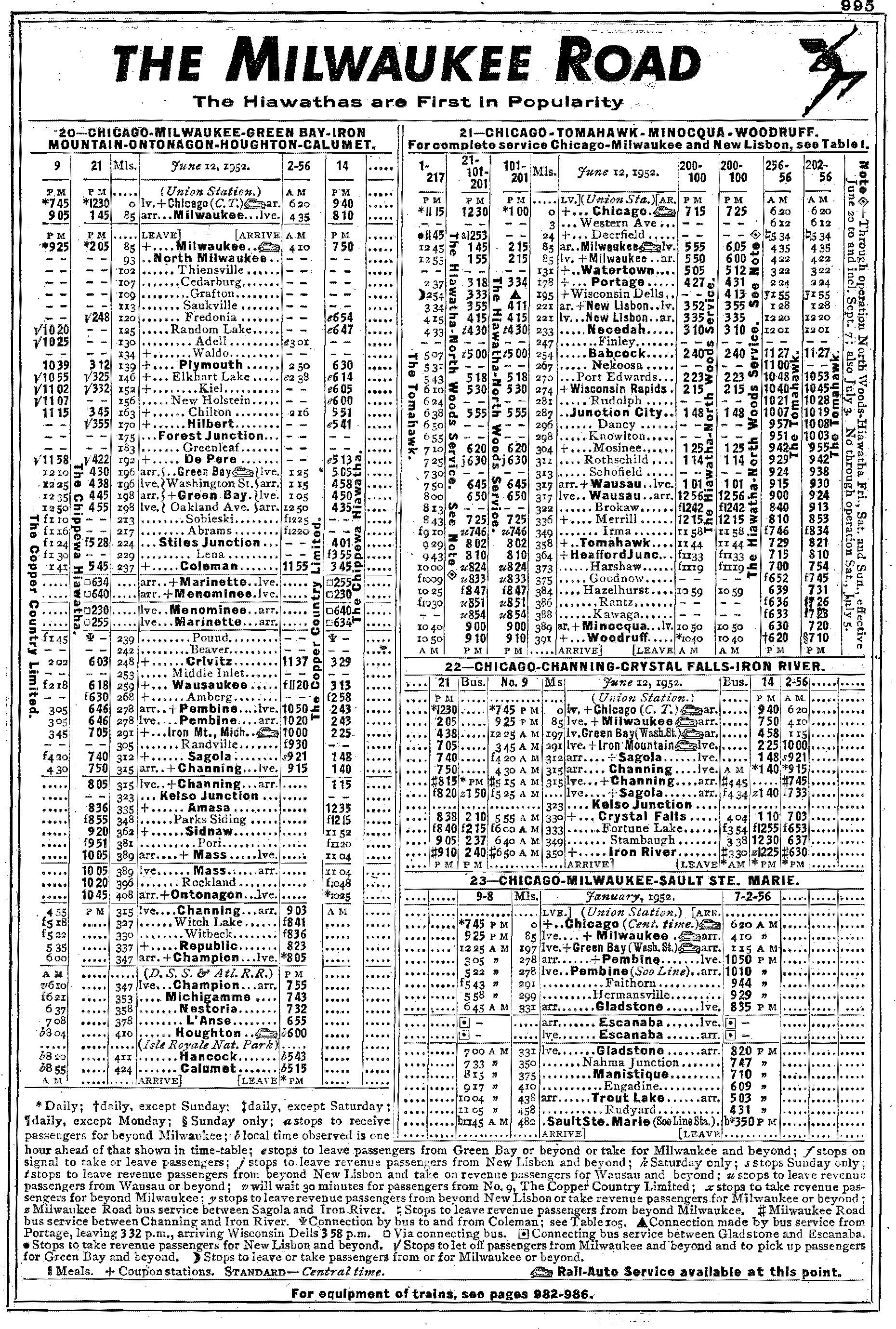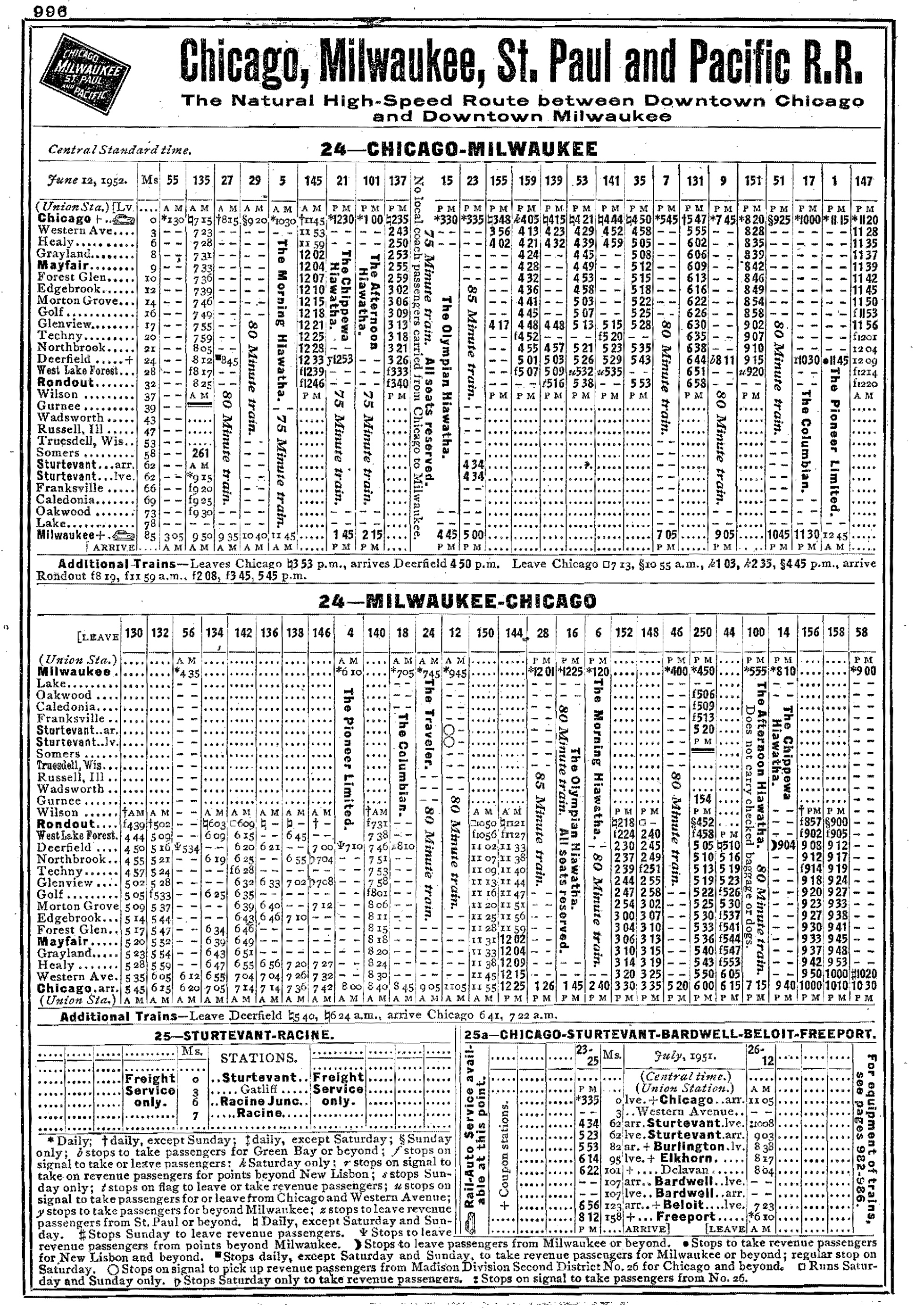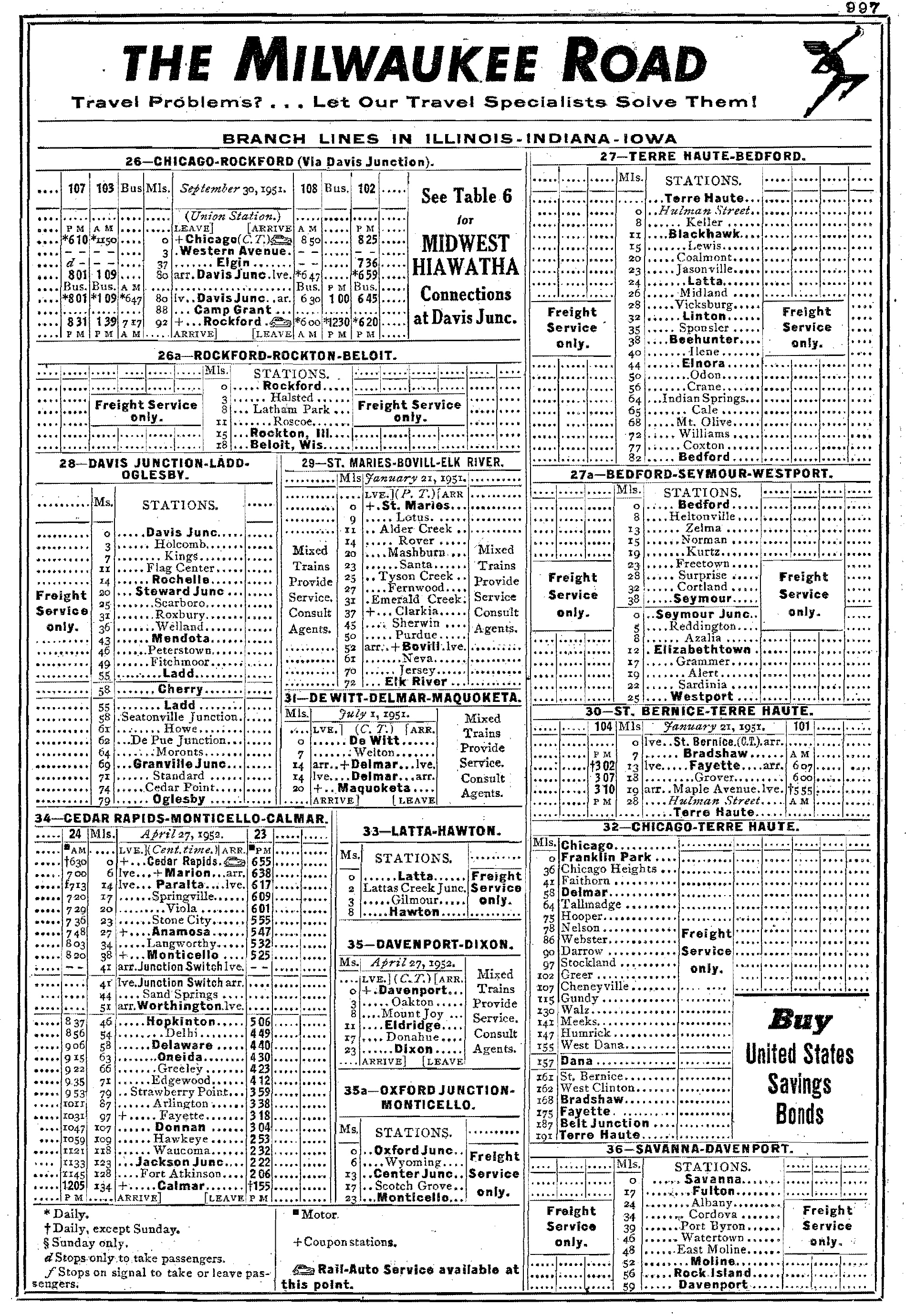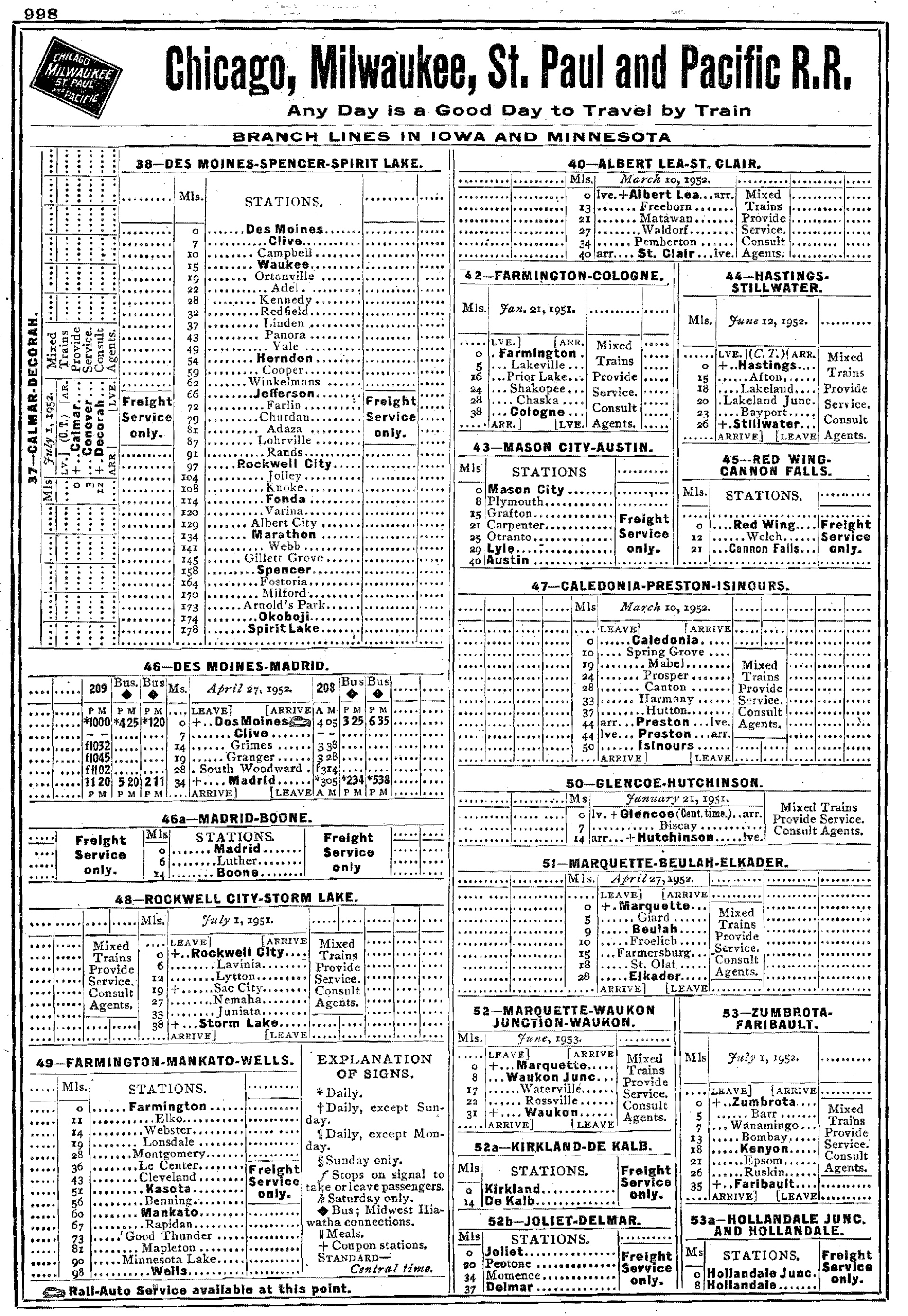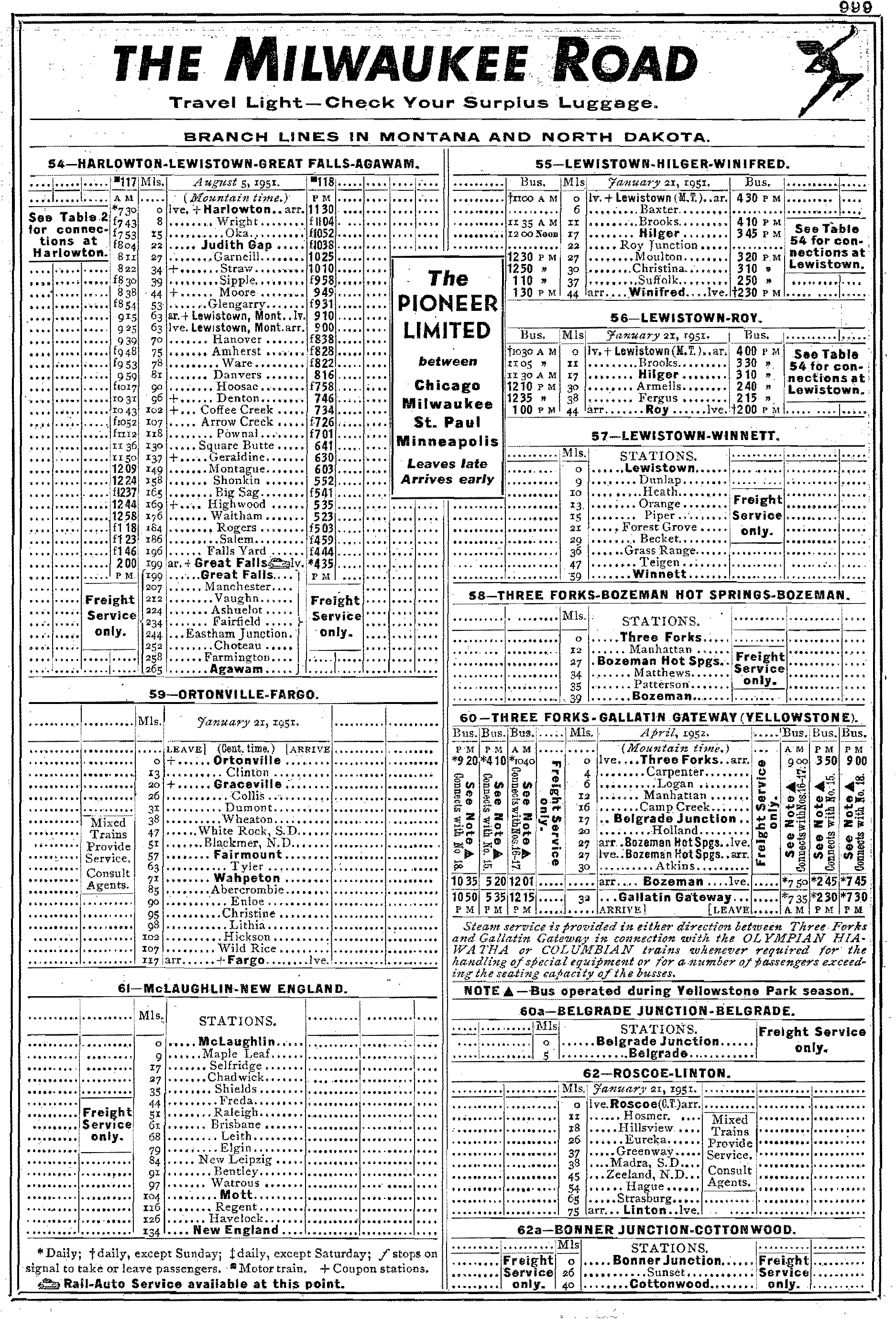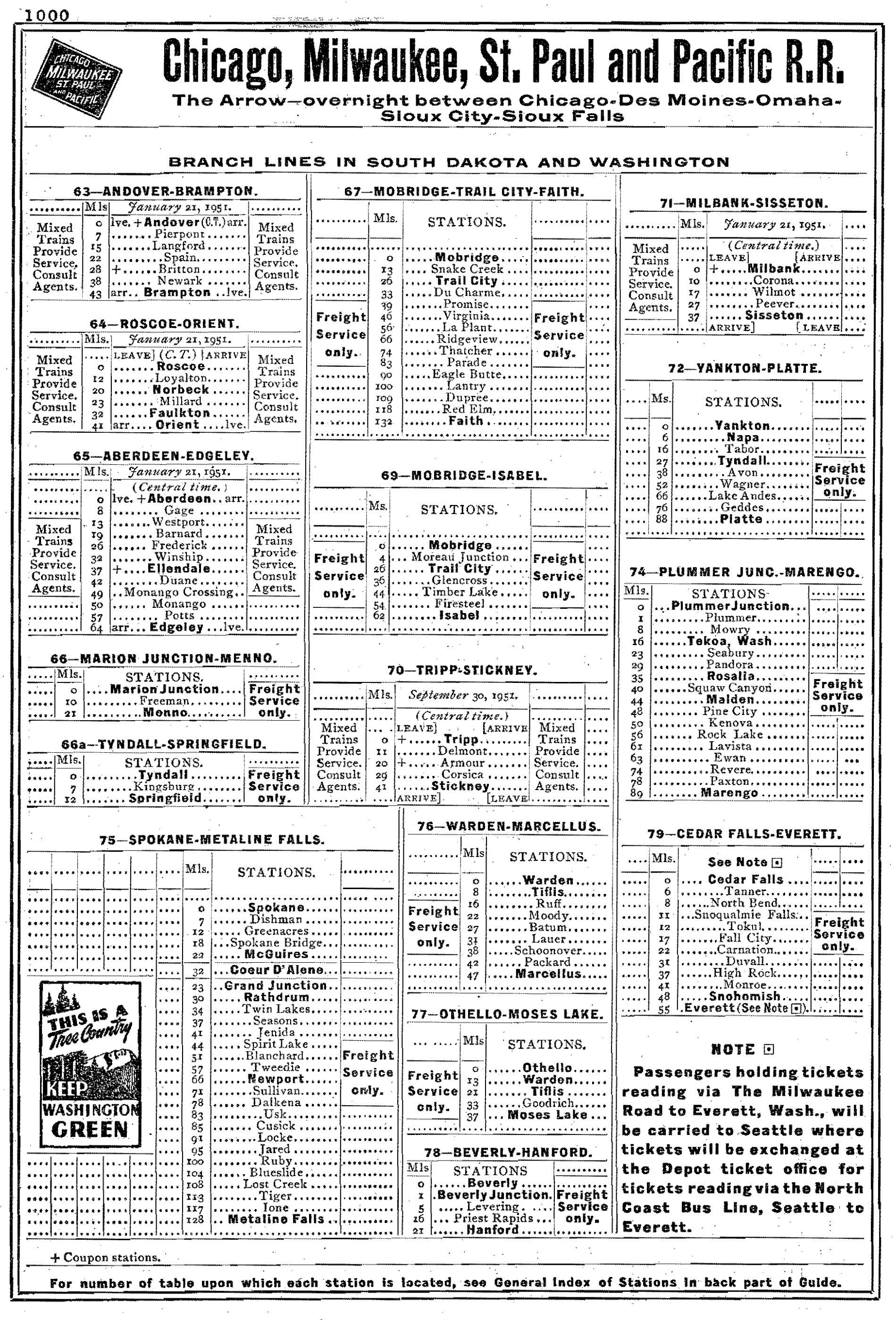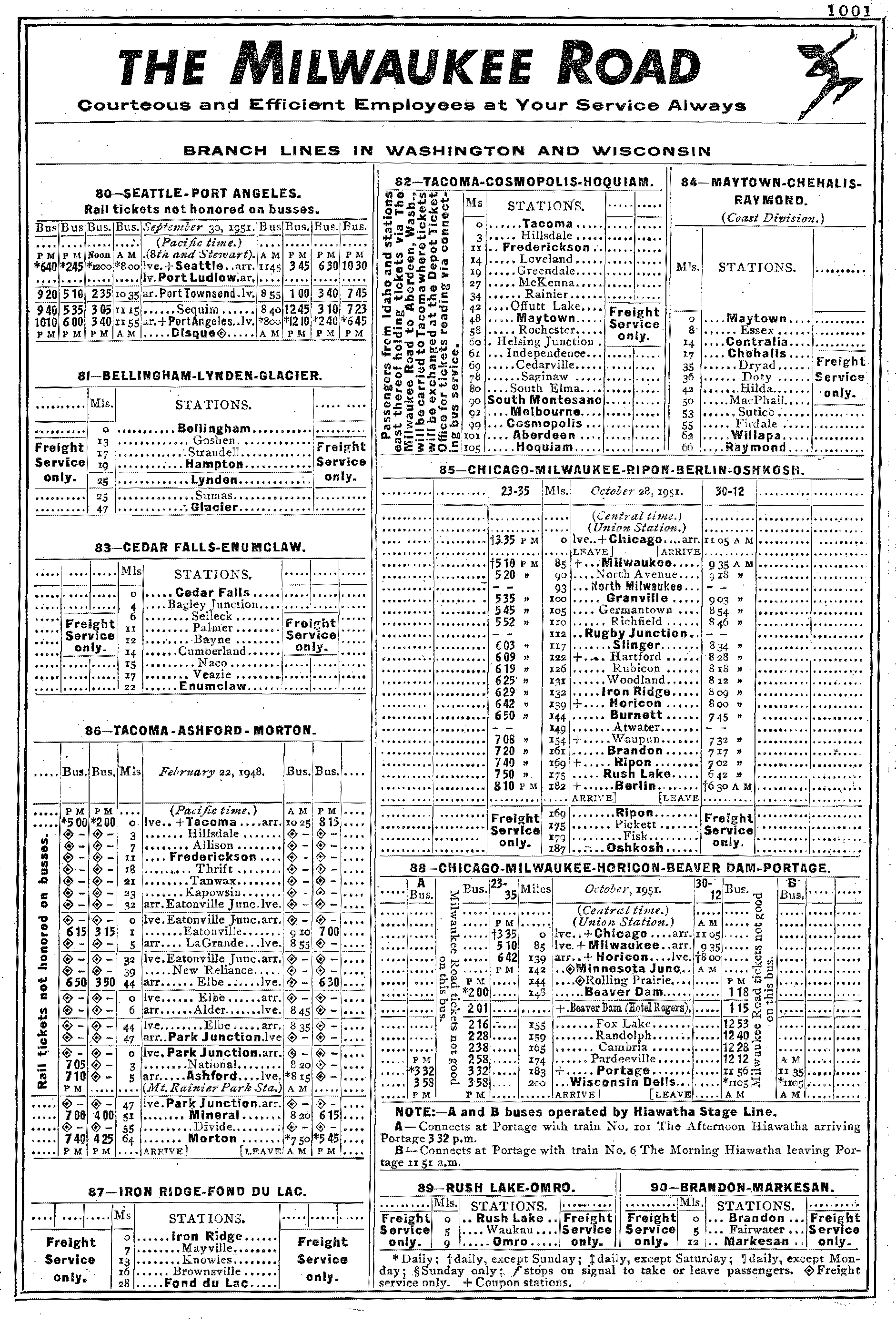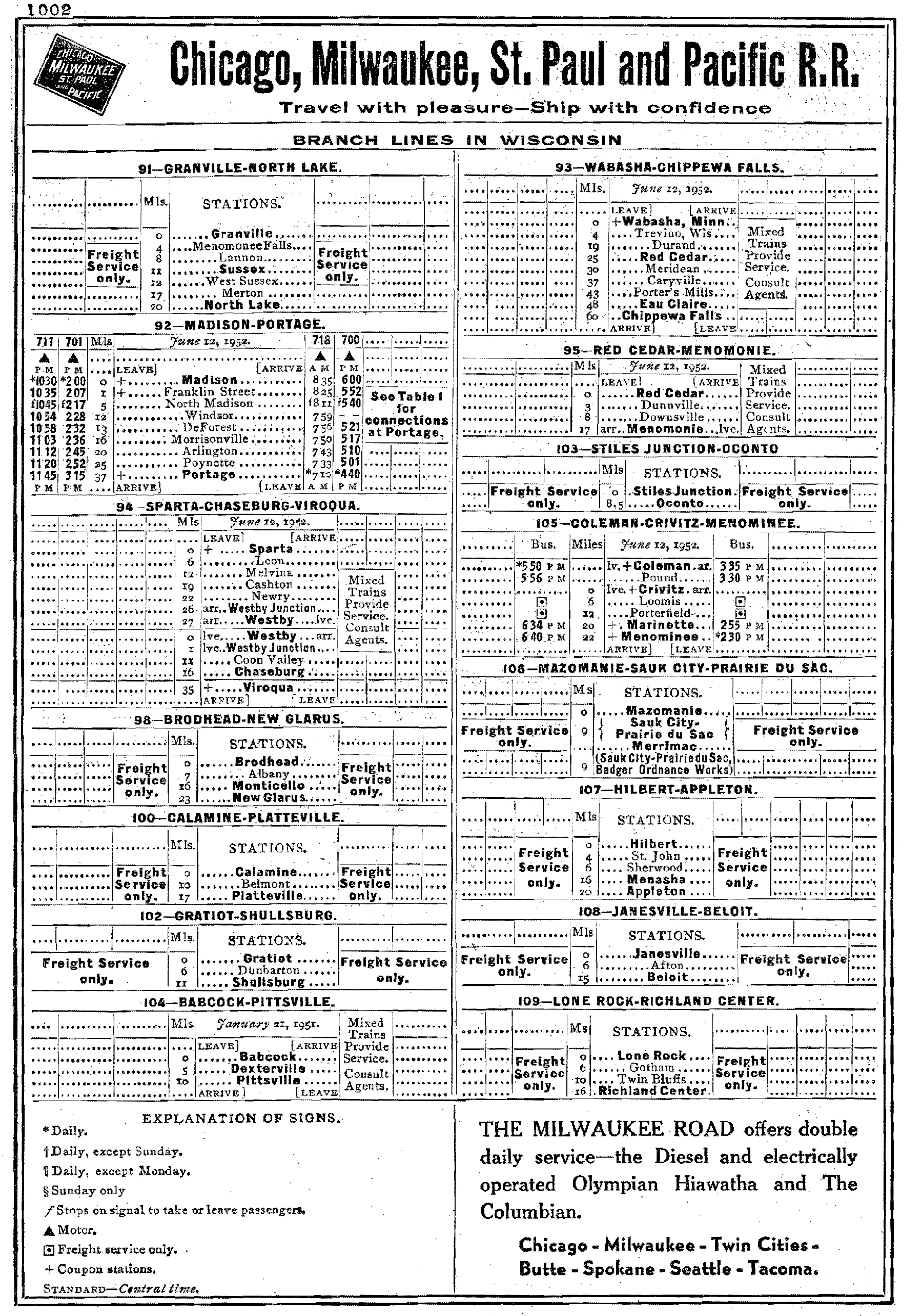Milwaukee Road: Map, Electrification, Logo, History
Last revised: October 16, 2024
By: Adam Burns
The Chicago, Milwaukee, St. Paul & Pacific (CMStP&P), better known as the Milwaukee Road, always went its own way. It headed west in 1909 and launched a unique streamliner, the Hiawatha, in 1935. The history of this company is quite complicated, filled with struggles and setbacks.
As an independent it held no allegiances to others and was not influenced by moguls like Hill, Harriman, or Budd.
Regardless, the CMStP&P blossomed into an impressive system that battled not only for the highly competitive Midwestern agricultural business but also lucrative Pacific Northwest transcontinental traffic.
It enjoyed the longest, end-to-end network of any American railroad, stretching from Louisville, Kentucky to the Puget Sound.
Perhaps Milwaukee Road's most glaring issue was a perpetual lack of leadership, which only became magnified in later years. In the end, its ultimate fate is a disheartening story of letdown and disinterest.
During the 1970's, upper management made a series of dumbfounding decisions (such as turning away new business, refusing to carry out much-needed capital improvements, opting against overhauling/upgrading its electrification, and maintaining its transcontinental status) that culminated in the railroad's bankruptcy.
Today, what's left of the Milwaukee Road is cut up among different railroads and the best engineered route through the rugged Rockies and Cascades is but weeds and trails, a vital transportation artery no longer available to shippers and the American economy.
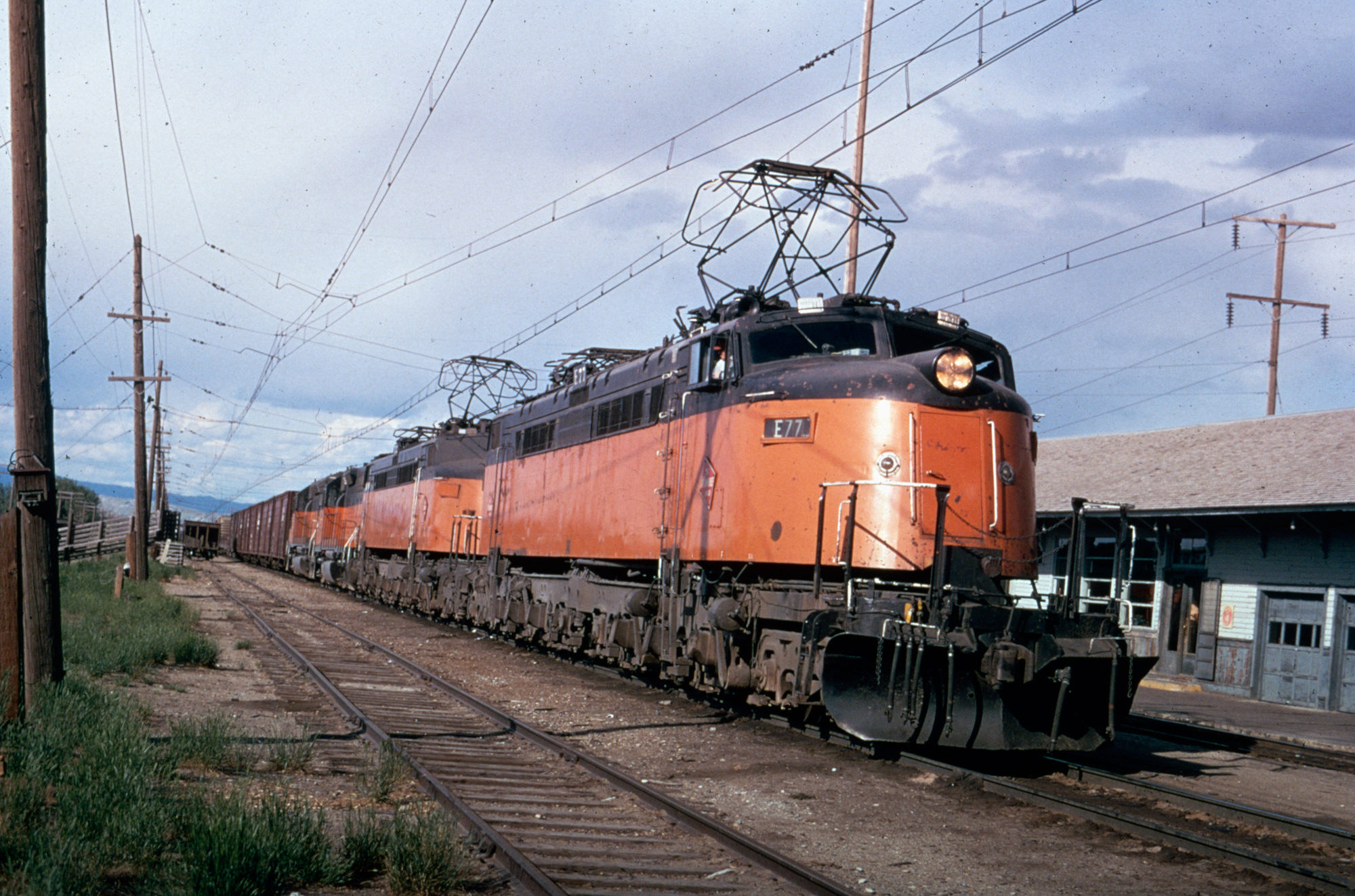 It's the final week of electrified operations as Milwaukee Road "Little Joe" E-77 leads an eastbound freight past the depot at Three Forks, Montana on June 8, 1974. Photographer unknown. American-Rails.com collection.
It's the final week of electrified operations as Milwaukee Road "Little Joe" E-77 leads an eastbound freight past the depot at Three Forks, Montana on June 8, 1974. Photographer unknown. American-Rails.com collection.History
A scholarly study detailing the Milwaukee Road's complete story, particularly its last 35 years, has never been published although is desperately needed.
It would not only provide for fascinating reading but also answer many more questions about its untimely end.
In all respects, the Milwaukee should have been a historically strong carrier; it's nearly 11,000-mile network served every major Midwestern market directly, except St. Louis. In addition, its superbly engineered western extension was shorter than rivals Great Northern and Northern Pacific.
Even as long-haul freight tonnage grew exponentially in the post-World War II era the Milwaukee's traffic density lagged behind GN, NP, and Chicago, Burlington & Quincy. In his book, "The Milwaukee Road," author Tom Murray perhaps put it best:
"Today, many followers of the Milwaukee continue to ask why those responsible for the company - its management, its shareholders and creditors, its bankruptcy trustees, its regulators, and the court responsible for overseeing the company in its final years - made the decisions they did, and whether the Milwaukee might have been able to survive in some form if different decisions had been made.
Those are important questions, and they deserve the best answers that serious scholarship can provide..."
At A Glance
11,252 (1928) 656 Electrified (1928) |
|
Chicago - Milwaukee - Twin Cities New Lisbon - Woodruff, Wisconsin Twin Cities - Spokane - Seattle/Tacoma Twin Cities - Austin, Minnesota - Calmar, Iowa La Crescent, Minnesota - Wessington Springs, South Dakota Rondout, Illinois - Madison, Wisconsin Watertown, Wisconsin - Rapid City, South Dakota Chicago - Cambridge, Iowa - Omaha Manila, Iowa - Sioux Falls, South Dakota Marion - Ottumwa, Iowa Sturtevant, Wisconsin - Davenport, Iowa - Kansas City La Crosse, Wisconsin - Sabula, Iowa Des Moines, Iowa - Spencer, Iowa Chicago - Terre Haute, Indiana Milwaukee - Green Bay - Ontonagon, Michigan Harlowton - Great Falls, Montana Great Falls - Agawam, Montana Lewistown - Winifred/Winnett, Montana Seattle - Tacoma - Chehalis - Portland, Oregon Cedar Falls - Everett, Washington Franklin Park, Illinois (Bensenville) - Terre Haute, Indiana - Seymour, Indiana St. Paul - Duluth, Minnesota/Superior, Wisconsin Milwaukee - Iron Mountain, Michigan - Ontonagon/Calumet, Michigan Sabula, Iowa - La Crescent, Minnesota - Winona, Minnesota - St. Paul/Minneapolis Winona - Chippewa Falls, Wisconsin New Lisbon - Woodruff, Wisconsin Des Moines, Iowa - Herndon, Iowa - Spencer, Iowa - Spirit Lake, Iowa Milwaukee - Madison - Clear Lake - Chamberlain, South Dakota - Rapid City, South Dakota Manilla, Iowa - Sioux City, Iowa - Mitchell, South Dakota - Aberdeen, South Dakota - Edgeley, North Dakota Ortonville, Minnesota - Fargo, North Dakota Portage, Wisconsin - Madison - Beloit, Wisconsin - Davis Junction, Illinois - Ladd/Depue/Granville/Oglesby, Illinois Spokane - Coeur d'Alene, Idaho Coeur d'Alene - Metaline Falls, Washington Tacoma - Morton, Washington Bellingham - Maple Falls (via car ferry service from Port Townsend) | |
Diesels: 803 Electric: 93 |
|
Freight Cars: 42,325 Passenger Cars: 588 |
|
This article also cannot bring closure to such fascinating questions but it is hoped the information will shed some light on the Milwaukee's plight, particularly its last ten years as a transcontinental carrier. For many, the Chicago, Milwaukee, St. Paul & Pacific remains their all-time favorite railroad.
This statement is supported by authors and historians, such as Doug Harrop. In his article, "The Milwaukee Road's Lines West" (co-authored by Ed Lynch) from the July/August/September, 2009 edition of The Railroad Press (Issue #82), Harrop notes:
"In July 1979 I picked up a good friend, the late John Bjorklund at the Salt Lake City airport and we started a long drive north. We were just two rail nuts heading out to shoot some trains.
But not just any trains. We would be immersing ourselves in the Milwaukee Road's Lines West. Was this a big deal? It was to us. Back then, just about any railfan you talked to would list the Milwaukee Road as their first, second, or third favorite railroad regardless where they lived. That included John and I."
For train enthusiasts, the Milwaukee truly did have it all; electrified operations (until 1974), time freights, ore service in Michigan's Upper Peninsula, Chicago commuter operations, logging in Idaho, a fleet of glamorous streamliners, and an eclectic locomotive fleet.
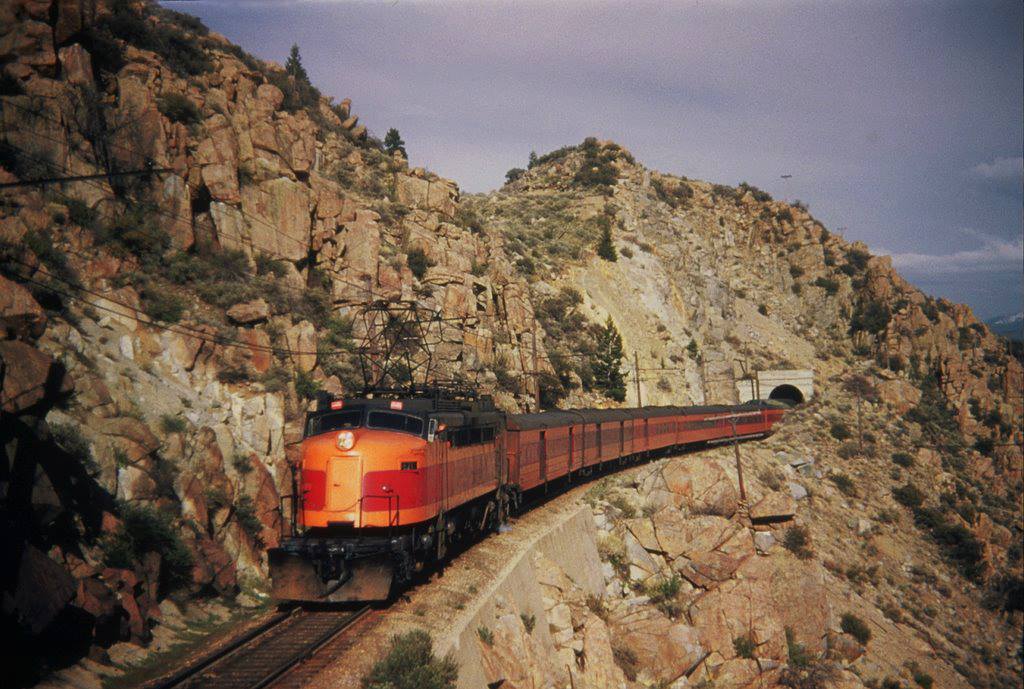 Milwaukee Road's train #15, the westbound "Olympian Hiawatha," exits Fish Creek Tunnel deep within western Montana's breathtaking backcountry on the late afternoon of May 27, 1953. Alas, nothing remains here today aside from an empty path. Sandy Goodrick photo.
Milwaukee Road's train #15, the westbound "Olympian Hiawatha," exits Fish Creek Tunnel deep within western Montana's breathtaking backcountry on the late afternoon of May 27, 1953. Alas, nothing remains here today aside from an empty path. Sandy Goodrick photo.Early Years
Like other fabled grangers, the Milwaukee Road carried humble beginnings during a time when the iron horse was just making its debut west of Chicago.
Its earliest corporate predecessor was the Milwaukee & Waukesha Railroad, chartered in 1847 for the purpose of connecting its namesake towns with the Mississippi River.
More than 10 years would pass, however, before it became a reality. According to the book, "Milwaukee Road West" by authors Charles and Dorothy Wood, after the "Territory of Wiskonsan" was established in 1836, a committee met on September 17th that year to incorporate a railroad for the purpose of serving Milwaukee, the region's one noteworthy settlement.
Fighting among various business leaders and politicians regarding exactly what type of transportation entity would be built delayed progress; many opted for a railroad, some wanted a canal, and others a plank road.
The latter initiatives did gain some traction, and the canal (incorporated as the Milwaukee & Rock River Canal Company in January, 1838) was even awarded 500,000 acres in land grants by Congress.
However, as railroads grew in popularity the other proposals faded and never advanced beyond the planning stages.
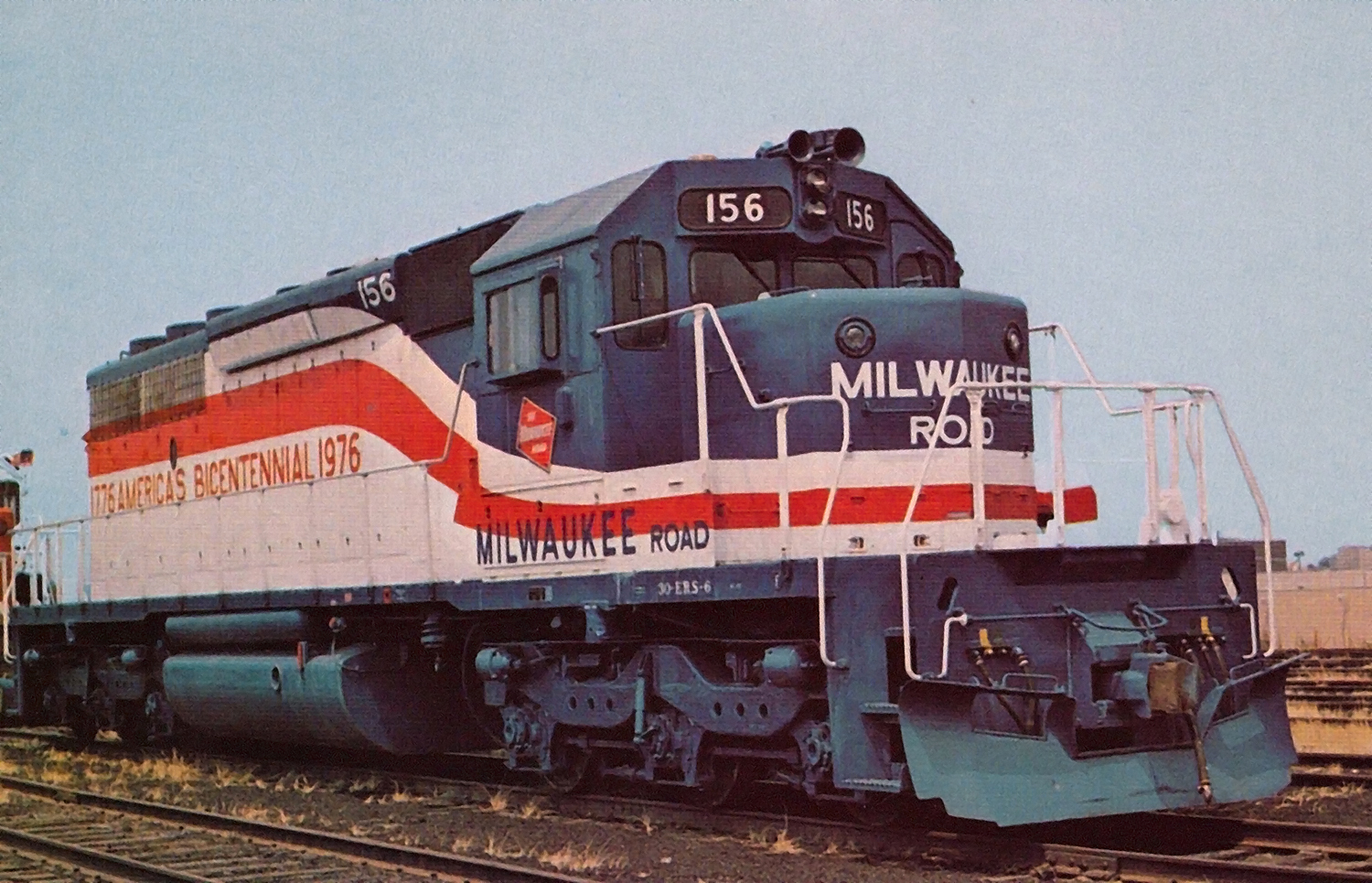 Milwaukee Road SD40-2 #156 (built as #3026) is seen here wearing the railroad's Bicentennial livery on July 31, 1975. Ray Lackemeyer photo.
Milwaukee Road SD40-2 #156 (built as #3026) is seen here wearing the railroad's Bicentennial livery on July 31, 1975. Ray Lackemeyer photo.Milwaukee & Waukesha
On May 19, 1849 the Milwaukee & Waukesha was formally organized but just a year later saw its name changed to the Milwaukee & Mississippi Railroad (M&M), carrying an authorized capital of $100,000.
The Mayor of Milwaukee, Byron Kilbourn, was elected M&M's first president and on September 12, 1850 construction got underway in Milwaukee.
In his book, "Milwaukee Road Remembered," company historian Jim Scribbins points out the initial 5 miles to Wauwatosa was completed quickly with the final rails spiked down on November 20th.
Afterwards, the company hosted an impromptu excursion over this new trackage, pulled by the M&M's only locomotive, 4-4-0 #1, named the Bob Ellis (an 1848 product of Philadelphia's Norris Locomotive Works).
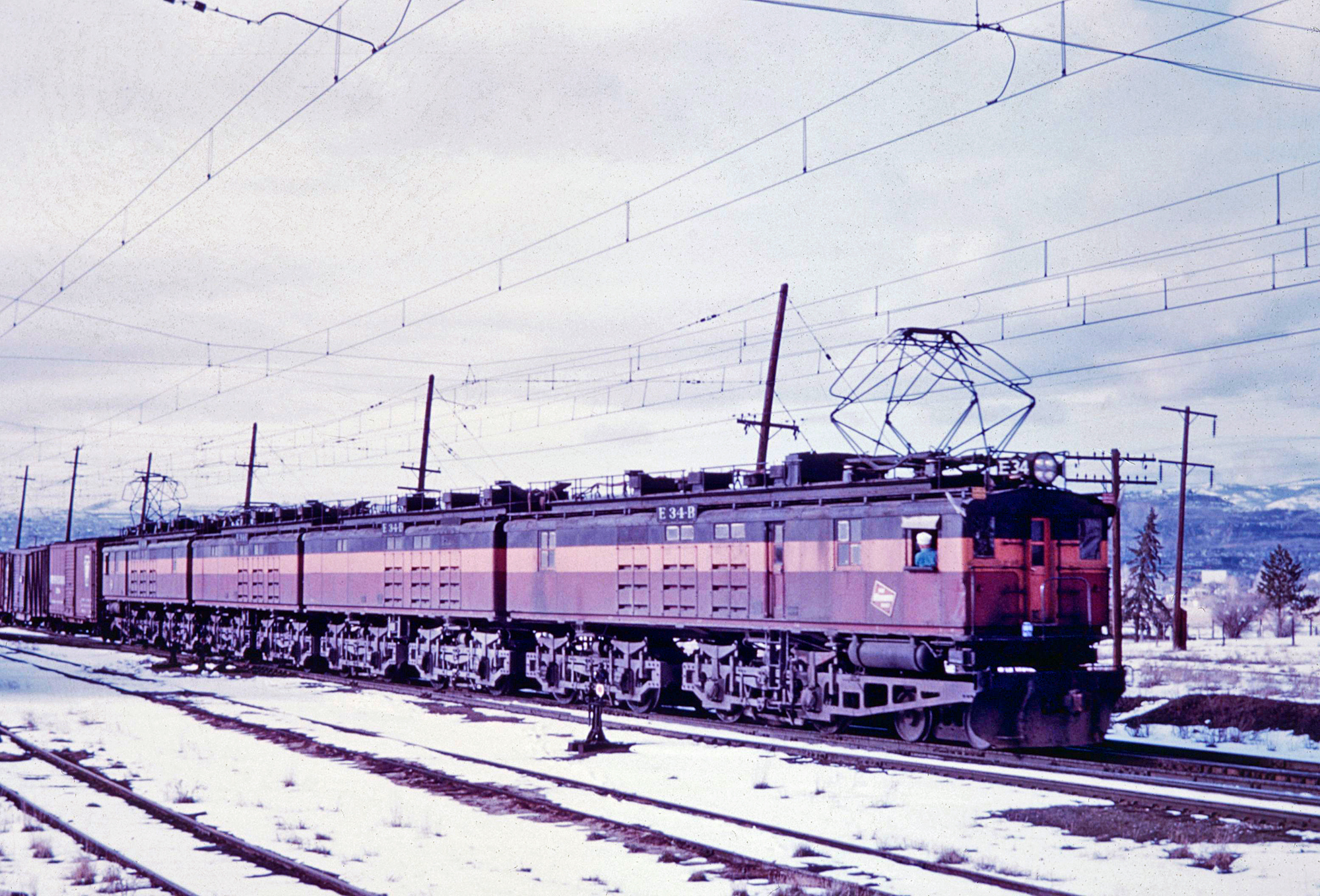 Milwaukee Road boxcab set E34 is seen here at work in the yard at Butte, Montana during the winter of 1958. American-Rails.com collection.
Milwaukee Road boxcab set E34 is seen here at work in the yard at Butte, Montana during the winter of 1958. American-Rails.com collection.As work progressed westward, rails reached Waukesha (20 miles) on February 25, 1851. Another gala was held to mark this event although the railroad was soon faced with a significant financial hurdle.
While promoters were eager to reach the Mississippi River the M&M's earnings proved inadequate to cover the interest on its debt. The company was faced with certain bankruptcy but managed to avoid receivership by settling with bondholders in the amount of $14,518.
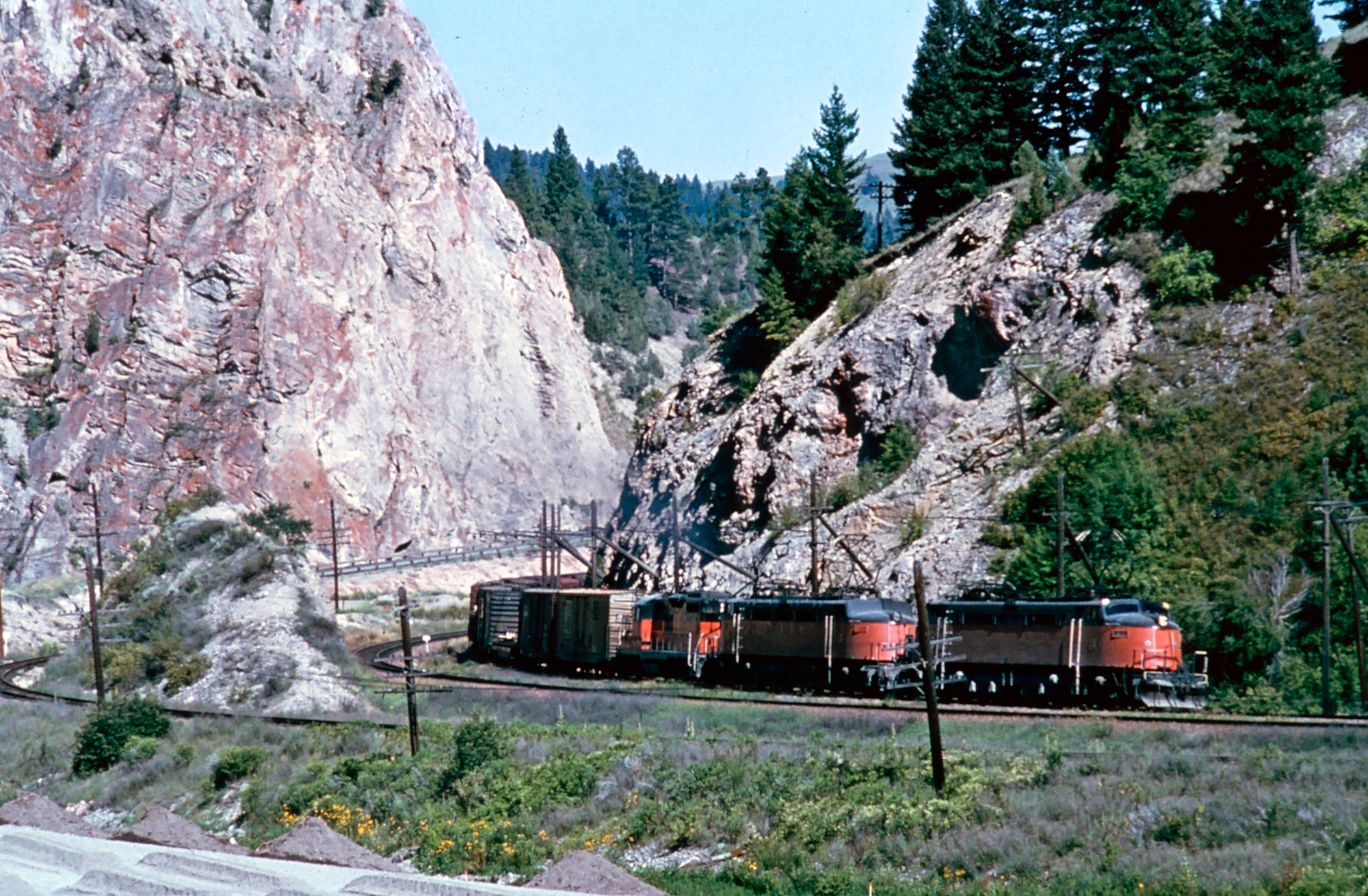 Milwaukee Road "Little Joes" E-76 and E-79 lead a westbound freight along the Clark Fork River at rural Bearmouth, Montana, circa 1970. The Northern Pacific main line can be seen at left. Photographer unknown. American-Rails.com collection.
Milwaukee Road "Little Joes" E-76 and E-79 lead a westbound freight along the Clark Fork River at rural Bearmouth, Montana, circa 1970. The Northern Pacific main line can be seen at left. Photographer unknown. American-Rails.com collection.After sidestepping this calamity, the M&M found the necessary capital to reach Madison by 1854, via a roundabout line that it took southwesterly into White Water before turning north and passing through Stoughton; three years later, the M&M arrived at Prairie du Chien (April 15, 1857), thus completing its original promoters' ambitions.
Unfortunately, the euphoria of this event was short-lived. Due to ongoing economic woes brought about by 1857's financial panic, the M&M entered receivership in 1860.
A year later it was sold at foreclosure to New York interests and reorganized as the Milwaukee & Prairie du Chien Railway (M&PdC) in January of 1861.
Milwaukee & St. Paul
It was then that Andrew Mitchell, Milwaukee's leading banker, entered the picture. Looking to enter the railroad business he organized the Milwaukee & St. Paul (M&StP) on May 5, 1863; what followed was a series of complicated corporate maneuverings that saw Mitchell acquire the M&PdC, along with what was formerly known as the La Crosse & Milwaukee, by 1867.
After also adding the McGregor Western Railroad the new M&StP boasted an 800-mile network connecting the following points: Milwaukee - Madison - Prairie du Chien - Minneapolis and Milwaukee - Portage - La Crosse.
 Nearing the end of its career one of Milwaukee Road's high-speed 4-4-2's (Class A) departs Madison, Wisconsin with eastbound train #14, the "On Wisconsin" (Madison - Chicago), during December of 1950. This secondary service featured coaches, a diner, buffet-parlor, lounge, and parlor-solarium. Bill Middleton photo.
Nearing the end of its career one of Milwaukee Road's high-speed 4-4-2's (Class A) departs Madison, Wisconsin with eastbound train #14, the "On Wisconsin" (Madison - Chicago), during December of 1950. This secondary service featured coaches, a diner, buffet-parlor, lounge, and parlor-solarium. Bill Middleton photo.Expansion
Throughout the 1870's the M&StP rapidly expanded, thanks in part to the financial Panic of 1873 which saw numerous railroads in bankruptcy; during 1872 it picked up the St. Paul & Chicago, which skirted the Mississippi River's western bank into the Twin Cities and a year later the M&StP reached Chicago.
Chicago, Milwaukee & St. Paul
Fast becoming a dominant Midwestern carrier, during February of 1874 its name was changed to the Chicago, Milwaukee & St. Paul Railway (CM&StP). It would retain this title for more than a half-century.
By 1876 it operated more than 1,400 miles and owned five grain elevators in Milwaukee, which could handle 3 million bushels of wheat.
As the CM&StP continued to grow it reached Iowa, the Dakota Territories, and additional points in Minnesota and Wisconsin.
By 1880 its network totaled 3,894 miles. Its next major development was an extension due west of Chicago towards the transcontinental gateway of Omaha, Nebraska.
In 1879 it picked up the Western Union Railroad between Racine, Wisconsin and Savanna, Illinois then added the Chicago & Pacific in 1880 running due west of the Windy City.
The 1880's witnessed further expansion as it sought major markets not already reached; in 1882 it arrived in Council Bluffs (in 1890 trackage rights over Union Pacific provided access into Omaha Union Station), gained access to Fargo in 1884, and achieved a Kansas City connection by 1887.
System Map
Considered by many as the Milwaukee Road's greatest leader, Andrew Mitchell passed away on April 19, 1887. His efforts had established one of the region's most prominent railroads with a network of 5,670 miles by year's end.
Its only notable rivals included the Chicago & North Western; Chicago, Rock Island & Pacific (Rock Island); and Chicago, Burlington & Quincy.
In 1890 the CM&StP boasted gross revenues of $26.4 million and spent that decade using its strong earnings power to upgrade/modernize its property.
In September it picked up the Milwaukee & Northern Railroad which further diversified its traffic base by serving the iron ore industry of Michigan's Upper Peninsula.
As the 19th century came to a close, CM&StP officials began to wonder how well their railroad could compete among a crowded web of carriers serving America's breadbasket. Legendary tycoon James J. Hill, the "Empire Builder," had asked this very same question in the late 1880's.
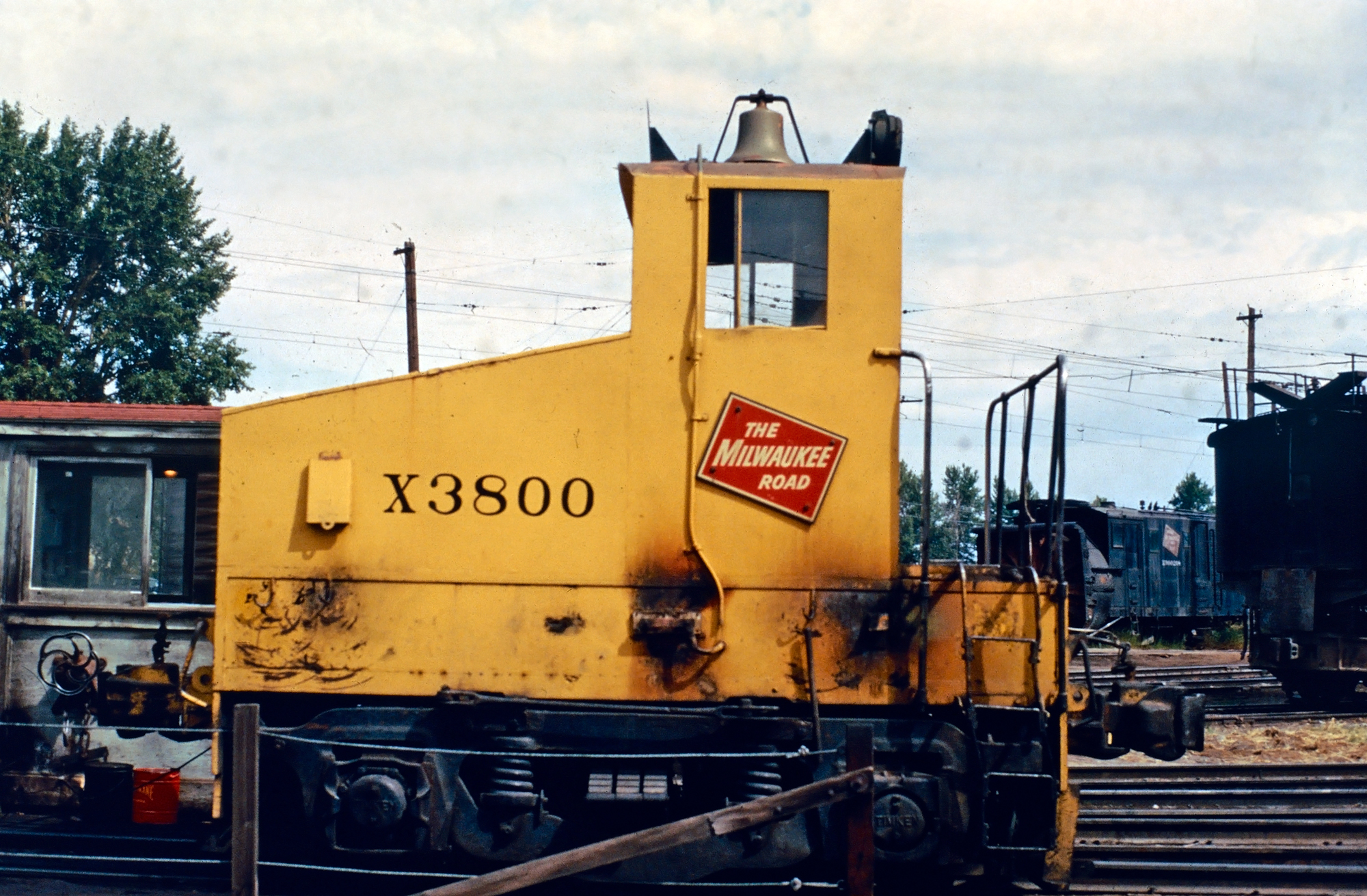 Milwaukee Road shop goat X3800 was photographed here in Deer Lodge, Montana during July, 1972. The little home-built switcher, powered by a 220-volt DC extension cord, spent many years pulling electrics into and out of the yard's roundhouse. Today, it sits on display in Harlowton, Montana. Photographer unknown. American-Rails.com collection.
Milwaukee Road shop goat X3800 was photographed here in Deer Lodge, Montana during July, 1972. The little home-built switcher, powered by a 220-volt DC extension cord, spent many years pulling electrics into and out of the yard's roundhouse. Today, it sits on display in Harlowton, Montana. Photographer unknown. American-Rails.com collection.His St. Paul, Minnesota & Manitoba Railway (predecessor of the Great Northern) was then serving Montana but he recognized that to truly stand out, its long-term financial prospects required reaching the Pacific.
Those at the Milwaukee Road would come to the same conclusion nearly two decades later.
After turning down Hill's proposal to purchase their property (Doing so would have provided his GN a direct Chicago routing. He went on to acquire the CB&Q for this purpose.), new president Albert J. Earling (1899) pushed for the west coast option.
Logo
The Chicago, Milwaukee, St. Paul & Pacific's unique tilted logo and "Milwaukee Road" nickname can be traced back to the Andrew Mitchell era although it was not formally adopted until the 20th century.
According to the Woods' book, the emblem first appeared in 1880 and remained in use throughout the railroad's corporate life.
It is believed the name "Milwaukee" originally described the Milwaukee & Mississippi while "La Crosse" referred to the La Crosse & Milwaukee.
With the Milwaukee & St. Paul's formation that railroad became known as the "St. Paul."
In the succeeding years, "Milwaukee" and "St. Paul" were used interchangeably to describe the company although the latter was typically preferred by Wall Street.
When the railroad was reorganized as the Chicago, Milwaukee, St. Paul & Pacific in 1928, "The Milwaukee Road" made its first appearance on timetables and other materials at that time.
Nearly three decades later, in 1953, this title formally replaced "Chicago, Milwaukee, St. Paul & Pacific" within the company's official tilted logo.
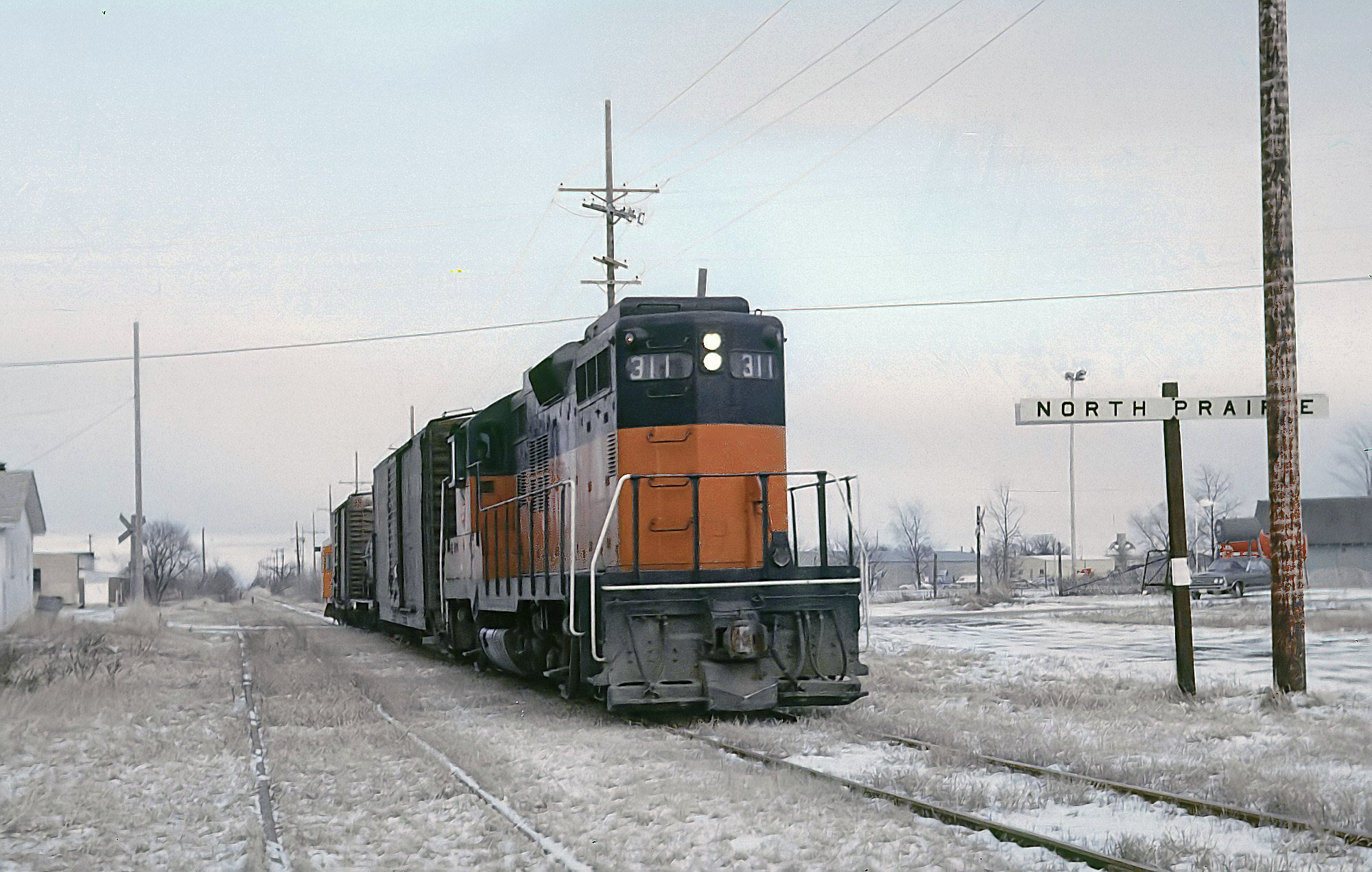 Milwaukee Road GP9 #311 with a short train at North Prairie, Wisconsin on January 17, 1975. Today, this line remains in service under Wisconsin & Southern. Rick Burn collection.
Milwaukee Road GP9 #311 with a short train at North Prairie, Wisconsin on January 17, 1975. Today, this line remains in service under Wisconsin & Southern. Rick Burn collection.Pacific Extension
The company's board of directors approved the plan on November 28, 1905 and a financially healthy CM&StP went west, at a projected cost of $60 million.
After all the needed right-of-way was acquired (privately purchased without the aid of land grants), construction began from Mobridge, South Dakota, a tiny hamlet that sat along the Missouri River's eastern bank.
With crews working rapidly from multiple directions the entire Pacific Coast Extension was finished in a mere three years with the formal "Last Spike" ceremony held at Garrison, Montana on May 19, 1909.
Instead of reaching Seattle, however, the CM&StP chose nearby Tacoma as its primary Puget Sound terminal.
The company did so for a number of reasons but most importantly due to its rich timber business (the city was dubbed the "Lumber Capital of America") and NP/GN's long-established foothold on the Seattle waterfront.
At Tacoma, the Milwaukee constructed yard, maintenance, docks, and terminal facilities in the tide flats, which remained in use until the Extension's 1980 abandonment.
Only later did it reach the Emerald City over trackage rights from the main line at Black River Junction (Renton) and join Union Pacific at its downtown Union Station.
The Milwaukee's western extension was an impressive feat of engineering:
- It crossed five mountain ranges (from east to west these included the Belts, Rockies, Bitter Roots, Saddles, and Cascades)
- Featured 45 tunnels
- Avoided population centers for a more direct route to the coast (this decision, coupled with Union Pacific's, Great Northern's, and Northern Pacific's own protective measures did hurt freight tonnage for many years)
Much of the route required new construction although there was a component in western Montana purchased outright.
The Montana Midland Railroad had originally been organized by Richard A. Harlow in 1893 to handle low-grade ore from the Castle Mountains to a Northern Pacific connection at the junction of Lombard (named for his chief engineer, Arthur B. Lombard).
At first, his project failed to secure the needed capital and was reorganized as the Montana Railroad in 1895.
After locating new sources of capital, the first section from Lombard to Merino (later renamed Harlowton) opened in 1900. In 1903 it was extended above Harlowton to Lewiston.
Unfortunately, the company's traffic never materialized as expected and it was soon experiencing considerable financial problems, resulting in CM&StP's takeover by 1910.
Much of the right-of-way had to be upgraded to meet main line standards but it nevertheless provided the railroad with over 100 miles of completed right-of-way.
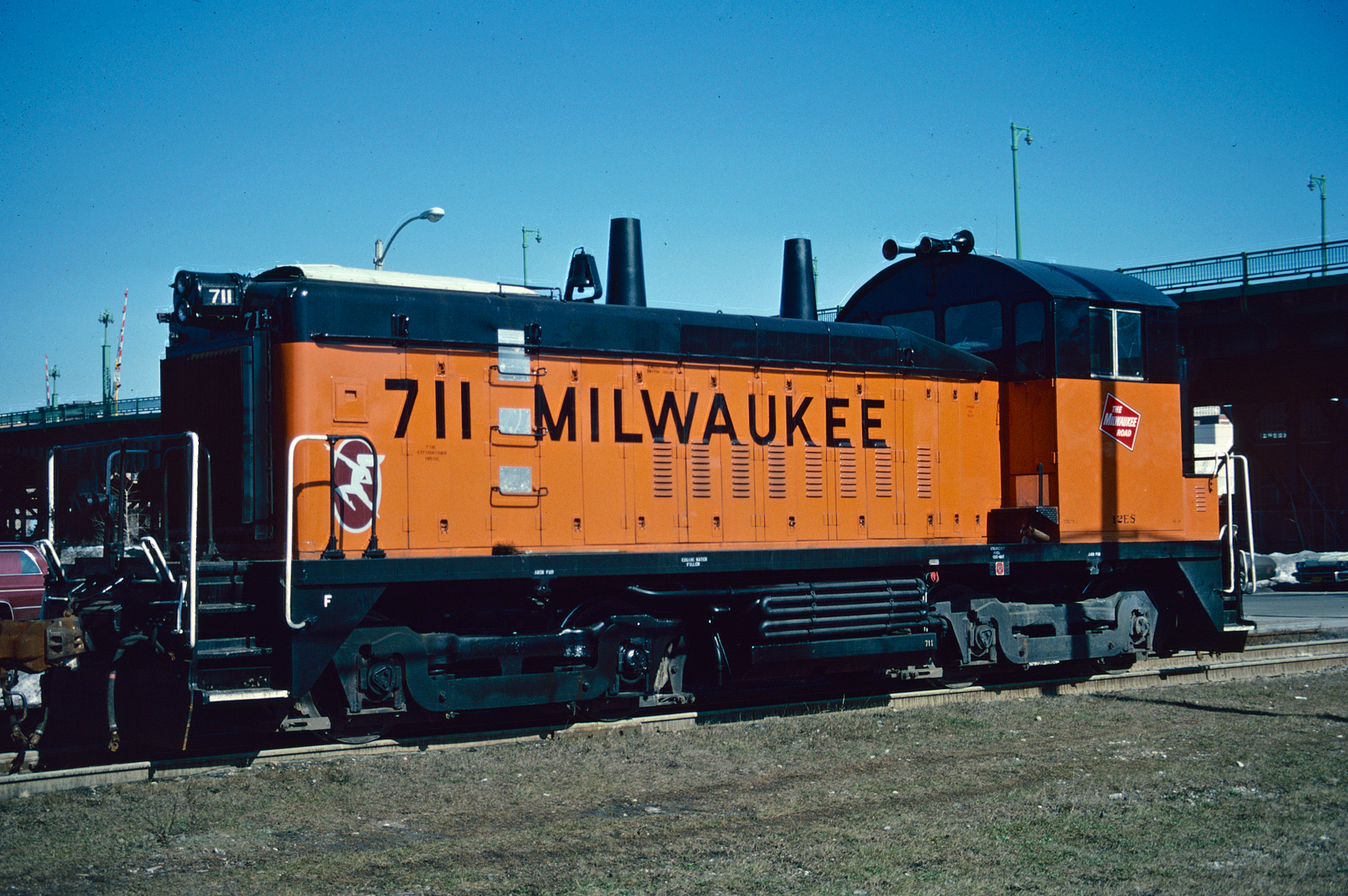 Milwuakee Road SW1200 #711 was photographed here at South Milwaukee, Wisconsin on February 27, 1985. Mike Sosalla photo. American-Rails.com collection.
Milwuakee Road SW1200 #711 was photographed here at South Milwaukee, Wisconsin on February 27, 1985. Mike Sosalla photo. American-Rails.com collection.In spite of traffic difficulties, CM&StP officials did accomplish their goal of establishing the shortest and best engineered route from Chicago to Seattle. Murray's book points out that Milwaukee's transcontinental corridor was 130 miles shorter than the combined Burlington's/Northern Pacific's route and 22 miles shorter than Burlington's/Great Northern's.
Freight service began on July 4, 1909 (local passenger service commenced on July 10, 1910 while the long-distance Olympian and Columbian were launched on May 28, 1911) although it was not until the Pacific Extension's longest tunnel opened did the line truly shine.
Snoqualmie Pass sat within the heart of the Cascades and necessitated a tunnel to achieve the desired grades.
The bore, 11,890 feet in length (2.25 miles), required two years of work and was finally opened in January of 1915 (it was built with two western portals for a potential double-tracking project never carried out).
Overall, the ruling grade between Cedar Falls and Rockdale, to the tunnel's western portal was 1.7%, while the tunnel itself was level inside.
From Cle Elum to Hyak, at the eastern portal, the grade was even easier at just 0.7% (before its completion grades were 2.2% up the mountain's eastern slope and 2.75% along its western slope). To compare this crossing with the Great Northern's and Northern Pacific's please click here.
 Milwaukee Road E9A #38C leads a passenger extra at Arlington, Wisconsin in June, 1967. Rick Burn photo.
Milwaukee Road E9A #38C leads a passenger extra at Arlington, Wisconsin in June, 1967. Rick Burn photo.Alas, for all the Pacific Extension's accolades it had far exceeded cost estimates, requiring $234 million to complete. In an effort to immediately put freight on the rails, many miles of secondary lines were purchased or built through the Dakotas, Montana, Idaho, and Washington.
Once opened, Milwaukee's so-called "Lines West" added 2,159 miles to its network; by 1917 it boasted a system of 10,257 miles. But that wasn't all.
Electrification
In an even bolder step, officials made the unprecedented decision to electrify key portions through the Rockies and Cascades. It was the most extensive mountainous electrification ever carried out in the United States.
During March of 1914 the CM&StP formed the Electrification Department and subsequently began energizing two sections of its main line; one from Harlowton, Montana to Avery, Idaho (440 miles) and the other between Othello, Washington and Seattle/Tacoma (216 miles).
Power was supplied by hydroelectric dams operated by Montana Power; on the Rocky Mountain Division (Harlowton - Avery) these were located along the Missouri River while a plant at Thompson Falls, on the Columbia River's Clark Fork, energized the Coast Division (Othello - Seattle/Tacoma).
The railroad ran hundreds of miles of 100,000 volt, alternating-current (AC) power lines to connect 14 substations on the Rocky Mountain Division and another 13 on the Coast Division.
This AC power was subsequently stepped down by the substations to 3,000-volt, direct-current (DC) for the locomotives.
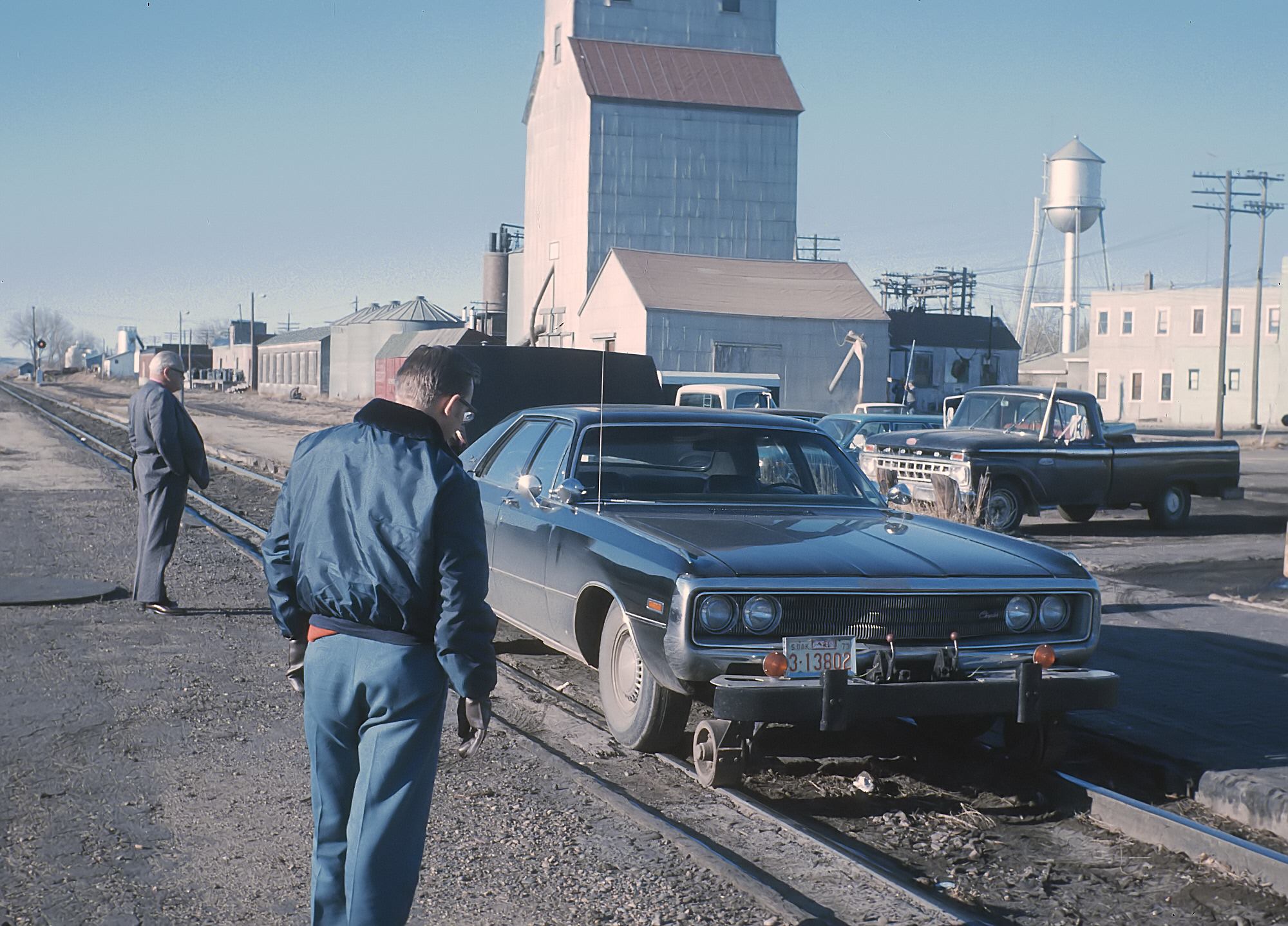 A Milwaukee Road 1970 Chrysler Newport hy rail is seen here at La Crescent, Minnesota in March, 1974. Rick Burn photo.
A Milwaukee Road 1970 Chrysler Newport hy rail is seen here at La Crescent, Minnesota in March, 1974. Rick Burn photo.The company wasted no time finishing this project; the Rocky Mountain Division was ready for service in early 1917 while the Coast Division was finished in November, 1919 (wires were later strung over the 9 miles from Black River Junction/Renton into Seattle Union Station during July of 1927).
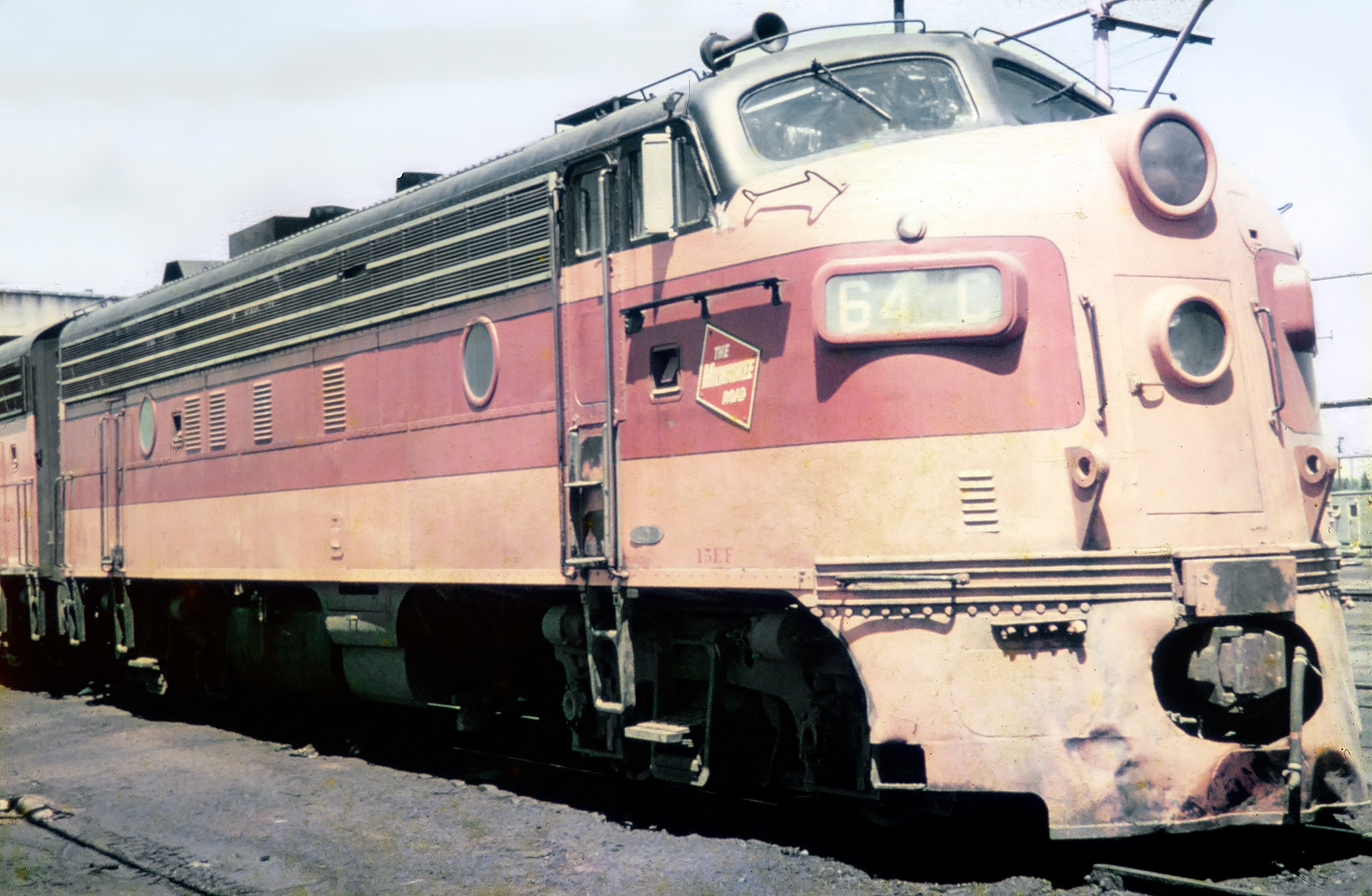 Milwaukee Road FP7 #64-C (built as #94-C) lays over at the Bensenville engine terminal (Illinois), circa 1964. American-Rails.com collection.
Milwaukee Road FP7 #64-C (built as #94-C) lays over at the Bensenville engine terminal (Illinois), circa 1964. American-Rails.com collection.As the Woods' book notes the railroad had planned to finish the gap between Avery and Othello. However, due to the traffic split at Plummer Junction (Passenger consists serving Spokane did so over a line that opened in 1914, which partially utilized Union Pacific trackage rights to reach that city while freight trains, ran the original route through Tekoa, Malden, and Marengo.), the section's easier grades, and a downturn in the economy shelved this proposal.
The decision to electrify cost the Milwaukee an additional $23 million ($15 million for the Rocky Mountain Division and $9 million on the Coast Division) resulting in an unsatisfactory financial situation as debt ballooned to $490 million.
If officials had known the poor economy their railroad would be facing afterwards, coupled with the government's nationalization scheme, they may have opted against going west entirely.
The Milwaukee Shops
One of the great shop complexes was Milwaukee Road's facilities in its home city of Milwaukee, Wisconsin. They were situated near the Menomonee River, somewhat southwest of of the city's downtown area.
As historian Mike Schafer notes in his book, "Classic American Railroads," the facility manufactured fleets of high-quality cars and locomotives dating back to the railroad's earliest years.
They gained national acclaim by constructing lightweight, streamlined cars for the flamboyant Hiawatha's only a year after Union Pacific and Chicago, Burlington & Quincy unveiled the streamliner concept.
In addition, their freight cars, including cabooses, carried a trademark ribbed siding for increased strength.
The Milwaukee Shops saved the company millions by manufacturing in-house what would have otherwise required purchasing through a commercial builder. Today, some of this equipment can still be found preserved in museums across the country.
The directive was ordered by President Woodrow Wilson in response to fears of gridlock during World War I. It was made effective at noon on December 28, 1917 when the United States Railroad Administration took control of the railroads.
Unfortunately, the government did no better at maintaining fluid operations than the private sector; during this time equipment was rundown and infrastructure inadequately maintained to meet the crushing demand.
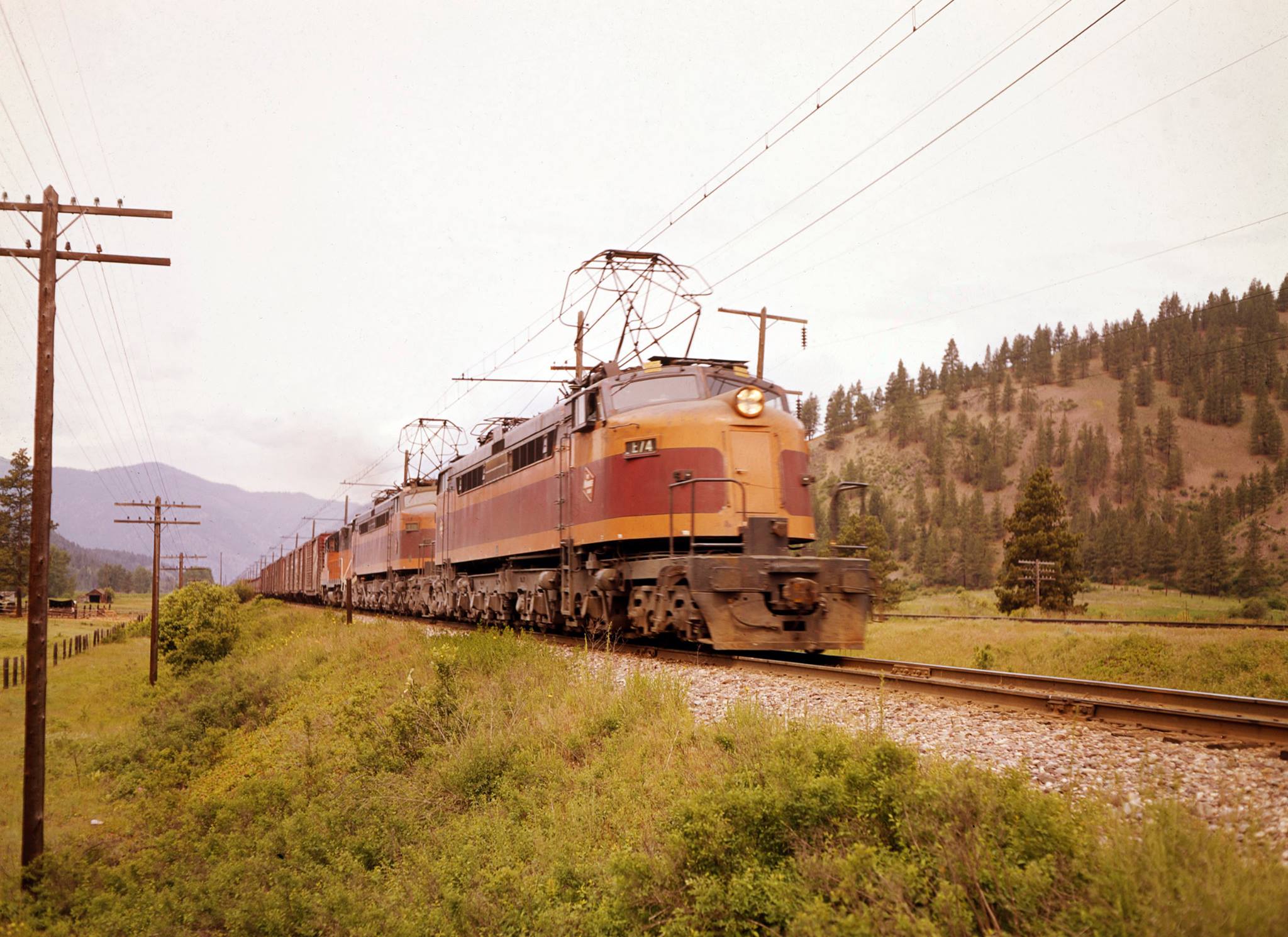 Milwaukee Road "Little Joes" E-74 and E-70, along with a GP9, have time freight #264 near Bonita, Montana during June of 1964. The Northern Pacific's main line can be seen in the background. Ron Nixon photo/Museum of the Rockies (Montana State University) collection.
Milwaukee Road "Little Joes" E-74 and E-70, along with a GP9, have time freight #264 near Bonita, Montana during June of 1964. The Northern Pacific's main line can be seen in the background. Ron Nixon photo/Museum of the Rockies (Montana State University) collection.Despite Milwaukee's electrification bringing an estimated net savings of $12.4 million through 1924, Uncle Sam's control was particularly hard on the company as its operating ratio skyrocketed from around 75.4% (directly after "Lines West" opened) to 98% by 1920. (To read much more about the building of the Pacific Extension please find a copy of the Woods' book, "Milwaukee Road West.")
It was finally returned to private ownership on February 28, 1920 following passage of the Transportation Act.
In spite of the company's grim financial outlook, it did make two final acquisitions during the 1920's by picking up the 373-mile Chicago, Terre Haute & Southeastern in June, 1921 (leased) and Chicago, Milwaukee & Gary in January, 1923.
The former served coal mines through southern Indiana to supply its steam locomotives (It later reached the gateway of Louisville on this corridor thanks to trackage rights over the Louisville & Nashville [1973] as a stipulation of L&N's 1971 acquisition of the Monon.) while the latter acted as a Chicago belt line.
Chicago, Milwaukee, St. Paul & Pacific Railroad
Bankruptcy finally came to the Chicago, Milwaukee & St. Paul on March 18, 1925 but it was relatively short-lived. The corporation was reorganized as the Chicago, Milwaukee, St. Paul & Pacific Railroad (CMStP&P), which took control on January 13, 1928. At this time the Milwaukee Road boasted a network of 11,252 miles.
Storm clouds were on the horizon again, though, as the stock market crash in October of 1929. With traffic in the gutter the CMStP&P entered bankruptcy again on June 29, 1935. It spent ten years mired in reorganization and finally exited receivership once more on February 23, 1945.
With World War II's traffic resurgence and a well-positioned transcontinental route, the Milwaukee spent the postwar years modernizing its network.
It laid heavier rail, upgraded freight yards/terminals, and became a fully dieselized/electrified by 1957. For all of this success the railroad simply could not outflank its competition.
As Mr. Murray's book notes, its freight revenue density (tonnage divided by total system mileage) was 1.59 million compared to the Burlington's 2.41 million, Great Northern's 2.34 million, and Northern Pacific's 2.12 million.
In addition, its income, excluding fixed charges, was around 1.46 times its financial commitments; this number was quite poor in comparison to the Great Northern (4.22), Burlington (3.24), and Northern Pacific (3.03).
Final Years
In spite of this, Lines West were a bright spot and the Milwaukee soon dominated the Puget Sound market. In 1963 it added time freights #261 (XL Special) and #262 (Thunderhawk) to the schedule.
Its major issue was the web of unprofitable branch lines in the Midwest, a region terribly overpopulated with railroads.
The Pacific Extension's value further increased following Burlington Northern's formation, created when Great Northern, Northern Pacific; Spokane, Portland & Seattle; and Chicago, Burlington & Quincy became a singular, unified system on March 2, 1970.
That year the Milwaukee Road posted a net loss of $8.9 million but the BN merger opened eleven new western gateways, including trackage rights into Portland. The latter provided a key connection to the Southern Pacific, which sent a flood of new business through this interchange.
Despite enjoying net earnings in 1973 and 1974 of $12.8 million and $11.4 million, respectively, for reasons unknown Milwaukee Road's upper management refused to spend the necessary capital to meet the growing demand.
It was estimated the cost to do so was between $120 and $140 million (ironically, between 1978 and 1983 the company stated it spent $600 million on other infrastructure improvements).
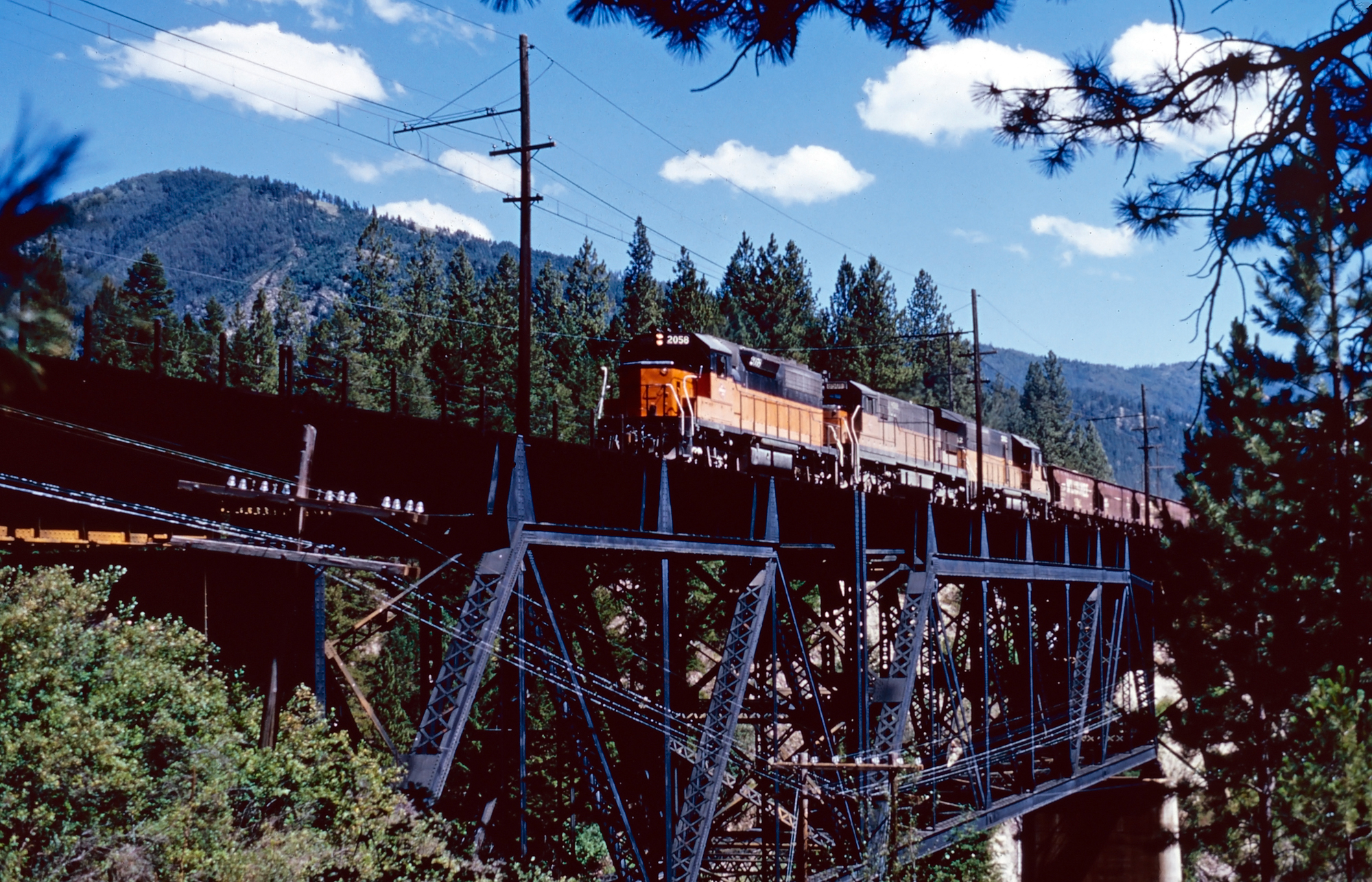 Milwaukee Road GP40 #2058 leads a westbound train over the Clark Fork River at Cyr, Montana on July 5, 1973. American-Rails.com collection.
Milwaukee Road GP40 #2058 leads a westbound train over the Clark Fork River at Cyr, Montana on July 5, 1973. American-Rails.com collection.Bankruptcy
As officials continued to make increasingly bizarre decisions (Such as announcing the electrification's indefinite discontinuance in 1973, just as the oil embargo hit the nation; electrics had stopped running the Coast Division in 1971 while the Rocky Mountain Division was de-energized in June, 1974.) their Pacific Northwest corridor continued earning a healthy profit.
But with an unwillingness to spend the necessary funds to meet service demands and a concentrated effort on deferring maintenance, the company's fate was sealed.
The Milwaukee Road filed for bankruptcy on December 19, 1977 and, in an even stranger twist, management somehow determined Lines West was the cause of their profitability issues.
Despite pleas to retain the corridor, including a proposal by employees to purchase the railroad (a similar tactic was carried out successfully at Chicago & North Western that decade), on March 15, 1980 the final eastbound freight train departed Tacoma. With that, the Milwaukee Road left the west coast.
Through the 1980's, scrappers tore up roughly 1,100 miles of track west of Miles City, Montana. The results of this and other eastern abandonment efforts worked, to some degree, in cutting costs and regaining profitability. However, a much smaller Milwaukee Road became a prime merger target and in 1985 the Soo Line acquired the company.
In truth the new "Milwaukee Road II" was never as profitable as management claimed. Former employees and others officials have long stood by their testimony that some at Burlington Northern knew beforehand the CMStP&P would file for bankruptcy.
While it has often been claimed that BN took part in some kind of conspiracy and sabotage the evidence of such remains ambiguous; all signs of its collapse point to mere ineptness, top brass simply wasn't interested in operating a railroad and there are several fascinating facts to back up this assertion.
First, when BN was created the eleven new gateways previously-mentioned offered a blitzkrieg of new traffic opportunities management utterly refused to handle. In spite of this attitude, the railroad's profits still rose immediately following the merger.
For instance, it essentially controlled the Port of Seattle, commanding nearly 80% of its originating traffic and roughly 50% of the total container traffic departing the Pacific Northwest.
In other words, the Milwaukee Road was dominating freight volume between Chicago and Seattle. So, why would a railroad so thoroughly controlling traffic out of the Puget Sound bow out? The answer to this question remains elusive.
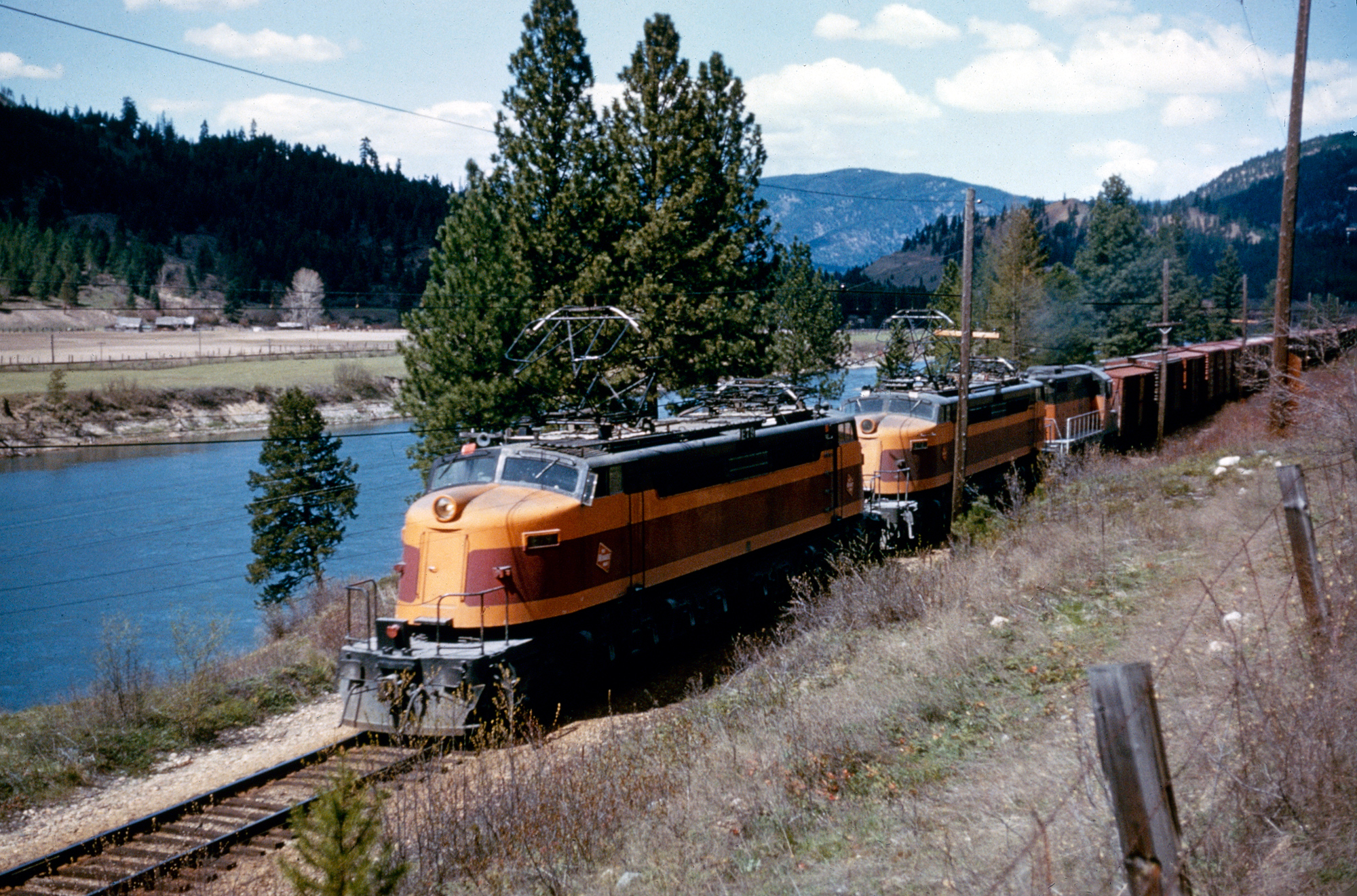 Milwaukee Road "Little Joes" E-79 and E-72, along with a GP9, have an eastbound freight along the Clark Fork River just east of St. Regis, Montana on April 30, 1958. American-Rails.com collection.
Milwaukee Road "Little Joes" E-79 and E-72, along with a GP9, have an eastbound freight along the Clark Fork River just east of St. Regis, Montana on April 30, 1958. American-Rails.com collection.Resources
For further reading on the collapse of the Milwaukee in the 1970s the web resources below are quite interesting and very informative. Of particular note is an essay by Michael Sol detailing his experiences as part of an engineering team assessing the viability of the railroad's electrified lines:
Milwaukee Road In The 70's: What Really Happened?
Case Study: The End Of The Milwaukee Electrification, By Michael Sol
The Demise Of The Milwaukee Road, A Timeline, By Michael Sol
Thesis - This Train's Got The Disappearin' Blues: A Study Of The Milwaukee Road, By Sara Levitan
The Milwaukee Road Archives, A Database Of Historic Records
More Reading
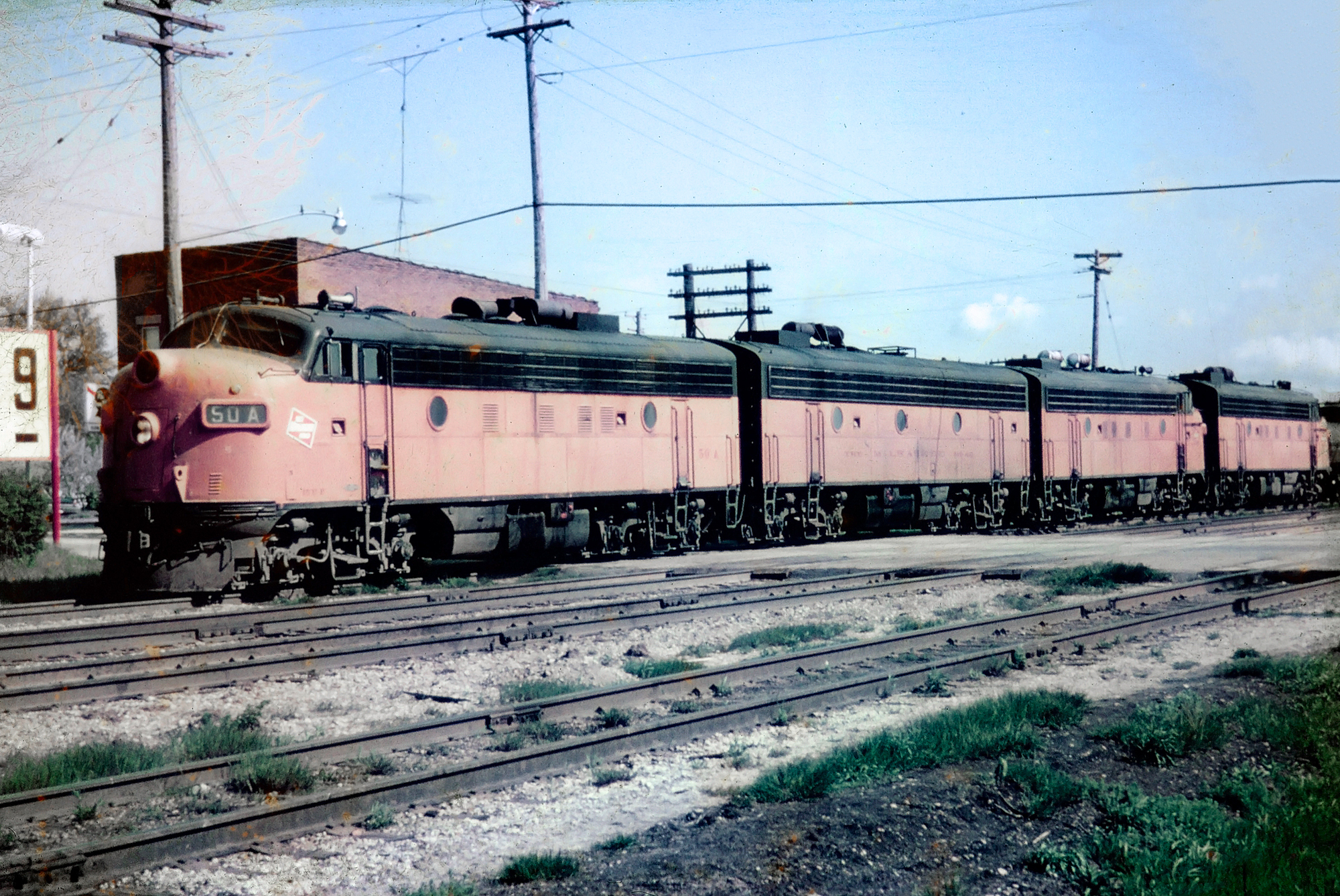 Milwaukee Road F7's, led by #50-A, at Sturtevant, Wisconsin, circa 1967. Fred Byerly photo. American-Rails.com collection.
Milwaukee Road F7's, led by #50-A, at Sturtevant, Wisconsin, circa 1967. Fred Byerly photo. American-Rails.com collection.Another interesting revelation occurred after the route's abandonment; when ICC accountants reviewed Milwaukee's books they found expenses had inexplicably been double-entered for Lines West.
Needless to say it was a dumbfounding disclosure; after obtaining correct figures the ICC learned that, even with the electrification's shutdown and years of deferred maintenance, it had still earned a profit!
Finally, there was the story of top management attempting to sell the railroad to Burlington Northern; noted Milwaukee Road historian, Rob Leachman, states that this account came directly from a BN executive at the time, Bob Downing. If true, it would explain why the railroad was left for dead during 1970's.
Around 1972, then-Milwaukee Road chairman Bill Quinn was working hard to carry out the proposed deal. During one inspection trip over Lines West, Quinn is said to have secretly offered the property to BN for absolutely nothing except its outstanding debt!
No one, not even the vice-president or other top officers, ever knew about this scheme. BN was very intrigued and initially agreed but with the stipulation that the Milwaukee Road was to make no major capital investments or improvements until the acquisition.
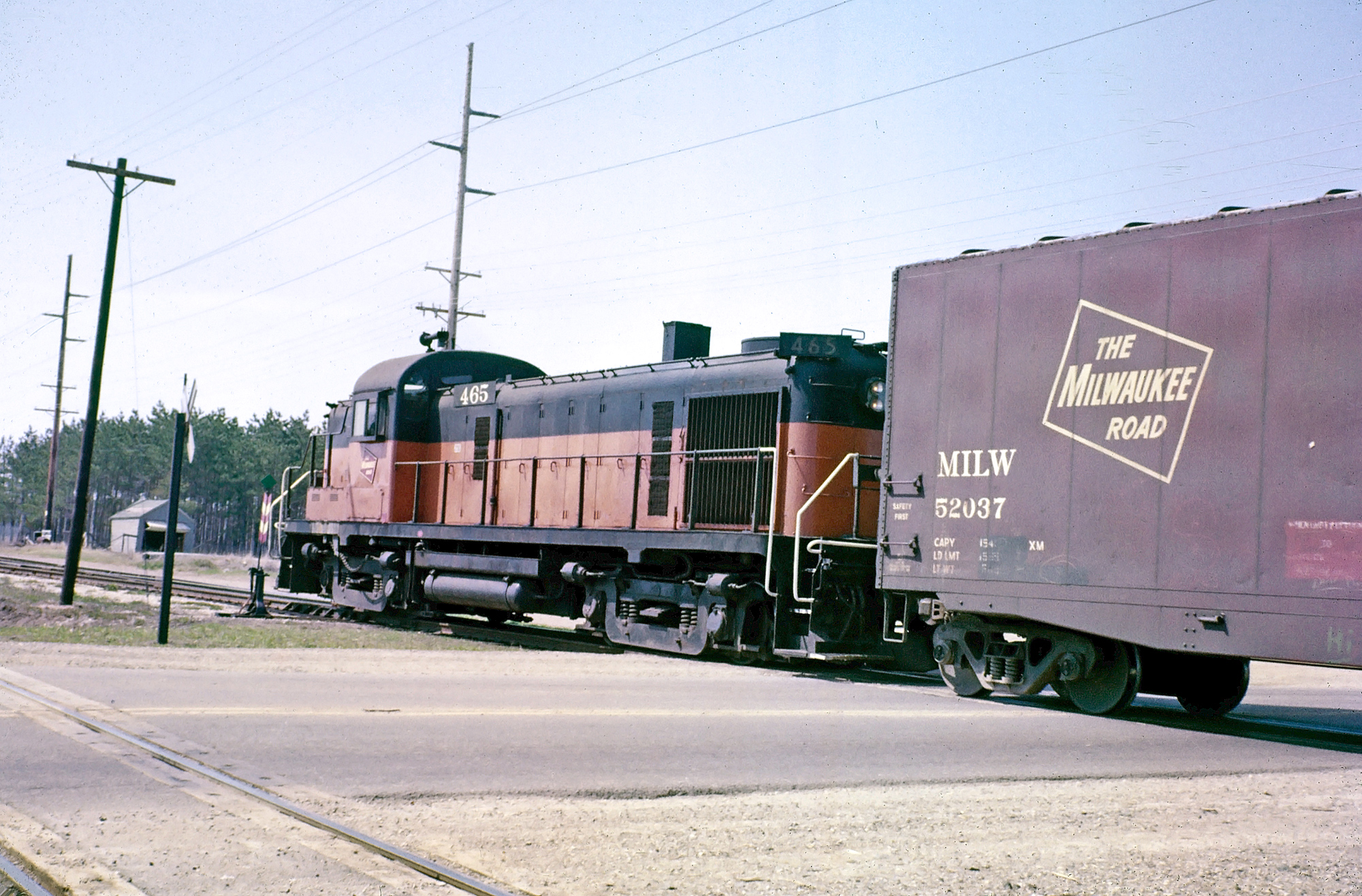 Milwaukee Road RS3 #465 works freight service on the Valley Line as the train heads south over Route 73 in Port Edwards, Wisconsin on April 24, 1974. American-Rails.com collection.
Milwaukee Road RS3 #465 works freight service on the Valley Line as the train heads south over Route 73 in Port Edwards, Wisconsin on April 24, 1974. American-Rails.com collection.Passenger Trains
Not only was the railroad famous for its electrification but also its fleet of Hiawatha trains, especially those serving the Heartland. According to Jim Scribbins' book, "The Hiawatha Story," the original trainset entered service on May 29, 1935 and was greeted by throngs of trackside patrons during its maiden run.
Not surprisingly, it was an immediate success carrying 16,564 passengers during its first six weeks and was regularly sold out.
The original version was powered by a small fleet of speedy 4-4-2's (Class A), manufactured by American Locomotive, while later more powerful 4-6-4's (Class F-7) were needed to handle the heavier equipment.
Both types could regularly reach speeds above 100 mph as they raced across the Midwest along track virtually as straight as an arrow.
The railroad's "Reduce To 90" trackside signs remain legendary to this day. As traffic slid away in the postwar years, the Milwaukee was happy to pay the entry fee into Amtrak, the national carrier that took over most intercity services on May 1, 1971.
Afternoon Hiawatha: (Chicago - Milwaukee - Twin Cities)
Arrow: (Chicago - Omaha/Sioux Falls)
Chippewa-Hiawatha: (Chicago - Channing, Michigan)
Copper Country Limited: (Chicago - Green Bay - Calumet, Michigan)
Midwest Hiawatha: (Chicago - Omaha/Sioux Falls)
Morning Hiawatha: (Chicago - Milwaukee - Twin Cities)
North Woods Hiawatha: (New Lisbon, Wisconsin - Woodruff/Star Lake, Wisconsin)
Olympian: (Chicago - Twin Cities - Seattle/Tacoma)
Olympian Hiawatha (Replaced The Olympian): (Chicago - Twin Cities - Seattle/Tacoma)
Pioneer Limited: (Chicago - Milwaukee - Twin Cities)
Sioux: (Chicago - Madison - Rapid City, South Dakota)
Southwest Limited: (Chicago/Milwaukee - Kansas City)
Tomahawk: (Chicago - Minocqua, Wisconsin)
Twin Cities Hiawatha: (Chicago - Milwaukee - Twin Cities)
Varsity/Marquette: (Chicago - Madison, Wisconsin - Mason City, Iowa)
Mismanagement
Quinn then took the proposal to the Chicago-Milwaukee Corporation board (the holding company which owned the railroad). Since they wanted nothing more then to rid themselves of the cyclical business they were very pleased with the offer.
However, one member apparently objected on the condition that the Milwaukee Land Company, which owned vast timber property in the Rocky Mountains, was too valuable to be given away for nothing. With a price tag set at $50 million BN objected, claiming it was not worth the asking price.
The railroad subsequently walked away from the entire offer (interestingly the Milwaukee would later sell its timber holdings for $125 million). These are just a few of the interesting events that took place as the company crumbled away in the 1970s.
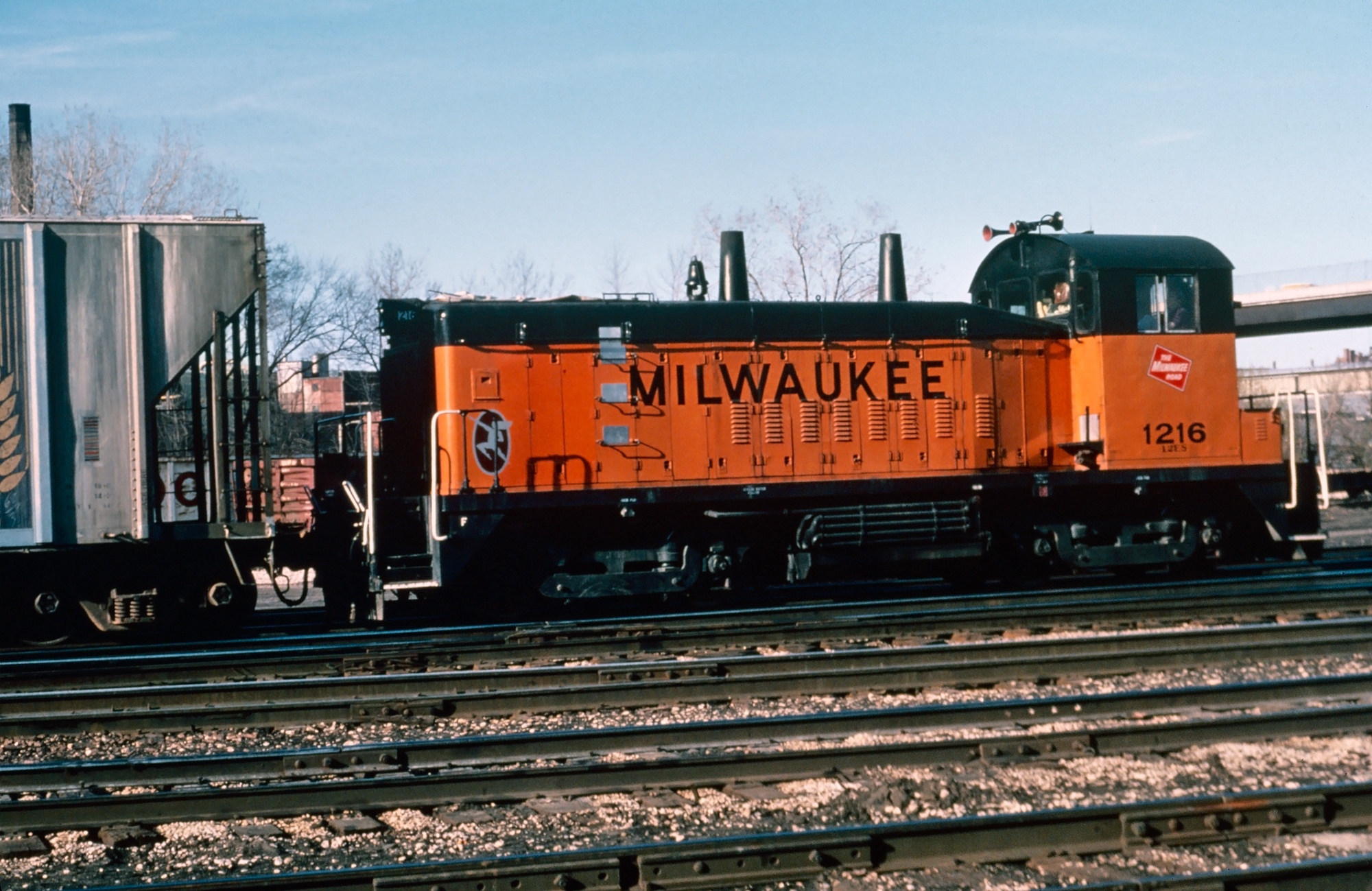 Milwaukee Road SW1200 1216 (built as #2037), already wearing its Soo Line number, was the only switcher to wear the company's "Milwaukee II" livery. It is seen here working the Miller Job at the Muskego Yard in Milwaukee, Wisconsin in April, 1986. R.W. Brown photo. American-Rails.com collection.
Milwaukee Road SW1200 1216 (built as #2037), already wearing its Soo Line number, was the only switcher to wear the company's "Milwaukee II" livery. It is seen here working the Miller Job at the Muskego Yard in Milwaukee, Wisconsin in April, 1986. R.W. Brown photo. American-Rails.com collection.All the evidence suggests that Milwaukee Road's advantageous network, stretching from the Louisville gateway (where key interchanges would have been made with the Southern Railway and Louisville & Nashville), through Chicago, and to the Puget Sound offered an incredible opportunity never fully exploited.
At the rate its management was making even the most common sense of mistakes it was simply a matter of time before the railroad fell apart.
Diesel Roster
Steam Roster (Post 1900)
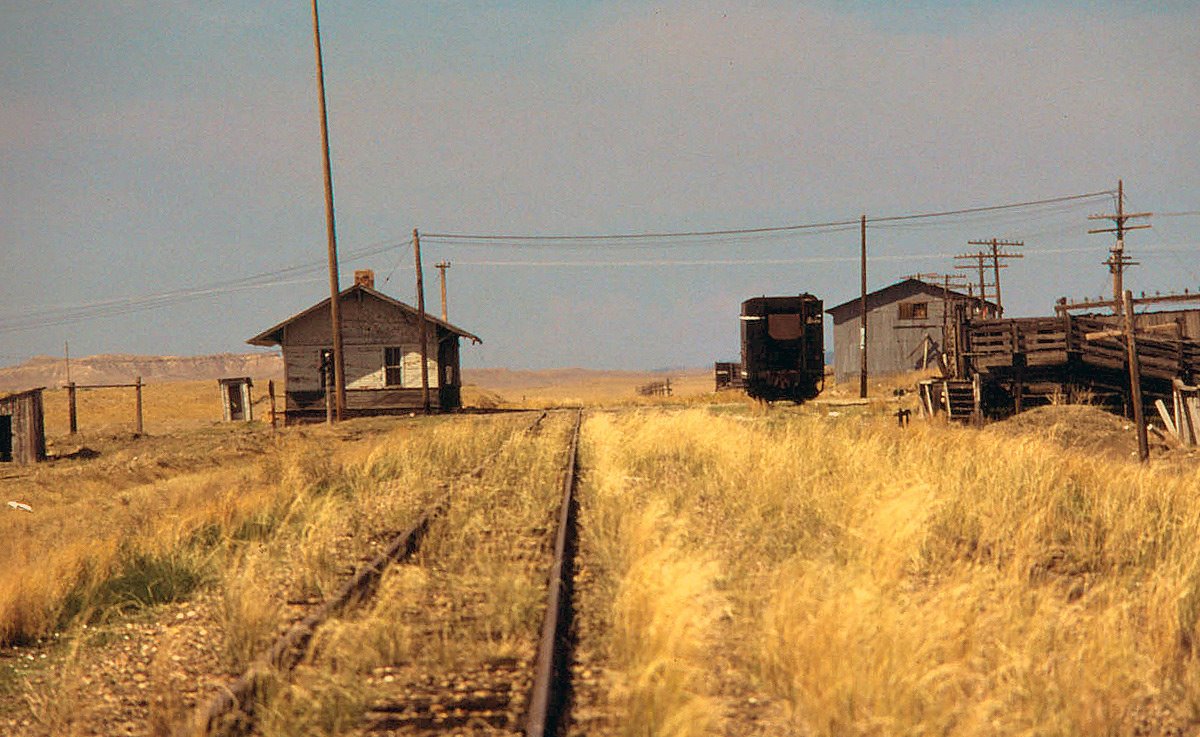 All is quiet in Ingomar, Montana during August of 1980 after the once-mighty Milwaukee Road shut down its Pacific Extension earlier that year (March). The rails now await their fate. Alan Freed and Chuck Bothwell purchased a 1952 M-19 Fairmont Speeder (for $400) to enjoy a once-in-a-lifetime trip over the abandoned corridor before its removal. Alan Freed photo.
All is quiet in Ingomar, Montana during August of 1980 after the once-mighty Milwaukee Road shut down its Pacific Extension earlier that year (March). The rails now await their fate. Alan Freed and Chuck Bothwell purchased a 1952 M-19 Fairmont Speeder (for $400) to enjoy a once-in-a-lifetime trip over the abandoned corridor before its removal. Alan Freed photo.Postscript
Perhaps the saddest part of all is that with the Milwaukee Road's retrenchment, Burlington Northern enjoyed a monopoly on Chicago-Seattle traffic, a scenario which holds true to this day under BNSF Railway. With Soo Line's purchase in 1985, the book closed on one of the country’s most interesting and dynamic railroads.
For more information about the railroad please click here to visit the Milwaukee Road Historical Association's website. Today, electrics no longer conquer St. Paul Pass on the Rocky Mountain Division or glide over Snoqualmie Pass along the Coast Division.
The fabled Pacific Extension now stands silent except for the sounds of Mother Nature and the occasional hiker who can enjoy several rail/trails created following its abandonment.
Likewise, the Midwest Hiawatha no longer paces across America’s Heartland. However, the Sprinting Indian logo lives on through the Milwaukee Road Historical Association and Amtrak continues to operate a passenger train named after the famous Native American.
The abandonment of the Chicago, Milwaukee, St. Paul & Pacific was arguably the most glaring to our national rail network; a perfectly viable transcontinental corridor torn up due to incompetence.
"What If..." By Brian Holtz and Brian Sigstad
"What If..." is a short volume by Brian Holtz and Brian Sigstad published in 2022, which discusses the possibility of a Milwaukee Road and Rock Island merger in 1958, directly after the national recession of 1957-1958 and before both companies began their slow decline into bankruptcy.
Photo Gallery
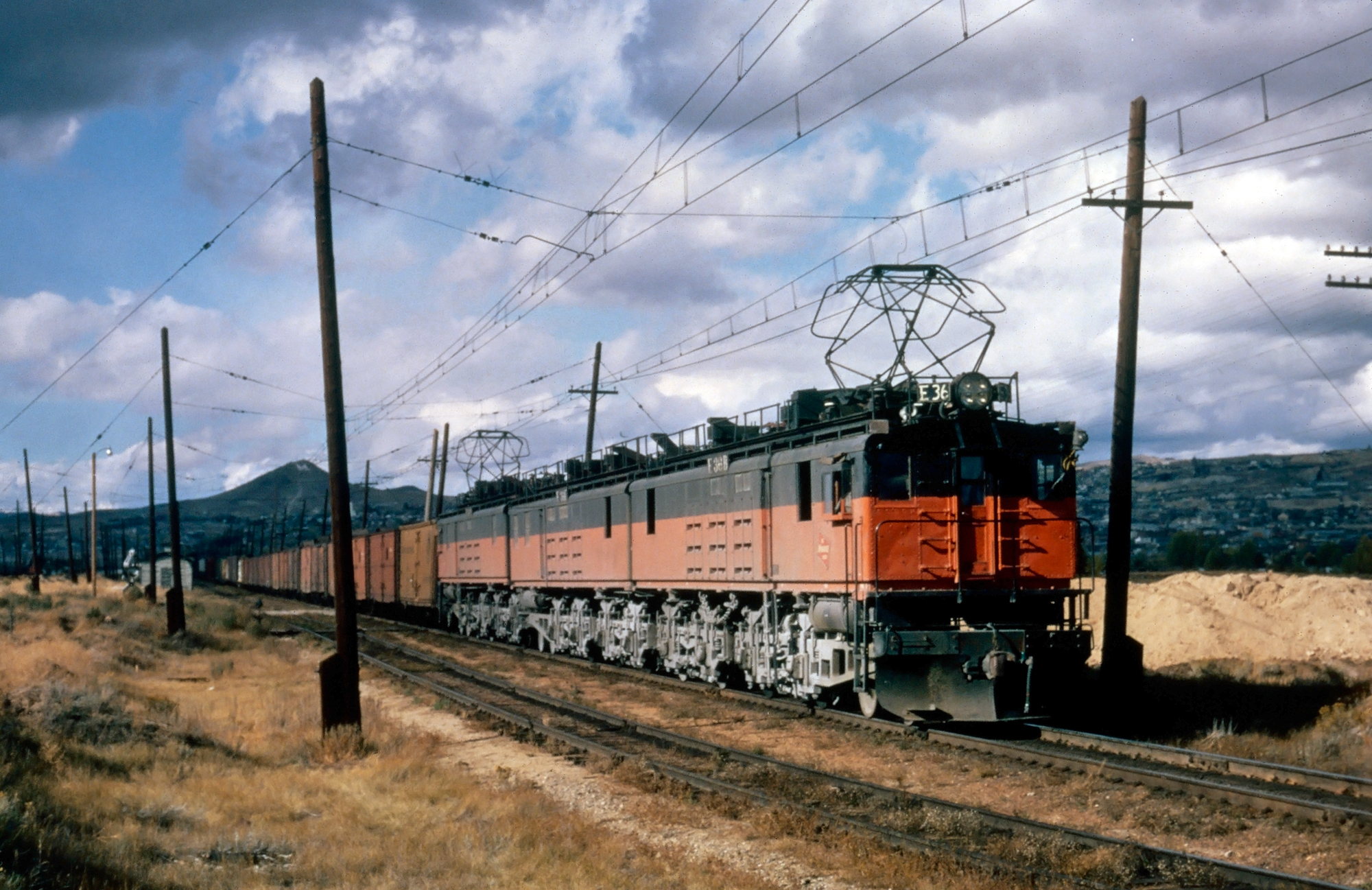 Milwaukee Road boxcab E-39 is ready to depart Butte, Montana with an eastbound freight, circa 1970. Photographer unknown. American-Rails.com collection.
Milwaukee Road boxcab E-39 is ready to depart Butte, Montana with an eastbound freight, circa 1970. Photographer unknown. American-Rails.com collection.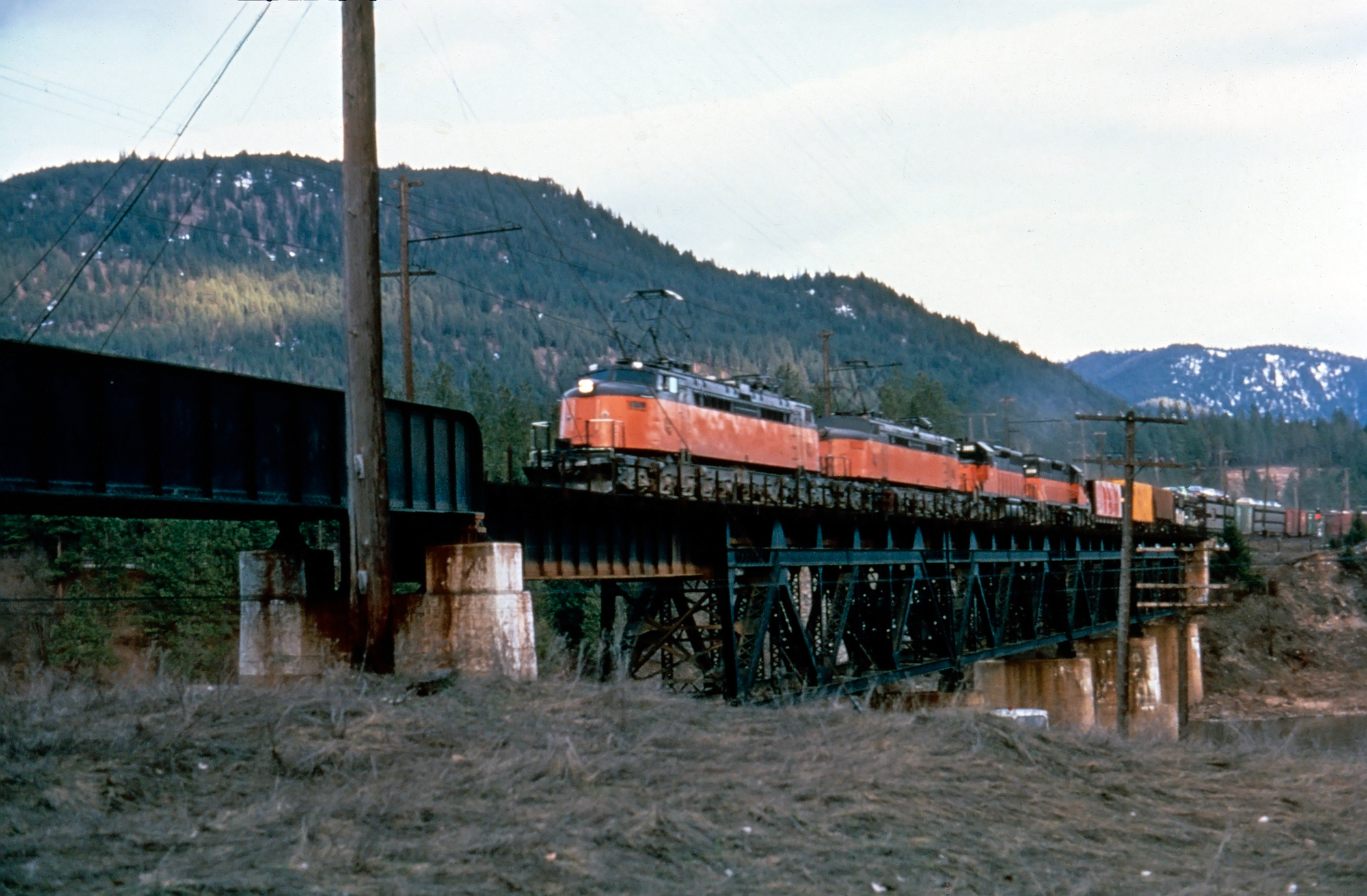 Milwaukee Road "Little Joe" E-70 leads a westbound freight across the Clark Fork River at St. Regis, Montana, circa 1973. Photographer unknown. American-Rails.com collection.
Milwaukee Road "Little Joe" E-70 leads a westbound freight across the Clark Fork River at St. Regis, Montana, circa 1973. Photographer unknown. American-Rails.com collection.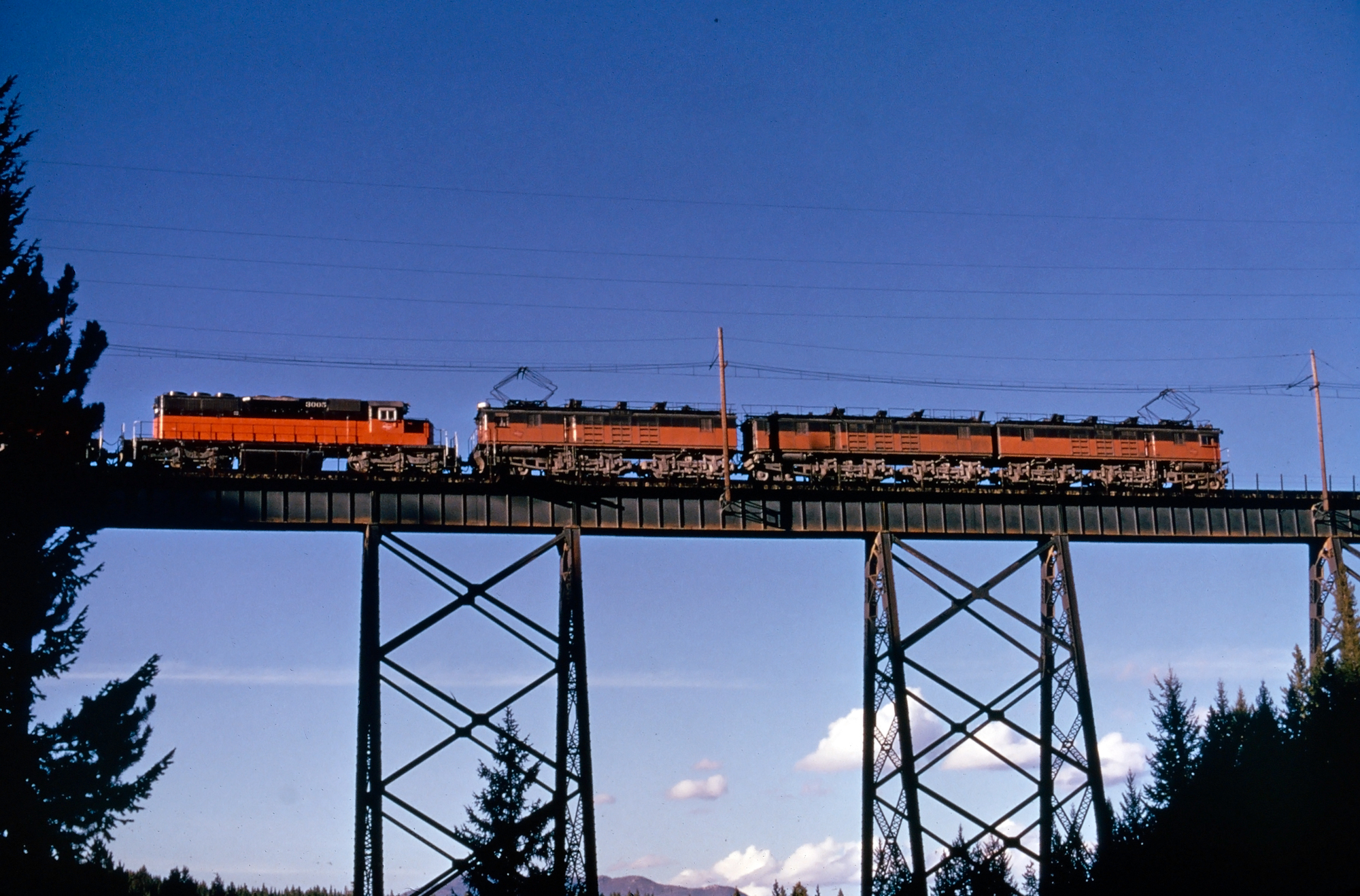 Milwaukee Road boxcab set E45 and SD40-2 #3005 lead an eastbound freight over the Blacktail Trestle on Pipestone Pass in November, 1972. Photographer unknown. American-Rails.com collection.
Milwaukee Road boxcab set E45 and SD40-2 #3005 lead an eastbound freight over the Blacktail Trestle on Pipestone Pass in November, 1972. Photographer unknown. American-Rails.com collection.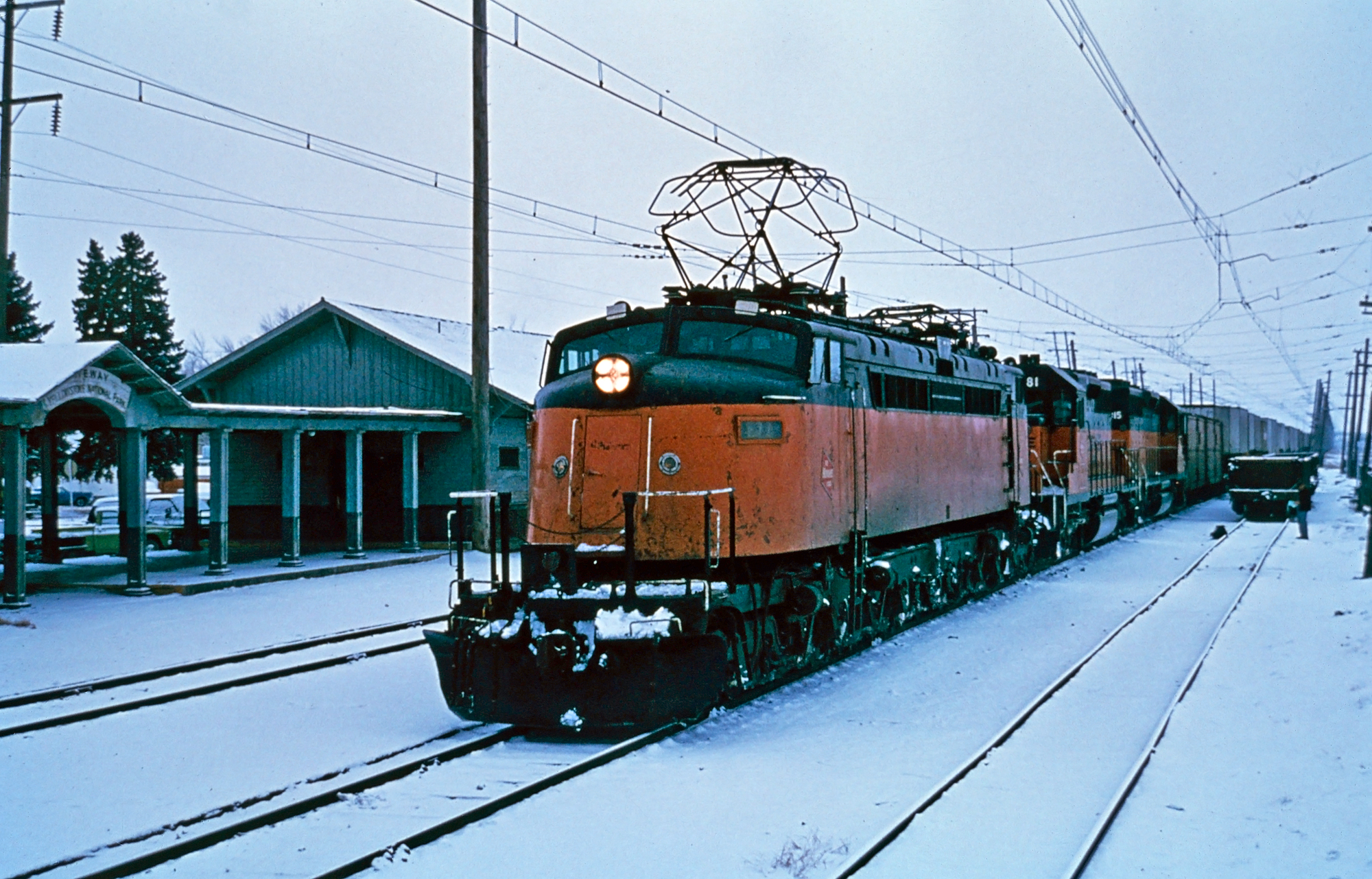 Milwaukee Road "Little Joe" E-77 leads an eastbound freight past the "Gateway To Yellowstone National Park" depot in Three Forks, Montana on January 23, 1973. Photographer unknown. American-Rails.com collection.
Milwaukee Road "Little Joe" E-77 leads an eastbound freight past the "Gateway To Yellowstone National Park" depot in Three Forks, Montana on January 23, 1973. Photographer unknown. American-Rails.com collection.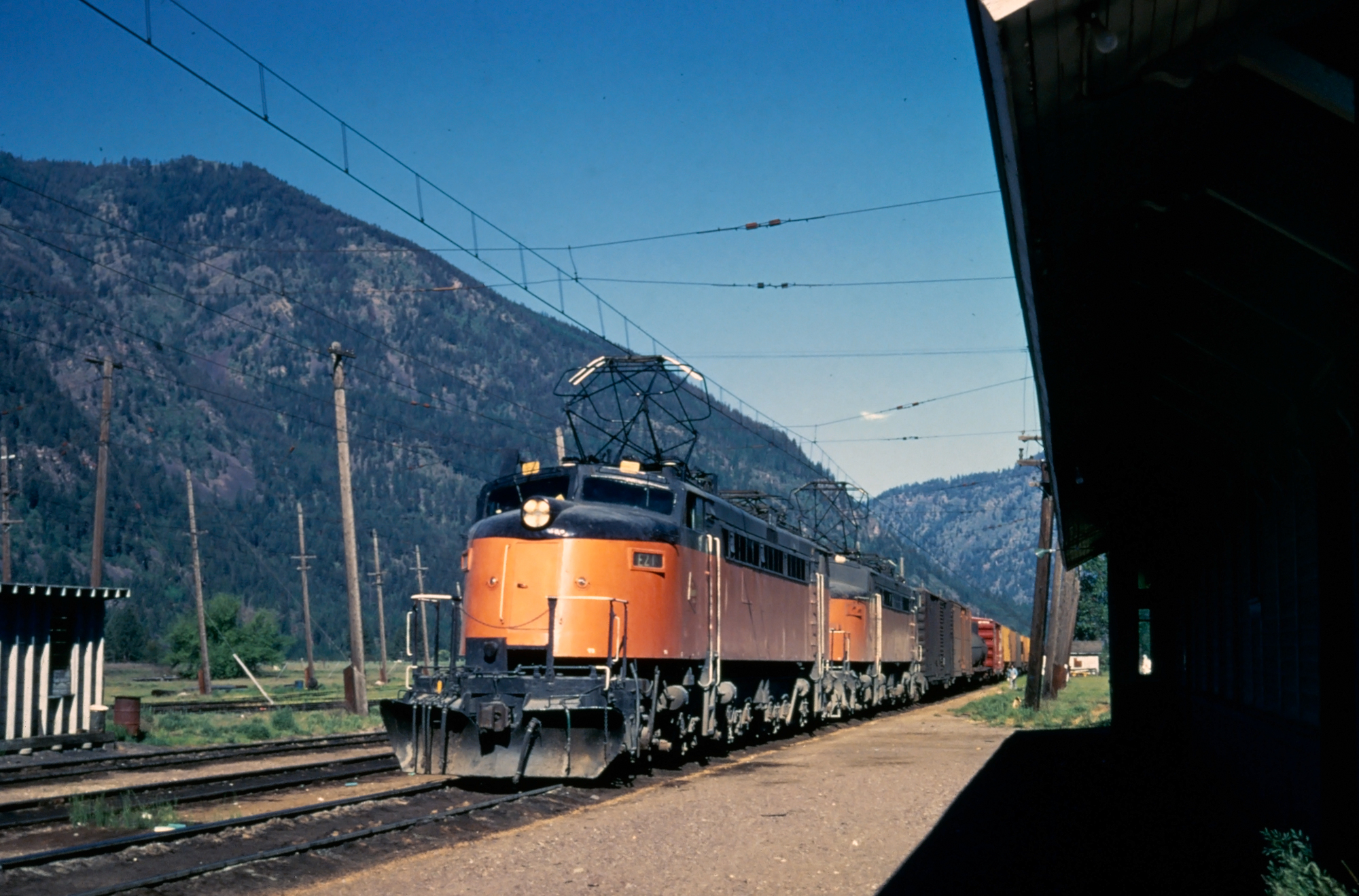 Milwaukee Road "Little Joe" E-21 has an eastbound freight train at Alberton, Montana, circa 1973. Photographer unknown. American-Rails.com collection.
Milwaukee Road "Little Joe" E-21 has an eastbound freight train at Alberton, Montana, circa 1973. Photographer unknown. American-Rails.com collection.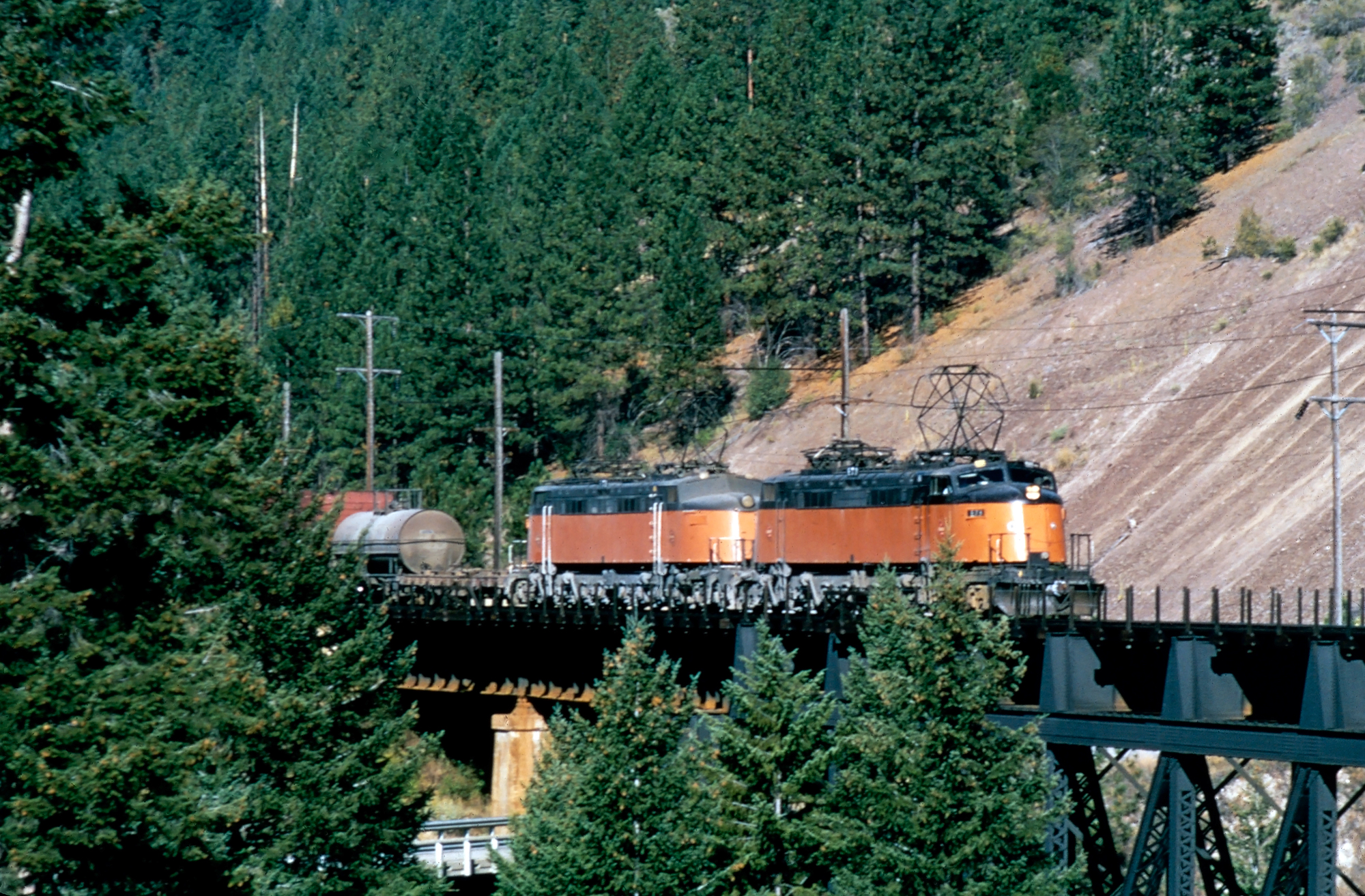 Milwaukee Road "Little Joe" E-73 with a dead freight east passing through the Alberton Gorge west of Cyr, Montana, circa 1973. Photographer unknown. American-Rails.com collection.
Milwaukee Road "Little Joe" E-73 with a dead freight east passing through the Alberton Gorge west of Cyr, Montana, circa 1973. Photographer unknown. American-Rails.com collection.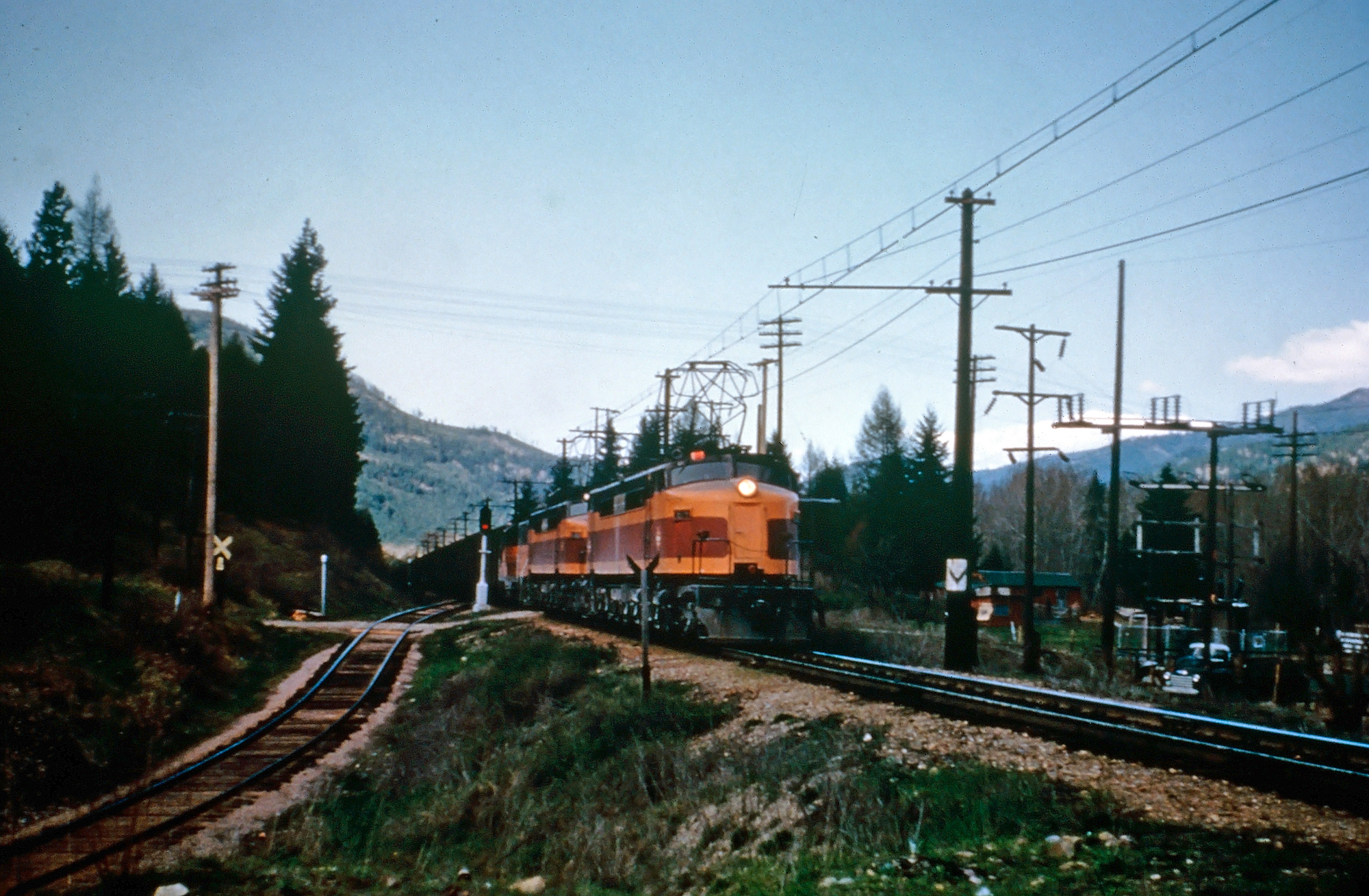 Milwaukee Road "Little Joes" and a GP9 near St. Regis, Montana circa 1958. Photographer unknown. American-Rails.com collection.
Milwaukee Road "Little Joes" and a GP9 near St. Regis, Montana circa 1958. Photographer unknown. American-Rails.com collection.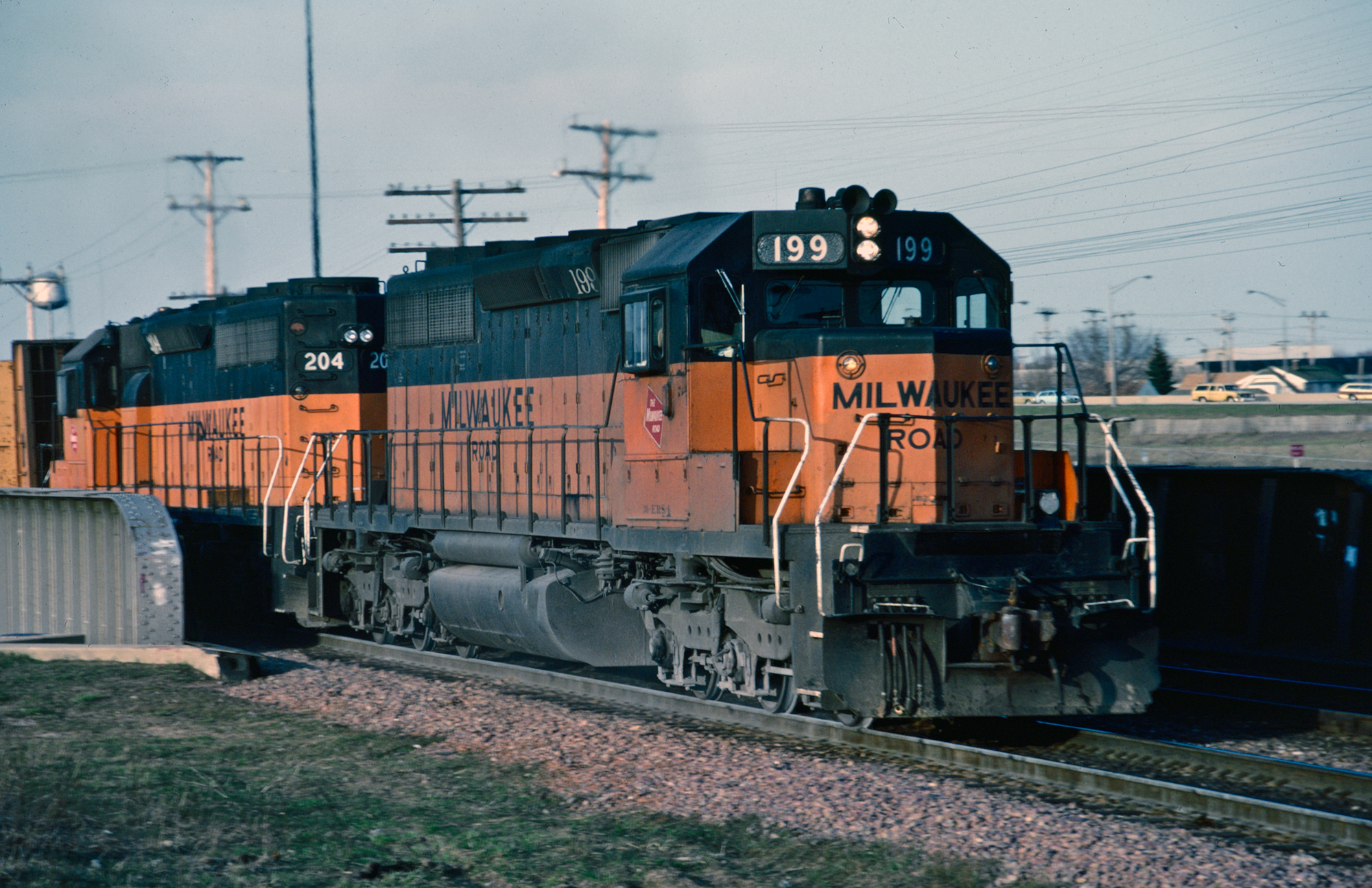 Milwaukee Road SD40-2s #199 and #204 were photographed here by Mike Sosalla in freight service in South Milwaukee, Wisconsin on April 19, 1983. American-Rails.com collection.
Milwaukee Road SD40-2s #199 and #204 were photographed here by Mike Sosalla in freight service in South Milwaukee, Wisconsin on April 19, 1983. American-Rails.com collection.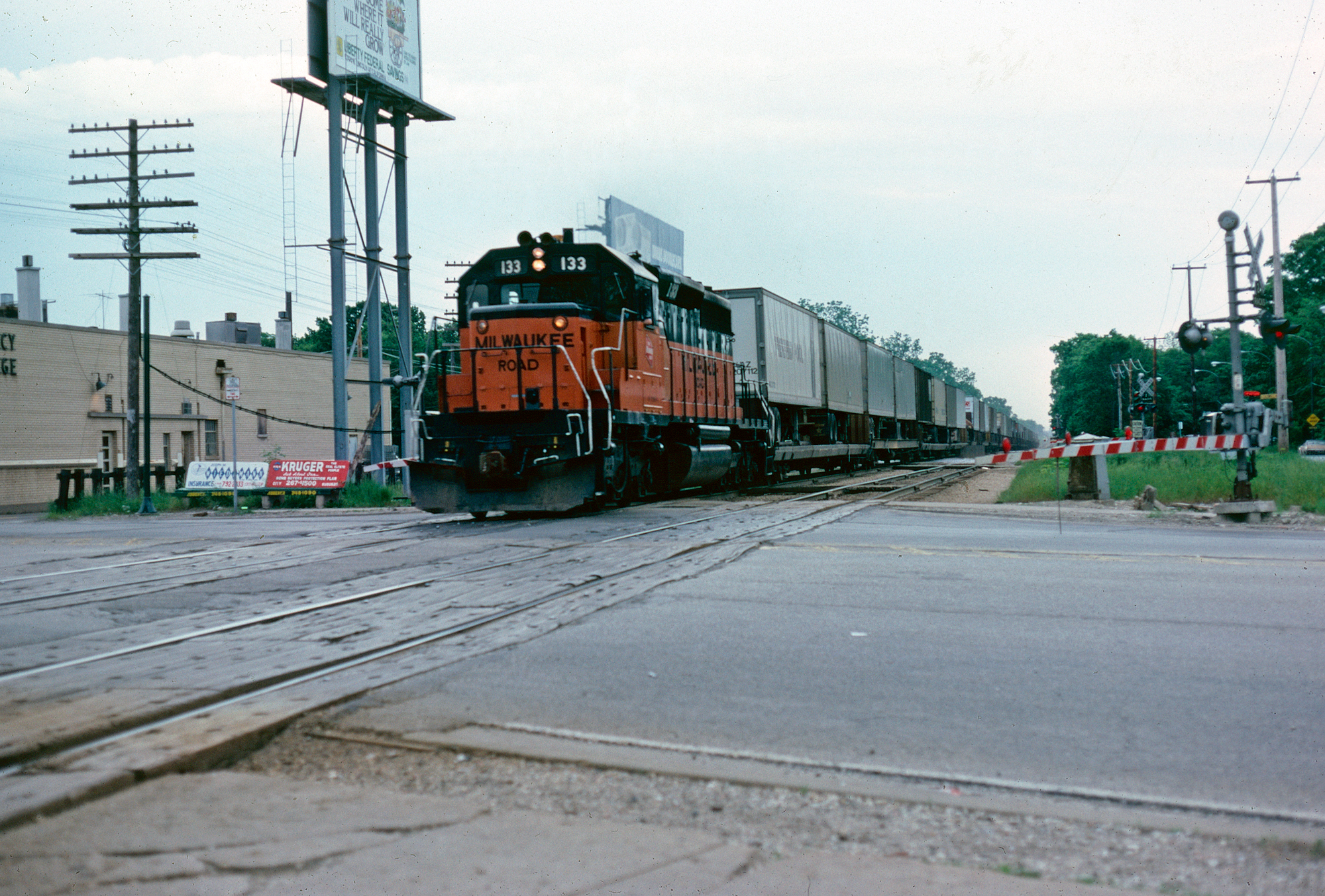 Milwaukee Road SD40-2 #133 with the "Sprint Train" at Edgebrook, Illinois on June 4, 1979. John Nixon photo. American-Rails.com collection.
Milwaukee Road SD40-2 #133 with the "Sprint Train" at Edgebrook, Illinois on June 4, 1979. John Nixon photo. American-Rails.com collection.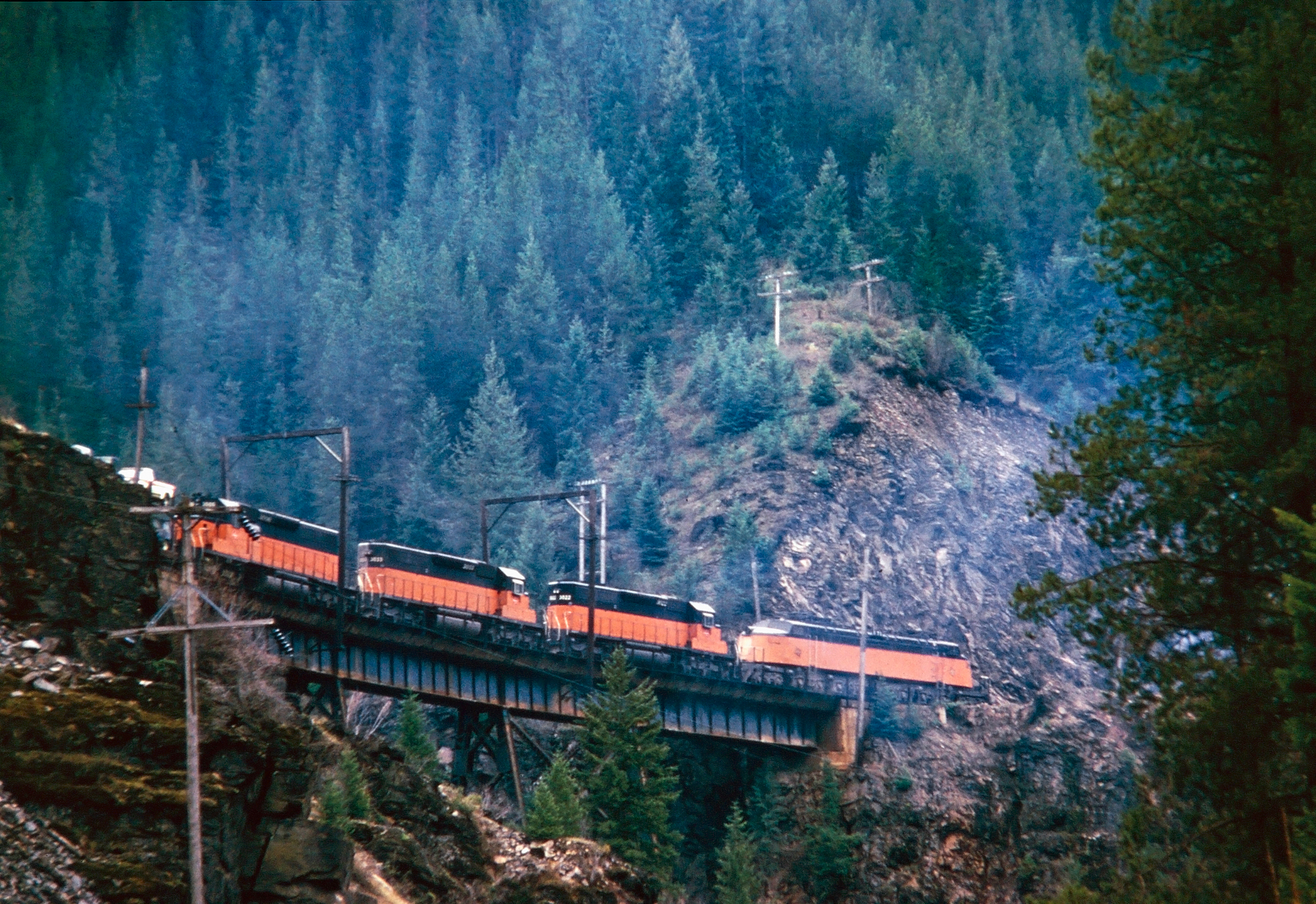 A Milwaukee Road "Little Joe" and a trio of SD40-2s lead a westbound time freight over Pee Dee Trestle in Idaho in August, 1972. American-Rails.com collection.
A Milwaukee Road "Little Joe" and a trio of SD40-2s lead a westbound time freight over Pee Dee Trestle in Idaho in August, 1972. American-Rails.com collection.Timetables (August, 1952)
Additional Sources
- Murray, Tom. Milwaukee Road, The. St. Paul: MBI Publishing, 2005.
- Ploss, Thomas. Nation Pays Again, The. Ploss (Self Published): January, 1985.
- Schafer, Mike. Classic American Railroads. Osceola: MBI Publishing, 1996.
- Scribbins, Jim. Hiawatha Story, The. Minneapolis: University of Minnesota Press, 2007.
- Scribbins, Jim. Milwaukee Road Remembered. Minneapolis: University Of Minnesota, 2008 (Second Edition).
- Solomon, Brian and Gruber, John. Milwaukee Road's Hiawatha's, The. St. Paul: Voyageur Press, 2006.
- Wood, Charles R. and Wood, Dorothy M. Milwaukee Road West. Seattle: Superior Publishing Company, 1972.
Recent Articles
-
Kansas Christmas Train Rides In Abilene!
Dec 02, 25 10:12 AM
Set in the heartland of Kansas, the Abilene and Smoky Valley Railroad (ASVRR) offers a living, breathing encounter with railroading’s golden age. Its seasonal Christmas trains are always a hit! -
Indiana Christmas Train Rides In Noblesville!
Dec 02, 25 10:06 AM
The Reindeer Express is the Nickel Plate Express’s signature holiday excursion, an immersive celebration of the season that turns a simple train ride into a moving winter postcard. -
Illinois Christmas Train Rides In Aurora!
Dec 02, 25 09:50 AM
When the Christmas season arrives, Blackberry Farm's little train takes on a starring role as the “Holiday Express”, carrying visitors through a winter wonderland of lights, music, and festive decorat…

